E-Newsletter
An update from MBP November 4, 2022 mbbeef.ca





(November 1, 2022 Province of Manitoba News Release) The Manitoba government has approved 89 projects that mitigate against future disasters under the 2022 Mitigation and Preparedness Program (MPP), Transportation and Infrastructure Minister Doyle Piwniuk announced.
“Our government is committed to supporting not only the post disaster recovery needs of municipalities, but also their capacity to prepare for future events,” said Piwniuk. “This innovative initiative, delivered through the Manitoba Emergency Measures Organization, offers an important opportunity for municipalities to build local resiliency against natural disasters, extreme weather events and the impacts of climate change.”
First introduced in 2020, the MPP opens when a disaster financial assistance (DFA) program is established for a natural disaster and the cost of the DFA program is
sufficient to be eligible for federal cost sharing arrangements.
The majority of municipalities with a claim under the 2022 Spring Flood DFA program also applied for MPP project funding, which enables municipalities to invest municipal DFA deductibles into an approved mitigation or preparedness project. Up to a maximum of $2.6 million in municipal DFA deductibles will now be used by municipalities to undertake these 89 local projects.
The MPP provides municipalities with flexibility to use deductibles for a project of their choice that builds local resiliency to natural disasters including the purchase of equipment or use of funds for a capital project. Municipalities also have the option to place funds in reserve until a project is selected.

 Manitoba Beef Producers visited Deloraine on November 3 for a district meeting and update to producers. Pictured on the television screen is Jennifer Babcock (Senior Director, Government and Public Affairs, Canadian Cattle Association) who joined Carson Callum (MBP eneral Manager, standing) and Alfred Epp (District 1 Director, seated, far right). The final in-person meeting will be in Dauphin on November 7 followed by a virtual district meeting open to all producers on November 8. For more information, please visit https:// mbbeef.ca/events/2022-district-meetings/. (Photo credit: Melissa Atchison)
Manitoba Beef Producers visited Deloraine on November 3 for a district meeting and update to producers. Pictured on the television screen is Jennifer Babcock (Senior Director, Government and Public Affairs, Canadian Cattle Association) who joined Carson Callum (MBP eneral Manager, standing) and Alfred Epp (District 1 Director, seated, far right). The final in-person meeting will be in Dauphin on November 7 followed by a virtual district meeting open to all producers on November 8. For more information, please visit https:// mbbeef.ca/events/2022-district-meetings/. (Photo credit: Melissa Atchison)
“We commend the Manitoba government for investing in 89 municipal projects under the 2022 MPP. We also commend municipalities for participating in this important program and investing in projects to help our communities become more resilient,” said Kam Blight, president, Association of Manitoba Municipalities. “As municipalities cannot fight extreme weather events alone, this funding support will not only help build local resiliency but also help municipalities better prepare and invest in disaster mitigation infrastructure to avoid costly damages in the future.”
The Manitoba government is proud to support innovative projects such as flood risk mapping along the La Salle River, water retention partnerships with watershed districts, dike enhancements in areas along Lake Winnipeg, relocating public and private infrastructure susceptible to repeat flooding, and equipment for training volunteers to be prepared during an event, the minister noted. Other common projects include raising roads, enhancing culvert design, and purchasing generators, water pumps, and culvert steamers.
For more information about the MPP, visit: https://gov.mb.ca/emo/mitigation/mpp.html

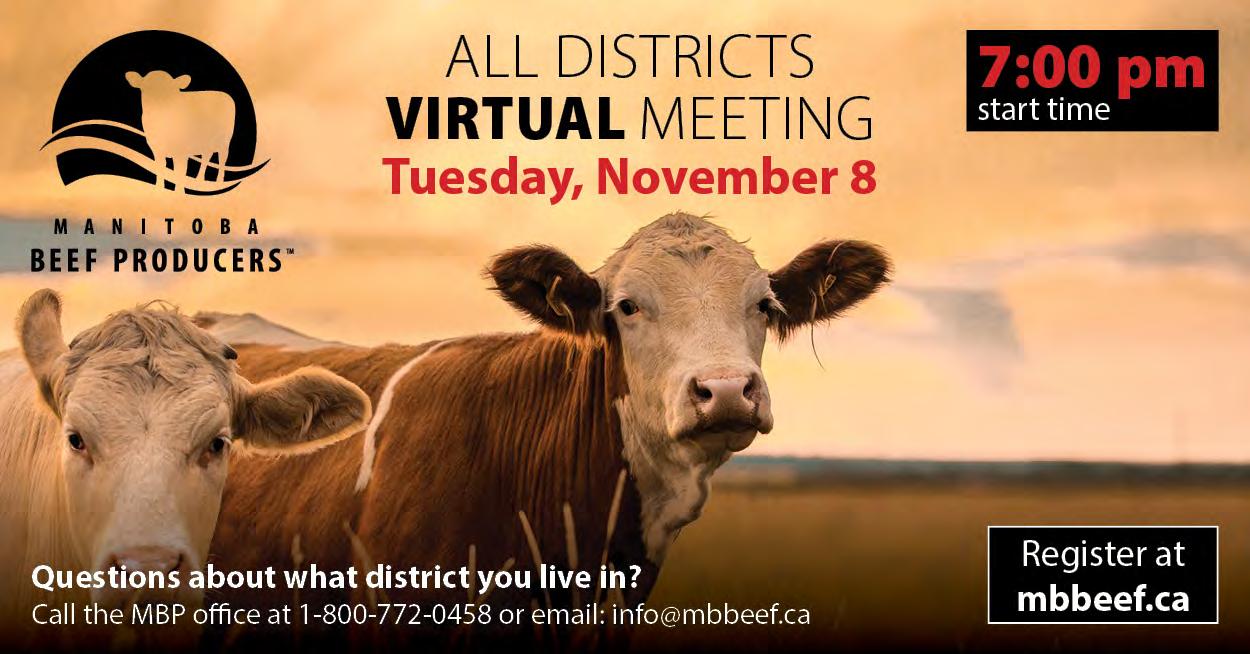
Municipality of Emerson-Franklin: up to a maximum of $20,629.21 for sewer lift station generators for Dominion City and Emerson;
Rural Municipality of Montcalm: up to a maximum of $10,818.27 for a reserve fund;
Rural Municipality of Ritchot: up to a maximum of $63,225.09 for a reserve fund;
Municipality of Clanwilliam-Erickson: up to a maximum of $8,566.58 to expand drainage capacity by installing additional culverts in rural areas;
Rural Municipality of Cornwallis: up to a maximum of $38,668.12 to study high-water levels on Lake Clementi to provide options for long-term solutions;
Municipality of Harrison Park: up to a maximum of $15,677.18 to change main lift station to a submersible pump;
Town of Minnedosa: up to a maximum of $23,202.57for aflood mitigation study;

Rural Municipality of Minto-Odanah: up to a maximum of $9,489.27 for water retention structures;
Rural Municipality of Mountain: up to a maximum of $8,295.70 for a reserve fund;
Town of Neepawa: up to a maximum of $48,123.53 for the replacement and relocation of public infrastructure subject to flooding;
Rural Municipality of Rosedale: up to a maximum of $12,900.66 for a sandbagging machine and safety signage;
Rural Municipality ofWhitehead: up to a maximum of $14,212.74 for larger culverts, beaver cages, and a generator for a reception centre;
Rural Municipality of Yellowhead: up to a maximum of $15,584.07 to develop a drainage plan;

City of Morden: up to a maximum of $84,048.99 to increase the capacity of the Parkhill Street Bridge on Dead Horse Creek;
Rural Municipality of Alexander: up to a maximum of $32,624.00 for an engineering study to evaluate raising existing dikes/building newdikes to protect Hillside Beach area and Victoria Bay Estates;
Rural Municipality of East St. Paul: up to a maximum of $82,322.13 for a municipal land drainage study;
Rural Municipality of La Broquerie: up to a maximum of $56,927.13 for an emergency generator;
Rural Municipality of Louise: up to a maximum of $17,141.63 for adrainage study near Pilot Mound;
Rural Municipality of Morris: up to a maximum of $25,809.79 for road improvements to raise Road 2E (Riverside Road);
Rural Municipality of Piney: up to a maximum of $15,601.00 for road improvements to raise Road 81E south of Sprague;
Rural Municipality of Portage la Prairie: up to a maximum of $58,306.92 for a reserve fund;
Rural Municipality of Rhineland: up to a maximum of $49,257.84 for equipment purchases to monitor Border Road duringflood events;
Village of St-Pierre-Jolys: up to a maximum of $11,046.83 for the third phase of the northwest storm sewer upgrades;
Rural Municipality of Thompson: up to a maximum of $12,849.87 to hire a consultant to study drainage issues in Miami;
Rural Municipality ofWoodlands: up to a maximum of $32,141.61fora drainage improvement feasibility study for the town of Warren;
Town of Altona: up to a maximum of $36,120.16 to expand the existing northwest storm drainage ditch;
Rural Municipality of Souris-Glenwood: up to a maximum of $21,560.36 for a reserve fund for future improvements of drainage systems;
City of Selkirk: up to a maximum of $88,916.36 for a structural assessment of the Selkirk wharf, a land drainage study and masterplan and public education supplies;
Rural Municipality of Argyle: up to a maximum of $8,414.21 for a reserve fund;
Rural Municipality ofWest Interlake: up to a maximum of $18,860.02 for a reserve fund;
Rural Municipality of Grey: up to a maximum of $21,306.41 for a reserve fund;
Town of Teulon: up to a maximum of $10,124.14 for emergency operations centre equipment, safety equipment, tractor pumps and hoses and training;
Rural Municipality of Dufferin: up to a maximum of $21,526.50 to rip rap culverts;
Rural Municipality of Grahamdale: up to a maximum of $10,818.27 for 3.5 miles of road survey for initial flood mitigation strategy development;
Rural Municipality of Ellice-Archie: up to a maximum of $7,034.42 for a reserve fund;
Rural Municipality of Stanley: up to a maximum of $76,024.17 for agenerator for municipal offices;
Rural Municipality of St. Francois Xavier: up to a maximum of $12,265.79 for culvert/drain upgrades in high risk areas;
Municipality of Mossey River: up to a maximum of $12,274.25 for an enclosed trailer for a culvert steamer;
Municipality of Norfolk Treherne: up to a maximum of $14,983.05forthe Alberni flood prevention project;
Municipality of Glenboro-South Cypress: up to a maximum of $9,506.20 for an alarm system for the lift station and lagoon;
Rural Municipality of Coldwell: up to a maximum of $11,114.55 for drainage upgrades;
Rural Municipality of Gimli: up to a maximum of $55,606.59 for larger capacity pumps;
Municipality of GilbertPlains: up to a maximum of $12,020.30 for a reserve fund;
Rural Municipality of Roland: up to a maximum of $9,692.43 to raise Arctic Road;
Rural Municipality of Armstrong: up to a maximum of $16,650.66 for an enclosed trailer for a culvert steamer;
Rural Municipality of Hanover: up to a maximum of $145,733.44 for water pumps;
Rural Municipality of Victoria: up to a maximum of $10,056.42 to undertake drainage work with the RedboineWatershed District;
Municipality of North Norfolk: up to a maximum of $33,140.48 for a reserve fund;
Municipality of Rockwood: up to a maximum of $71,444.60 for the purchase of pumps, undertaking road improvements, and completing road 88N ditching project;
Municipality of Bifrost-Riverton: up to a maximum of $28,103.80 for pumps and a pump trailer;
Town of Powerview-Pine Falls: up to a maximum of $10,488.14 fora reserve fund;
Rural Municipality of Riding MountainWest: up to a maximum of $12,206.53 for a reserve fund;
Municipality of Swan ValleyWest: up to a maximum of $23,354.94 for a reserve fund;
Municipality of Minitonas-Bowsman: up to a maximum of $13,433.96 for a reserve fund to increase the culvert size at NW10-35-26W1;
Municipality of Ethelbert: up to a maximum of $5,485.32 for a culvert steamer;
Rural Municipality of De Salaberry: up to a maximum of $33,165.87 for a reserve fund;
Municipality of Glenella-Lansdowne: up to a maximum of $9,590.85 for a reserve fund;
Village of Dunnottar: up to a maximum of $8,371.89 for a reserve fund;
Rural Municipality of St. Andrews: up to a maximum of $99,235.20 for a reserve fund for future dike repair;
Municipality of Deloraine-Winchester: up to a maximum of $12,511.27 for a reserve fund;
Rural Municipality of Victoria Beach: up to a maximum of $5,832.39 for the purchase of a skid steer to deliver materials for dike repairand maintenance;
Rural Municipality of Lac du Bonnet: up to a maximum of $30,160.80 for a reserve fund;
City of Dauphin: up to a maximum of $70,835.12 for a reserve fund;
Rural Municipality of Brokenhead: up to a maximum of $45,829.51 for rip rap at selected sites;
Municipality of Oakland-Wawanesa: up to a maximum of $14,881.47 for a reserve fund;
Municipality of Roblin: up to a maximum of $26,148.39 for a generator;
Rural Municipality of Dauphin: up to a maximum of $18,081.24 for a reserve fundfor future road raising;
Rural Municipality of Lakeshore: up to a maximum of $10,039.49 for a reserve fund;
Rural Municipality ofWhitemouth: up to a maximum of $13,797.95 for culvert upgrades;
Municipality of Prairie View: up to a maximum of $18,292.87 for a reserve fund;
Municipality of McCreary: up to a maximum of $6,331.82 for a reserve fund to purchase generators, undertake lagoon repairs, and undertake sewer line replacement;
Municipality of Pembina: up to a maximum of $20,366.79 for a culvert steamer with covered trailer;
Rural Municipality of Alonsa: up to a maximum of $10,242.65 for adiesel water pump;
Municipality of Grassland: up to a maximum of $13,400.10 for emergency response supplies;
Municipality of Rossburn: up to a maximum of $8,236.45 for a portable generator;
Rural Municipality of Cartier: up to a maximum of $28,306.96 for a reserve fundfor a generator;
Rural Municipality ofWest St. Paul: up to a maximum of $56,563.13 for upgraded culvert capacity;
Rural Municipality of MacDonald: up to a maximum of $68,735.80 for one-in-200-year flood risk mapping on the La Salle River;
Rural Municipality of Headingley: up to a maximum of $36,661.92 for a reserve fund for the Dodd's Road Flood Mitigation Project;
Rural Municipality of Springfield: up to a maximum of $136,642.03 for a reserve fund;
Municipality of Ste Rose: up to a maximum of $13,467.82 for a reserve fund;
Municipality of Ste. Anne: up to a maximum of $47,268.56 for a drainage project with the Seine Rat RoseauWatershed District;
Municipality of Cartwright-Roblin: up to a maximum of $11,309.24 for a reserve fund;
Rural Municipality of Oakview: up to a maximum of $16,320.52 to purchase pumps to assist with heavy rain events;
Rural Municipality of St. Laurent: up to a maximum of $13,053.03 for a reserve fund;
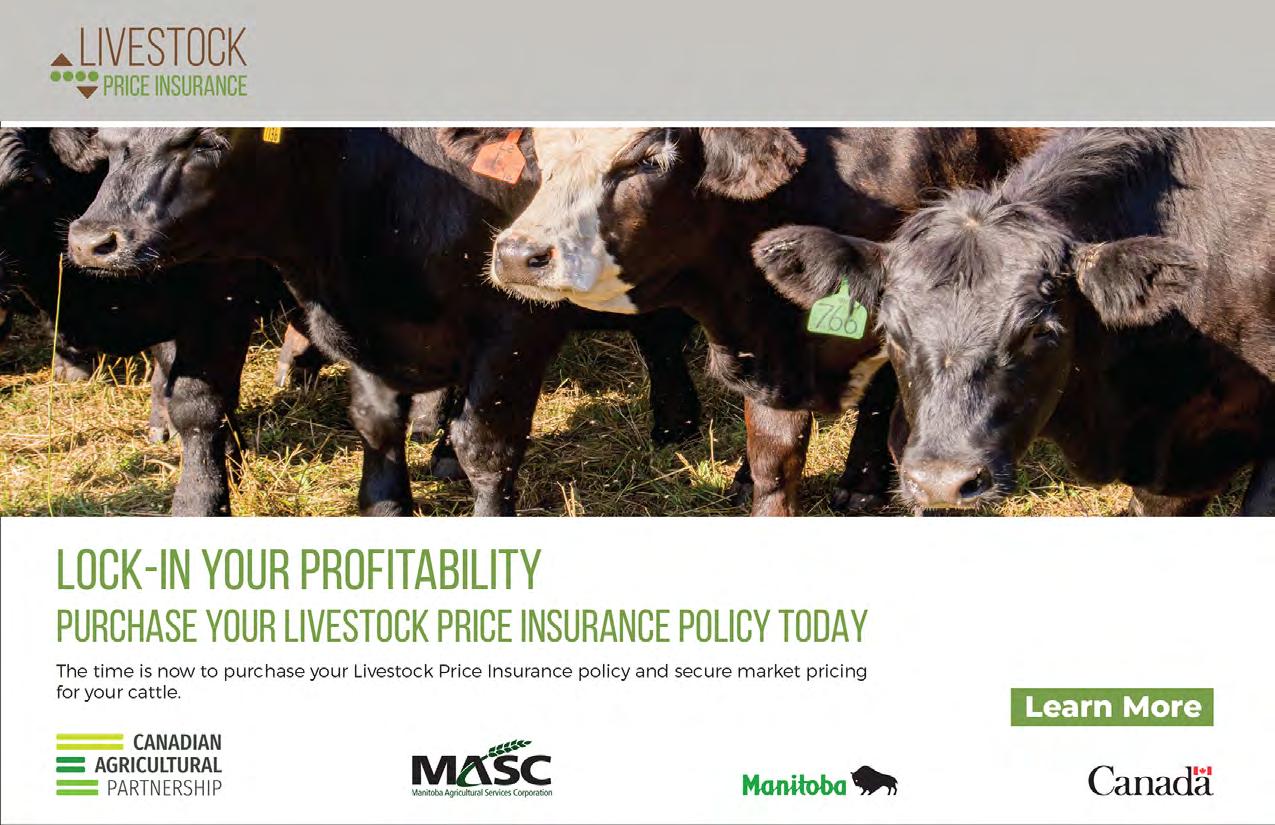
Rural Municipality of St. Clements: up to a maximum of $98,075.49 for a reserve fund for flood mitigation equipment;
Municipality of North Cypress-Langford: up to a maximum of $25,488.12for a reserve fund intendedfor bridge enhancements;
Town ofWinnipeg Beach: up to a maximum of $12,181.14 for a reserve fund; and
Town of Arborg: up to a maximum of $10,826.74 for the purchase of flood tubes.
(November 4, 2022 Province of Manitoba News Release) The Manitoba government has passed legislation amending the Environment Act to give Manitobans the choice to be able to purchase and use cosmetic pesticides on their lawns that are already registered with Health Canada and, out of an abundance of caution, the list of sensitive areas that would be protected from the application of these products has been expanded, Environment, Climate and Parks Minister Jeff Wharton announced.
“Our government is committed to protecting the environment and we rely on science to inform the proper use of cosmetic pesticides. We recognize Health Canada as the foremost expert in this field to evaluate pesticides used in Manitoba,” said Wharton. “Pesticides registered with Health Canada go through a rigorous review process that assesses the risk of pesticides to human health, animal health and the environment, and must meet strict health and safety measures. Manitoba will continue to rely on Health Canada to evaluate pesticide products and all pesticides sold and used in Manitoba must be federally registered under the Pest Control Products Act.”
Manitoba still has the strictest pesticide regulations among the Prairie provinces by prohibiting cosmetic pesticide use in sensitive areas, the minister noted.
“By expanding the list of sensitive areas, our government continues to protect children and pets, while keeping communities safe and minimizing environmental impact. These protected areas include schools, hospitals, child care centres, provincial parks, designated municipal picnic areas, playgrounds and dog parks,” said Wharton.
To understand better the experience of Manitobans with previous cosmetic pesticide restrictions, which were put in place in 2015, the Manitoba government launched a public consultation. More than 60 per cent of respondents indicated restrictions on the sale and usage of pesticides for cosmetic use were too strict and over 70 per cent of respondents wanted restrictions reduced or rescinded.
Municipalities have reported the previous approach added unnecessary costs because of repeated applications. Municipalities and other stakeholders asked for greater flexibility to have useable, aesthetic green spaces in communities, noted Wharton. The legislation allows the use of all Health Canada registered cosmetic pesticides in low risk areas like boulevards, sidewalks, right of ways and fairgrounds. Manitobans will also have the ability to apply all pesticides registered with Health Canada on their lawns.
“The Association of Manitoba Municipalities welcomes the Manitoba government’s decision to align with federal regulations and rigorous Health Canada review processes,” said Kam Blight, president, Association of Manitoba Municipalities. “These legislative changes will allow municipalities to effectively manage weed control programs while mitigating financial pressures on municipal budgets.”
“Our greenspaces contribute to our quality of life and produce enormous environmental benefits, but are continually threatened by extreme climate conditions and invasive species,” said Chad Labbe, president, Manitoba Nursery Landscape Association. “It is essential as green industry professionals, that we have choices when selecting the best products available to protect these valuable landscapes. The new regulations will encourage innovation and allow more options when deciding how to deal with pests that threaten our landscapes.”
Health Canada can initiate a special review at any time if and when new research emerges that identifies risks from pesticides where is reasonable grounds to believe that health or environmental risks, or the value of a pesticide are no longer acceptable, the minister noted.
When using pesticides and chemicals, consumers should follow directions and only use products for intended purposes, the minister added. More information on safe pesticide use is available through Health Canada at www.canada.ca/en/health canada/services/about pesticides/use pesticides safely.html.
November 3, 2022
Today, the Deputy Prime Minister of Canada, the Honourable Chrystia Freeland, released the 2022 Fall Economic Statement, which focused on making life more affordable for Canadians.
There was nothing substantial or specific mentioned for our sector. As this is a statement and not a full budget, we weren’t expecting to see significant spending, especially given talks of a looming recession. However, looking more broadly at the statement and what could be applied to agriculture, there are a few areas to highlight:
Hurricane Fiona Relief: The federal government is providing $1 billion for Hurricane Fiona Relief. The government is still determining the eligibility criteria for infrastructure; these discussions will also include affected provinces. The Canadian Cattle Association (CCA) is looking into how these funds can help support impacted cattle producers
Transportation Supply Chain Resilience: Following the Supply Chain Task Force’s recommendations from earlier this fall, the federal government is focused on making significant improvements As our sector relies on stable supply chains, we’re pleased to see a call out for “streamlining regulatory practices that impact the flow of goods through our international gateways,” amongst other recommendations.
Filling Labour Shortages: To address ongoing application backlogs, speed up processing, and allow for skilled newcomers to fill critical labour gaps faster, the government has committed an additional $50 million in 2022 23 for Immigration, Refugees, and Citizenship Canada.
Affordability for Canadians emerged as a key theme, with food specifically mentioned throughout the document. As food producers, our sector is essential in both global and domestic food security discussions, and we will look to advocate specifically on our policy priorities through this lens.
We are continuing our review of the statement for where cattle producers may be impacted. CCA will continue to highlight how the Canadian beef sector can remain an economic and environmental partner in our discussions with Parliamentarians
The full Fall Economic Statement can be found here: https://budget.gc.ca/fes eea/2022/home accueil en.html
For further information, contact: Michelle McMullen
Communications Manager Canadian Cattle Association 403-451-0931| mcmullenm@cattle.ca
The Canadian Cattle Association is the national voice for Canada’s beef cattle industry representing 60,000 beef farms and feedlots www.cattle.ca

According to the 2021 study of ‘Farmer Mental Health in Canadian’ done by the University of Guelph; 1 in 4 Canadian Farmers felt that their life was not worth living, wished they were dead, or thought of taking their own life in the last 12 months.
The Do More Agriculture Foundation champions mental health and well-being for Canadian agriculture producers. Executive Director Megz Reynolds says "The needle has moved regarding mental health in agriculture it still has a long way to go before we are no longer loosing community member's to death by suicide. It is on each and everyone of us to work together to end the stigma surrounding mental health and change the culture, this starts with self education and by joining the conversation."
AHEM is pleased to partner The Do More Agriculture Foundation in delivering a 1-hour live virtual webinar focused on mental health in agriculture.
When: November 15th, repeated on January 17 and March 21 Time: 9 AM PST/10 AM MST/11 AM CST/1 PM AST/1:30 PM NST
The workshop, delivered by Megz Reynolds, is designed to introduce participants to mental health in agriculture, highlight how to support ourselves and others, the importance of refilling our own cups and how to have conversations about mental health. This will be a “hands on” workshop with group exercises to engage participants and practice having conversations.
Visit www.animalhealth.ca/workshops today to register for the date that works best for you. There is no cost to attend!

On October 6, 2022 the federal and provincial governments announced Manitoba producers will receive higher Excess Moisture Insurance (EMI) coverage levels as part of the AgriInsurance program for the 2023 crop year.
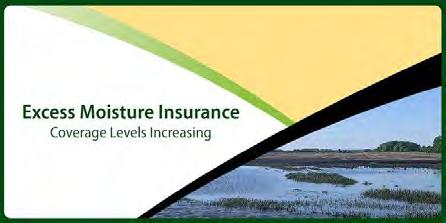
Basic EMI coverage is a standard feature of the AgriInsurance program that provides protection against the inability to seed due to wet conditions. Producers can choose increased coverage options at higher premiums. Since 2000, basic EMI coverage has been $50 per acre, while higher coverage options increased in 2014 to $75 and $100 per acre. For 2023, basic coverage will increase to $75 with higher coverage options increasing to $100 and $125.
These changes were made in consultation with producer groups that have expressed interest in higher coverage levels due to rising farming costs. The province’s share of premiums for the 2023 EMI program is estimated to be $8.6 million. At the time of the October 6th announcement it was noted that MASC would be sending EMI confirmation letters to all existing AgriInsurance clients later in October to reflect the new coverage levels and premiums. Producers have until Nov. 30 to make changes to their EMI coverage for 2023 by contacting a MASC Service Centre.
Under the Canadian Agricultural Partnership, AgriInsurance premiums for most programs are shared 40 per cent by participating producers, 36% by the federal government and 24% by the Manitoba government. Administrative expenses are paid 60% by Canada and 40% by the Manitoba government.
For more information on EMI, see: https://www.masc.mb.ca/masc.nsf/program_exces s_moisture.html
(November 4, 2022 Province of Manitoba News Release) Manitoba Municipal Relations reminds all Manitobans that daylight saving time will end in Manitoba early Nov. 6 when clocks will be set back one hour.
Under the Official Time Act, daylight saving time ends on the first Sunday in November and resumes the second Sunday in March.
The official time change back to standard time will occur this year at 2 a.m., Sunday, Nov. 6 at which time clocks should be set back to 1 a.m.

Many Manitobans have deeply held views on biannual time changes, and other jurisdictions across Canada and internationally are examining how time change relates to wellness, economic factors and relationships with trading partners.
The Manitoba government will continue to monitor these developments and evaluate the best possible options for Manitoba.
TORONTO, Oct. 31, 2022 /CNW/ Montana's BBQ & Bar® is a proud member of the Canadian Roundtable for Sustainable Beef (CSRB). This membership displays Montana's commitment to environmental, social and economic sustainability in Canadian beef. The brand announced today that it is sourcing at least 30 percent of its beef from farms and ranches certified to the standards set by the CSRB.
"We are proud to partner with CRSB to support sustainable beef sourcing. Montana's® aims to be a beacon of the community and find ways to minimize the impact of its business on the planet," says Adrianne Largo, Director, Marketing of Montana's®. "This includes looking for new and innovative packaging solutions that align with our guiding principles for sustainable packaging."
"As a beef producer, it is wonderful to see brands like Montana's value what we do to take care of the land, our animals, and our communities every day, and to share our commitment to continual improvement as part of a thriving, sustainable food system," says Ryan Beierbach, Chair of the CRSB and rancher from Saskatchewan.
The CSRB membership is part of Montana's social responsibility journey to embrace sustainability for a better earth due to growing momentum within the Montana's brand, as well as among guests.
Montana's® Great Canadian Steak Event is back and will continue until January 9, 2023, including a holiday favourite the Seasonal Steak Special. 100% AAA Canadian sirloin, aged for 50 days, marinated for eight hours, flamed grilled to order by our certified Grill Masters, then topped with caramelized onion maple
Bourbon butter sauce and served with creamy potato smashers, two crispy onion rings, and the choice of in house baked beans or coleslaw, and finish off with cinnamon sugar dusted donuts and spiced chocolate dipping sauce. Great steaks for a healthy planet is something Montana's® is behind.
Visit https://www.montanas.ca/csr to learn more about Montana's® sustainability initiatives.
Montana's BBQ & BAR® is a Canadian comfort food joint that is famous for in house smoked pork ribs, 100% Canadian steaks and juicy burgers. Montana's® celebrates fun to eat, finger licking smoked and barbecued comfort food that breaks the 'proper' rules. Our vibe is fun, casual and unpretentious, where you can laugh heartily and enjoy your friends and family. Montana's® is owned by Recipe Unlimited Corporation, Canada's oldest and largest full service restaurant company. Find out more at www.montanas.ca. Follow Montana's® on Facebook, Twitter, Instagram and TikTok.
Founded in 1883, Recipe Unlimited Corporation is Canada's largest full service restaurant company. The Company franchises and/or operates some of the most recognized brands in the country including Swiss Chalet, Harvey's, St Hubert, The Keg, Montana's, Kelseys, East Side Mario's, New York Fries, Bier Markt, The Landing Group of Restaurants, Original Joe's, State & Main, Elephant & Castle, The Burger's Priest, The Pickle Barrel, Marigolds & Onions, Blanco Cantina, Añejo, Fresh and Ultimate Kitchens.
Recipe's iconic brands have established the organization as a nationally recognized franchisor of choice. As at June 26, 2022, Recipe had 20 brands and 1,223 restaurants, 82% of which are operated by franchisees and joint venture partners, operating in several countries including Canada, USA, Saudi Arabia, India and the UAE. Recipe's shares trade on the Toronto Stock Exchange under the ticker symbol RECP. More information about the Company is available at www.recipeunlimited.com
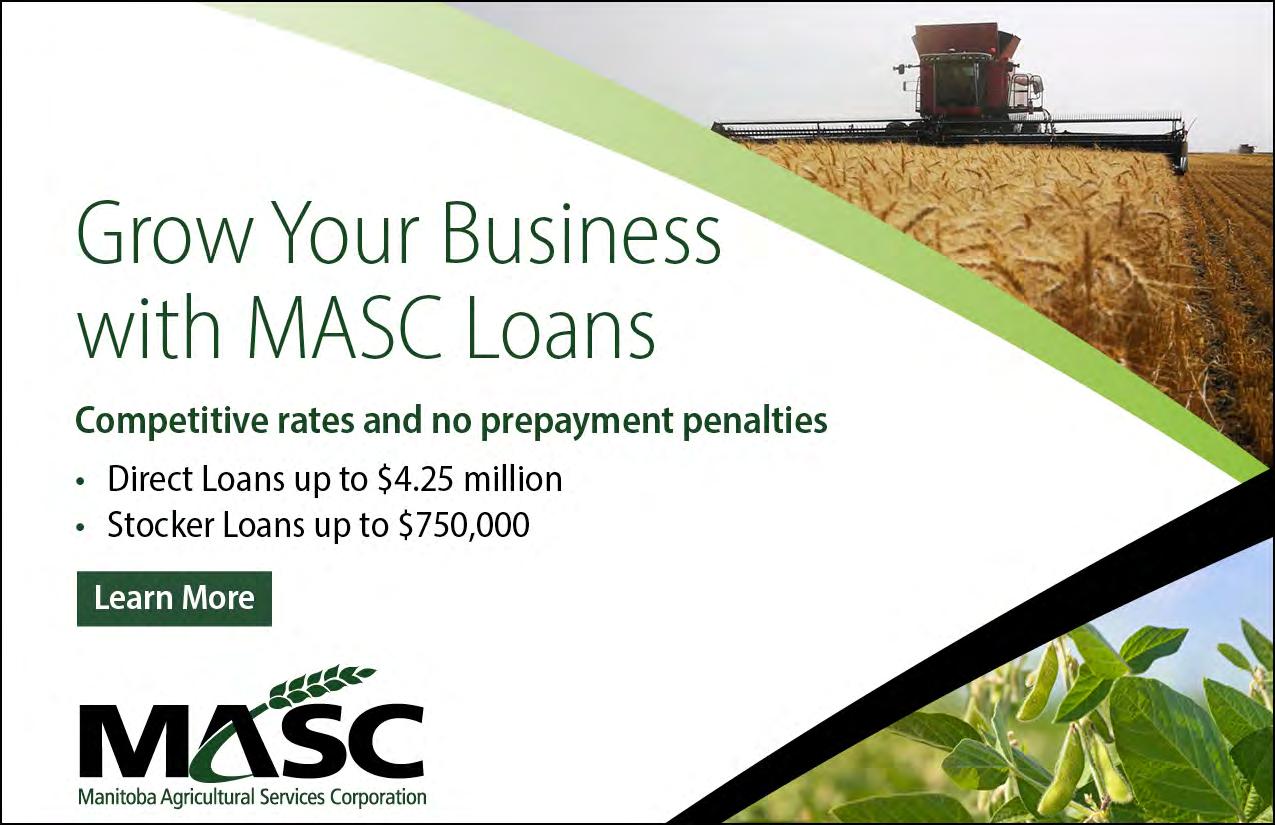
The Canadian Roundtable for Sustainable Beef (CRSB) was established in 2014 by a community of stakeholders with a mission of advancing,
measuring and communicating continuous improvement in sustainability of the Canadian beef value chain. The CRSB drives progress through sustainability performance measurement and strategic goals, and projects and initiatives aligned with those goals. Learn more at crsb.ca
The CRSB's Certified Sustainable Beef Framework, known as CRSB Certified, recognizes sustainable practices in beef production and processing, enables sustainable sourcing, and delivers 3rd party certified science based assurances about sustainable practices in Canada. Learn more at crsbcertified.ca
(CRSB News Release) The Canadian Roundtable for Sustainable Beef (CRSB) is seeking public input to proposed changes to the standards for sustainable beef production and processing that form the foundation of the Certified Sustainable Beef Framework (the Framework). An online 60 day comment period on the draft updated Standards opens today and runs until December 2, 2022. We encourage all interested parties to provide feedback.
The Framework was launched in 2017 to recognize sustainable practices in Canadian beef production and processing, to support sustainable sourcing commitments for the retail and foodservice sector, and to provide credible, science based assurances for Canadian consumers. As part of a scheduled five year program review, and following extensive stakeholder consultation, the CRSB’s Framework Committee conducted an in depth review of each indicator in both standards (beef production and processing), explored areas for improvement, and identified gaps. Proposed changes to the Standards focus on strengthening indicators through monitoring and demonstrating progress, and indicators that align with the 2030 Canadian Beef Goals.
Proposed changes to the Standards focus on strengthening indicators through monitoring and demonstrating progress, and indicators that align with the 2030 Canadian Beef Goals
“The engagement of our members and stakeholders during this review demonstrates the commitment across the Canadian beef value chain to continually advance beef sustainability practices, while also aligning with public interest in sustainability”, says Kristine
Tapley, Chair of the CRSB Framework Committee. Tapley is the National Sustainability Lead for Ducks Unlimited Canada and a beef producer from Langruth, Manitoba.
“These proposed changes all aim to advance our journey of continuous improvement that is at the heart of the definition of sustainability”, adds Tim Hardman of Fulton Market Group and CRSB Framework Committee Vice Chair. “We look forward to receiving constructive comments on the changes to the Standards, so that we can continually make improvements to our certification framework”.
Consultation documents, including a summary of proposed changes and full proposed updated standards, along with instructions for comments and suggested recommendations can be found on the NSF Online Consultation Workspace. Visit our Public Consultation webpage for further details.
ABOUT THE CRSB The Canadian Roundtable for Sustainable Beef (CRSB) advances, measures and communicates sustainability in the Canadian beef value chain in collaboration with its multi stakeholder membership. It drives continuous improvement through sustainability performance measurement and goals, a voluntary 3rd party sustainability certification program, and projects and initiatives aligned with strategic goals. Learn more at crsb.ca The Certified Sustainable Beef Framework, known as CRSB Certified, recognizes sustainable practices in beef production and processing, enables sustainable sourcing, and delivers 3rd party certified science based assurances about sustainable beef production in Canada. Learn more at crsbcertified.ca
This full time position reports to the Animal Health Canada Board of Directors, and is VIRTUAL, anywhere in Canada; must be able to travel occasionally. The position offers a competitive salary including benefit package.
Animal Health Canada (AHC) is the only Canadian organization which brings together industry, federal, provincial, and territorial partners to advance work to provide a collaborative and cohesive approach to farmed animal health and welfare in Canada. AHC is seeking a leader who brings passion and dedication to our mission which is based on One Health and One Welfare concepts. Our new Executive Director will be responsible for
effectively and efficiently overseeing the administration, programs and implementation of our strategic plan and new governance model as the organization undertakes a significant transition initiative. The ideal candidate is an experienced leader capable of forging partnerships, collaborating across sectors and bringing resources together to enable innovative and impactful projects and programs related to animal health, animal welfare, disease surveillance, and animal health emergency management.
To see the full posting, click here: https://www.agcareers.com/animal health canada/executive director job 899819.cfm

(November 1, 2022 RCMP News Release)
Calls for Service September 2021 to September 2022:
East District: 6% (7 048 to 6 615)
West District: +4% (4 821 to 5 002)
North District: 8% (6 389 to 5 862)
Overall, the Districts’ occurrence counts (combined) decreased by 4% (from 18,258 to 17,479), with Manitoba North District experiencing the largest decrease of 8% and Manitoba West District having the largest increase of +4%.
All Districts reported increases in Crimes against Property, however all Districts reported decreases in Crimes against Person.
For a listing of the communities served by each District, please visit: https://www.rcmp grc.gc.ca/mb/stats/districts eng.htm
During September 2022, Manitoba East District reported decreases in both Crimes against Person and Drug Enforcement and very minimal increases in Common Police Activities and Crimes against Property over the same period in 2021. The following increases and decreases are being highlighted:
Overall the category increased minimally by 4% (881 to 913), where the largest increase occurred in Wellbeing Checks, up 45% (100 to 145), followed by Suspicions Person/Vehicle/Property, up by 11% (326 to 361). The largest decrease occurred in Breach of Peace which was down by 19% (1985 to 157).
All sub categories under Crimes against Person had decreases; notably, Sexual Offences were down 68% (47 to 15), and Robbery/Extortion/Harassment/Threats were down 30% (141 to 99).
The category had an overall increase of 3% (899 to 929); Notably, Break and Enters increased 45% (92 to 133) and Theft under $5000 increased 26% (172 to 216). Arsons decreased by 60% (10 to 4).
Drug Enforcement decreased 55% (51 to 23). Possession was down 68% (19 to 6), and Trafficking was down 50% (28 to 14).
During September 2022, Manitoba West District decreased in Crimes against Person and Drug Enforcement, while Crimes against Property and Common Police Activities both increased, over the same period in 2021. The following increases and decreases are being highlighted:
Overall, the category increased by 11% (650 to 724), with the largest increase occurring in Suspicious Person/Vehicle/Property up 51% (248 to 375). The largest decreases were in Person Reported Missing which was down 31% (86 to 59) and Breach of Peace which was down 20% (134 to 107).
Crimes against Person decreased overall by 19% (410 to 332), with notable decreases in Assaults, down 23% (251 to 193) and Robbery/Extortion/Harassment/Threats down by 16% (132 to 111). Sexual Assaults were up 21% (19 to 23).
There was a 33% increase overall (720 to 961 occurrences), with Possession of Stolen Goods showing the highest increase of 140% (20 to 48), followed by Theft over $5000 up by 82% (67 to 122) and Break and Enters up by 53% (92 to 141). The only decrease was in Arsons which decreased by 7% (15 to 14).
Reported Missing down 35% (220 to 144), followed by Breach of Peace which was down 26% (426 to 317); while the only increase was in Suspicious Person/Vehicle/Property which was up by 10% (70 to 77).
The category decreased overall by 10% (980to 882)with the largest decrease occurring in Sexual Offences down 45% (60 to 33), followed by Forcible Confinement down 27% (11 to 8).
Drug Enforcement was down by 25% overall (60 to 45).
During September 2022, over September 2021, Manitoba North District reported decreases in all occurrence groups except for Crimes against Property. The following increases and decreases are being highlighted:
Overall, the category decreased by 23% (955 to 740). The largest decrease occurred in Person
There was a 10% increase overall (1232 to 1360), with Break and Enters reporting the highest increase at 56% (66 to 103), followed by Fraud up 35% (20 to 27). The only decrease occurred in Theft under $5000 down 4% (123 to 118).
Drug Enforcement was down 30% overall (60 to 42), and all sub categories either decreased or had no change. Of note, Possession was down 38% (13 to 8) and Trafficking was down 18% (40 to 33).
The complete statistics can be found here: https://www.rcmp grc.gc.ca/mb/stats/index eng.htm.
• GRASSFED: "TrueNorthFoodsispartneredwithA&WCanada tosupplyCanadiangrassfedbeefforA&Wsgrassfedburgerprogram.


• SERVICES: Whetheryouareaspecialtyproducerlookingtoget yourproducttoaspecificmarketordistributor,orifyouareproducing commoditylivestockforsale,wecanpartnerwithyou.Fromour multi-speciescapabilitiestoourabilitytohandlesmallervolumes,we offerexcellentcapabilitiesforproducersintheCanadianPrairiesto maximizetheirprofitability.
• FACILITY: Wehaveastate-of-the-artfacilitytoallowusto reachmarketsacrossCanada,theUSA,andbeyond.Weunderstand producersneeds,theircarefortheiranimals,andtheirhonest, straightforwardnature.Callustohearhowwecanworktogethertoget yourproducttomarket.
www.truenorthfoods.ca
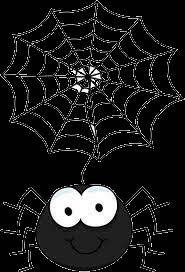


from MBP October 28, 2022 mbbeef.ca

and date of hydrostatic testing along with the TC service agency certificate number.

(October 25, 2022 Province of Manitoba News Release)
Manitoba Municipal Relations, through the Office of the Fire Commissioner (OFC), has issued a recall notice on carbon dioxide (CO2) portable fire extinguishers serviced by Steinbach Fire Protection.
Over the past few years, servicing and maintenance of these products may not have complied with the requirements of National Fire Protection Association Standard 10: Standard for Portable Fire Extinguishers and as a result may need re servicing to ensure proper function.
Manitobans are advised to check the verification of service collar label for cuts or alterations and if the Transport Canada (TC) certificate stamp is absent. The neck of the cylinder must be physically stamped, indicating the month
If a fire extinguisher is suspected to have not been serviced properly, contact Steinbach Fire Protection at 204 320 1800 for a re evaluation and corrective actions. The OFC should also be notified if the equipment is found to have not been properly serviced. The OFC can be contacted by calling 1 204 945 3322 or via email at firecomm@gov.mb.ca with any findings including pictures, locations, documents associated with the condition of the fire extinguisher, and its service records by Steinbach Fire Protection.
The Manitoba Fire Code (MFC) calls for portable fire extinguishers to be serviced and maintained in compliance with NFPA 10, which requires CO2 portable fire extinguishers to be hydrostatically tested every five years. The MFC requires service agencies to be certified by the Transportation of Dangerous Goods Directorate, Transport Canada, where high pressure hydrostatic testing is necessary. A verification of service collar, consisting of an uninterrupted piece of material to confirm service has been performed, must be installed after servicing.

•
• SERVICES: Whetheryouareaspecialtyproducerlookingtoget yourproducttoaspecificmarketordistributor,orifyouareproducing commoditylivestockforsale,wecanpartnerwithyou.Fromour multi-speciescapabilitiestoourabilitytohandlesmallervolumes,we offerexcellentcapabilitiesforproducersintheCanadianPrairiesto maximizetheirprofitability.

• FACILITY: Wehaveastate-of-the-artfacilitytoallowusto reachmarketsacrossCanada,theUSA,andbeyond.Weunderstand producer'sneeds,theircarefortheiranimals,andtheirhonest, straightforwardnature.Callustohearhowwecanworktogethertoget yourproducttomarket.
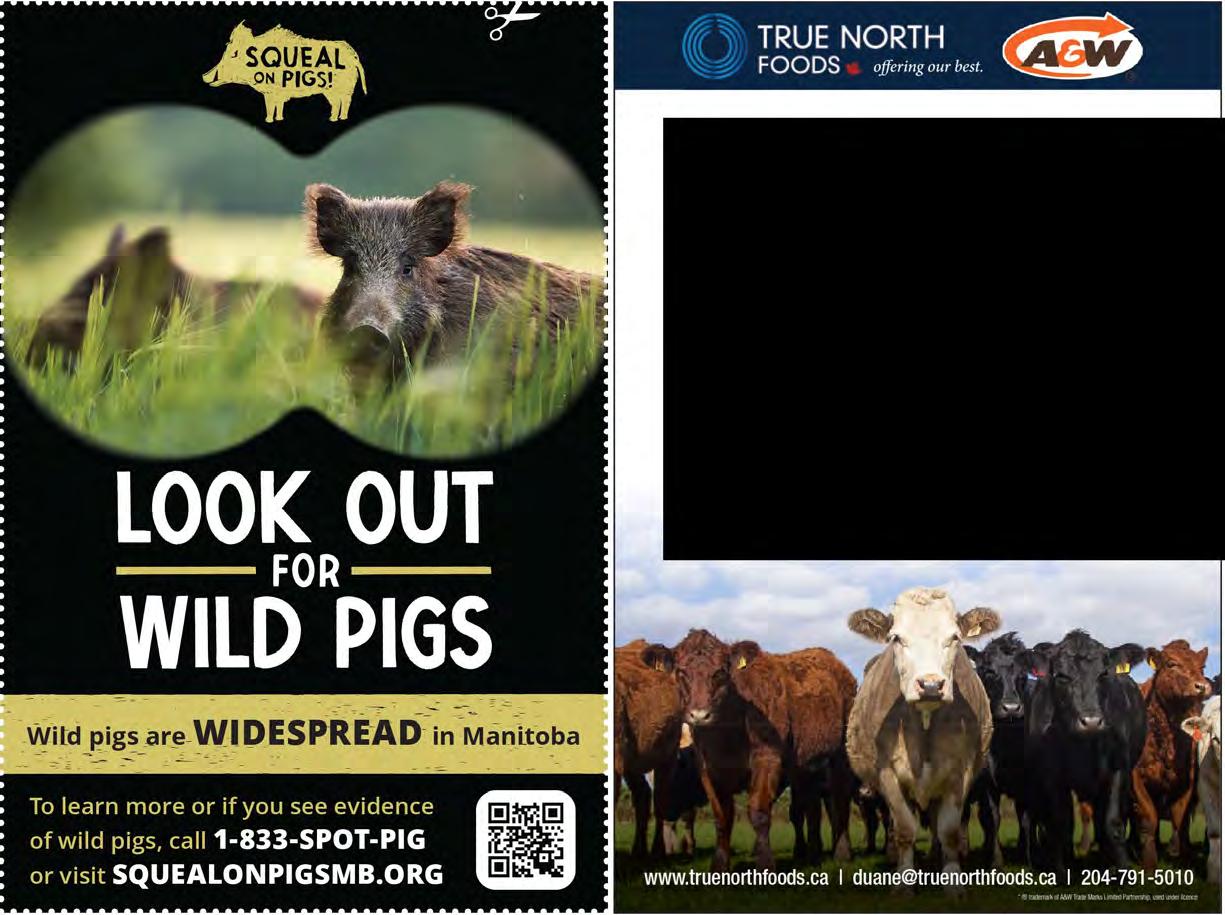 GRASSFED: "TrueNorthFoodsispartneredwithA&WCanada tosupplyCanadiangrassfedbeefforA&Wsgrassfedburgerprogram.
GRASSFED: "TrueNorthFoodsispartneredwithA&WCanada tosupplyCanadiangrassfedbeefforA&Wsgrassfedburgerprogram.

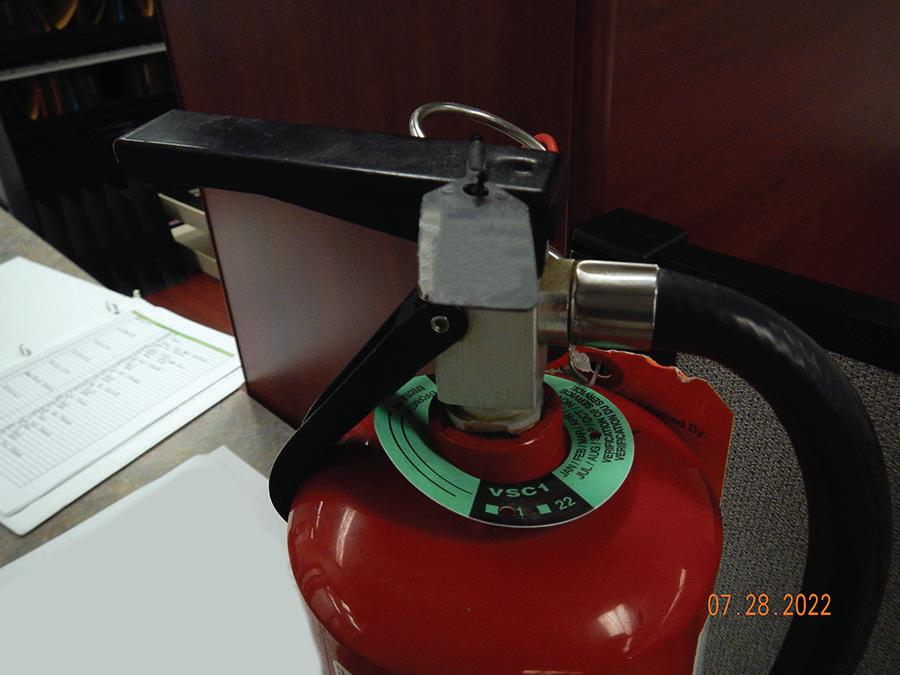
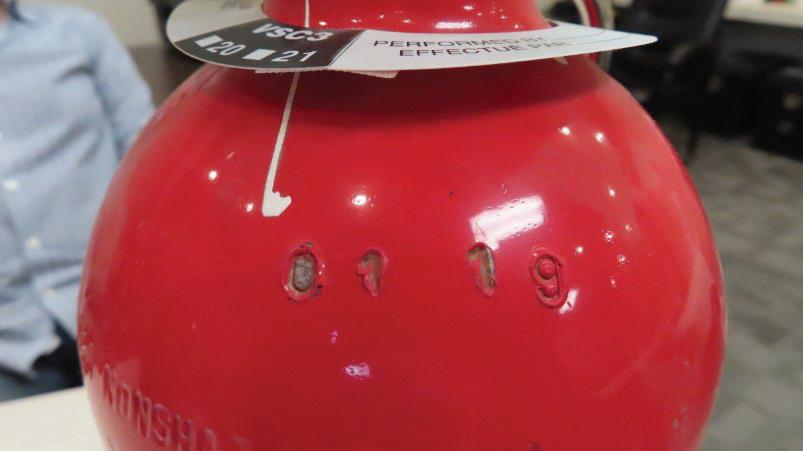

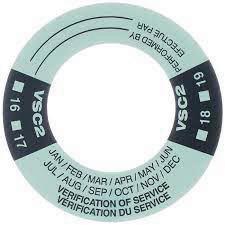



(October 25, 2022 Province of Manitoba News Release) The Manitoba government has introduced legislation that would create a new offence under the Highway Traffic Act to prohibit driving on closed roads, Manitoba Transportation and Infrastructure Minister Doyle Piwniuk announced today.
“Our government heard from RCMP leadership and their support for measures that promote road safety and stronger laws to help discourage motorists from the dangerous practice of accessing and driving on closed roads,” said Piwniuk. “Once enacted, Bill 46 will make this treacherous activity illegal, with offenders facing substantial fines, and making roads safer for everyone.”
Last winter’s severe weather, followed by spring flooding events, resulted in an unprecedented number of road closures across Manitoba.
Individuals intentionally making decisions to drive on roads closed due to severe weather conditions, flooding, construction or other safety related reasons put themselves and others at risk, including emergency responders, operators of snow clearing equipment and roadway maintenance staff, the minister noted.
The new offence would allow law enforcement officers to issue traffic tickets and in the most serious incidents, the bill would allow for maximum fines of up to $5,000 for drivers of heavy vehicles and up to $2,000 for drivers of light vehicles such as cars, light trucks and SUVs.
The proposed amendments would bring Manitoba in line with other provinces including British Columbia, Ontario and Saskatchewan, which have already made it an offence to drive on closed roads
(October 24, 2022 News Release) Public Services and Procurement Canada (PSPC) wishes to advise users that the bridge at the St. Andrews Lock and Dam will be closed to vehicular traffic for deck replacement work during the following period:
• Thursday, November 3, at 7 pm, to Friday, November 4, at 6 am
During this period, all lanes will be closed to vehicular traffic in both directions. Motorists are encouraged to consult local electronic signs for the most up to date information.
Travellers are reminded that the bridge will remain open to pedestrians and cyclists. As of October 18, pedestrians and cyclists are able to use the newly constructed walkway on the north side of the bridge. Cyclists are asked to yield to pedestrians when using the walkway.
PSPC encourages users to exercise caution when travelling on the bridge and thanks them for their patience.
(Information From Agriculture and Agri-Food Canada) The Agroclimate Impact Reporter (AIR) is a tool to help connect Agriculture and Agri Food Canada (AAFC) with people in Canada's agricultural community. AAFC relies on its network of AIR volunteers to provide information regarding agroclimate impacts on farm operations across the country.
The AIR network provides valuable and reliable data that are mapped and used in the assessment and development of policies and programs including AgriRecovery and the Livestock Tax Deferral Provision, which can provide assistance to the industry during extreme weather and climate conditions and events.
The AIR network is an ever growing database of agroclimate impacts, which enables better data analysis to help identify trends and anomalies.
AAFC currently in its October reporting session for the 2022 agricultural season. If you are able to find five to ten minutes to respond to the brief survey about agricultural conditions, it would be greatly appreciated. AAFC thanks all those who contributed to the September 2022 AIR survey!
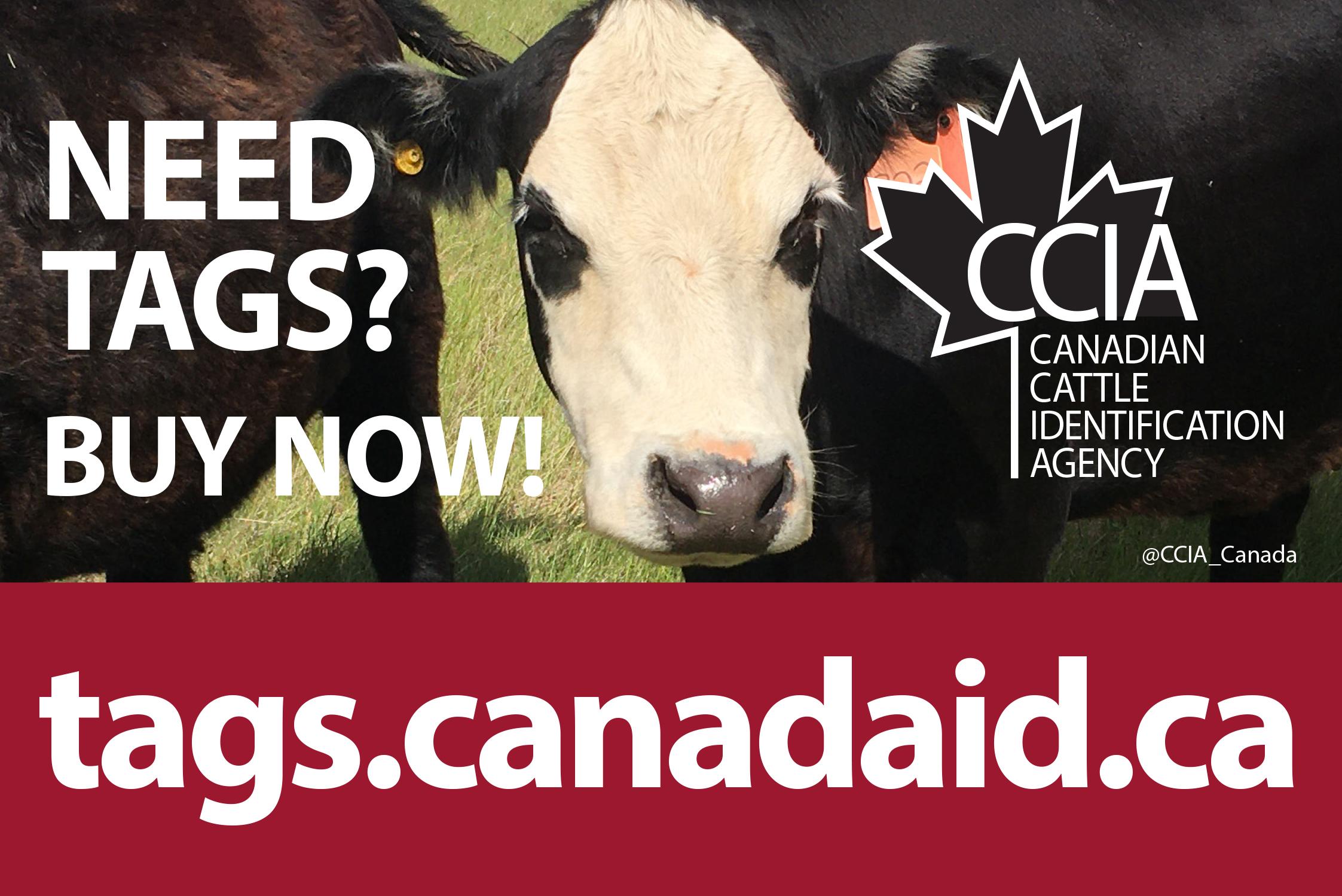
The surveys are linked below; please considering sharing the links with your colleagues and networks.
English French
Click here for previous Agroclimate Impact maps from September or past years. Other resources that we produce on the Drought Watch home page.
Tell us where in Canada your farm is located.
Tell us your sustainability story by answering some or all of these questions:
(October 27, 2022 Canadian Cattle Association) We know that Canadian Cattle farmers and ranchers like you have a long standing tradition of doing the right thing for your land and animals. Through hard work, you have demonstrated a growing commitment to sustainability.

With new and innovative environmental and conservation practices being implemented at cattle farms across Canada, it's hard to keep up!
That's why we want to hear your story. We invite you to share your unique sustainability story with us by recording and submitting a 1 5 minute video.
Using your smartphone camera, follow three easy steps and tell us your sustainability story.
[Record My Video]
https://sustainablecattle.capsule.video/
Here are a few tips to enhance your story: Show us your farm! Weather permitting, film the video outside.
o Why is producing sustainable cattle important to you?
o What makes your farm special or unique?
o What are some practices or innovations you use to help protect your land?
o How do you care for the ecosystems on your farm?
o Are there any wildlife species that call your farm home? How do you preserve their habitats?
Thank you for taking the time to share your story with us about how you take action to care for your land, animals and environment.
Please do not hesitate to reach out if you have any questions.
We look forward to hearing from you!
You're invited to take part in the review of the Agricultural Crown Lands Program and help guide future policy improvements. Fill out the survey today and provide your input at https://bit.ly/3fxdjIR. The deadline to reply has been extended to October 30th.
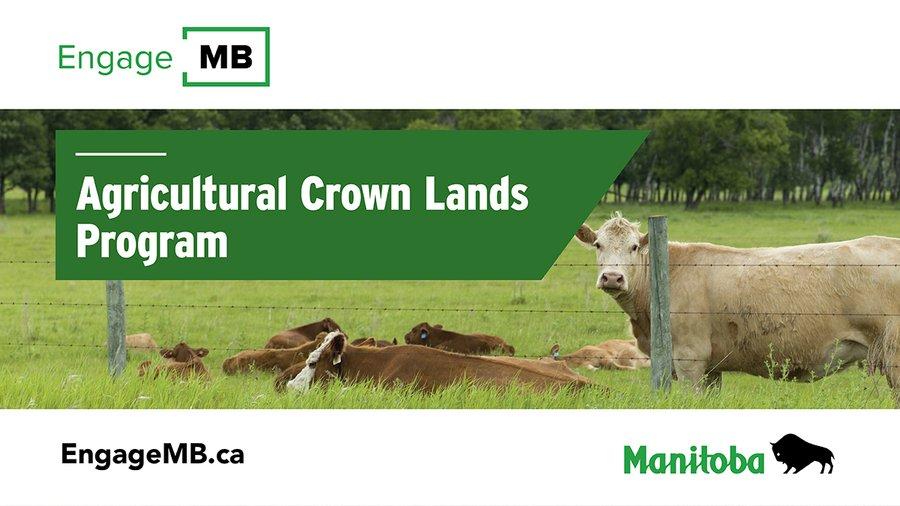
Head Office
#180, 6815 8th Street NE Calgary, Alberta T2E 7H7
Phone: (403) 275 8558
Email: contact@cattle.ca
Ottawa Office #1101, 350 Sparks St. Ottawa, Ontario K1R 7S8
Phone: (613) 233 9375
Location: Ottawa / Hybrid
Overview:
The Canadian Cattle Association (CCA) represents Canada’s 60,000 beef producers and works to address issues that concern beef producers. With CCA headquarters in Calgary, CCA also has an Ottawa office that focuses on domestic and international advocacy regarding climate change, trade, economic resiliency, innovation and research.

The Government Relations Coordinator is a key position within the CCA Ottawa team. They are responsible for monitoring Parliamentary activities and federal departments, keeping a keen eye on areas of focus of CCA. They will create briefing notes to support CCA’s policy team and look for opportunities for CCA leadership and staff to further our advocacy objectives.
The coordinator is responsible to coordinate CCA’s “fly-ins”, set up meetings with Parliamentarians, and develop both internal and external briefing packages.
CCA hosts various Parliamentary receptions and other events throughout the year; the coordinator will have a central role in the event management, both in preparation and during the event.
Reports to: Senior Director, Government and Public Affairs
• Monitor Parliament including but not limited to: committees and Question Period and provide briefings on relevant files.
• Monitor relevant government departments for consultations, policy initiatives, etc. that is relevant to CCA’s objectives.
• Develop and maintain mailing and contact lists for federal elected and senior bureaucratic officials.
• Research, coordinate and write products to support parliamentary activities and policy positions (e.g., briefing notes, backgrounders, taking notes in meetings).
• Attain and maintain a knowledge base of policy and legislative priorities; supporting CCA’s analysis and participation on policy files/projects.
• Organize “Fly Ins” for CCA Provincial Members.
• Assist in Event Management for Key Ottawa events, including our VIP Annual Reception, Fall BBQ and other events on an ongoing basis
• Other
o Maintain the lobby registry for Directors and staff as approved by the CEO.
o Support Ottawa team on miscellaneous projects in both a policy and administrative capacity.
www.cattle.ca
Head Office
#180, 6815 8th Street NE Calgary, Alberta T2E 7H7
Phone: (403) 275 8558 Email: contact@cattle.ca
Ottawa Office
#1101, 350 Sparks St. Ottawa, Ontario K1R 7S8
Phone: (613) 233 9375
• Fluency in English with strong written and oral communication skills; Proficiency in French is an asset.
• Excellent research, analytical and problem-solving skills; attention to detail and sound judgement.
• High degree of proficiency in working in a fast-paced, collaborative team environment
• Requires experience scheduling meetings with elected and unelected officials.
• Proficiency in Microsoft Office and other computer programs is essential.
• Requires a high degree of resourcefulness, detail oriented skills, self motivation and self direction as well as the judgement necessary to understand when to seek direction and the ability to both multi task and prioritize.
• Ability to register as a federal lobbyist with the Commissioner of Lobbying for Canada this role is based in the Ottawa office, ability for hybrid work is available
Education: University degree or college diploma paired with relevant experience.
Please send cover letters and resumes to babcockj@cattle.ca with the subject line: Government Relations Coordinator.
We thank all candidates for their interest; however, only those selected for an interview will be contacted.
www.cattle.ca
 The Canadian Cattle Association is the national voice for Canada’s beef cattle industry representing 60,000 beef farms and feedlots
The Canadian Cattle Association is the national voice for Canada’s beef cattle industry representing 60,000 beef farms and feedlots
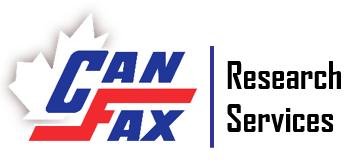
A division of Canadian Cattle Association #180, 6815 8th St NE Calgary, AB T2E 7H7 Em: crs@canfax.ca Tel: (403) 275 5110 Fax: (403) 275 6943
October 2022
Canfax Research Services (CRS) provides the Canadian beef industry with statistical and market information on the domestic and global beef trends. Economic analysis is utilized for marketing, research, policy and investment decisions supporting strategy and business plan development as well as performance measurement. CRS monitors data sources from national statistics and develops new economic models to and evaluate the impact of management decisions on cost of production. CRS maintains its independence as a third party source of unbiased market information, maintaining operations through regular publications, long term contracts and projects. CRS is responsible for database maintenance, background research, statistical and market analysis for regular publications and specialized research projects including the Canadian Cow Calf Cost of Production Network.
We are looking for a talented, self motivated individual to participate in our Summer Intern Program.
The Summer Intern Program is a unique opportunity for students interested in the Canadian beef industry across a broad range of topics. The successful candidate will be involved in collaborating on research projects in the areas of productivity, sustainability, policy, and global markets as they relate to the Canadian beef industry.
• Database management, statistical analysis, and model development in Excel
• Conduct literature reviews on a wide variety of topics
• Write fact sheets and blog articles
• Perform other duties as assigned
• Applicants must be enrolled in undergraduate, graduate, or post graduate studies
• Applicants should be enrolled in an agriculture or associated program, have beef production experience, and/or an expressed interest in pursuing a career in the Canadian beef industry
• Must have a minimum GPA of 3.0 and be available for the duration of the internship
• Must have excellent research, writing and communication skills
• Must be able to work in CCA’s Calgary office (COVID measures in place)
• Data summary, analysis and report development including organizing and preparing databases for future data mining activities
• Working with staff to produce fact sheets and other content for the CDN COP Network, including international comparisons and case studies
Please send your resume and cover letter, by Friday November 25th to:
Brenna Grant, M.Sc. P.Ag.
Executive Director, Canfax Research Services
180, 6815 8th Street NE Calgary, AB T2E 7H7 Ph: (403) 275 5110 or Em: grantb@canfax.ca
The Canadian Cattle Association is an Equal Opportunity Employer and Prohibits Discrimination and Harassment of Any Kind: CCA is committed to the principle of equal employment opportunity for all employees and to providing employees with a work environment free of discrimination and harassment. All employment decisions at CCA are based on business needs, job requirements and individual qualifications, without regard to race, colour, religion or belief, national, social or ethnic origin, sex (including pregnancy), age, physical, mental or sensory disability, sexual orientation, gender identity and/or expression, marital, civil union or domestic partnership status, past or present military service, family medical history or genetic information, family or parental status, or any other status protected by the laws or regulations in Canada.
Head Office
#180, 6815 8th Street NE Calgary, Alberta T2E 7H7
Phone: (403) 275 8558
Email: contact@cattle.ca
Ottawa Office #1101, 350 Sparks St. Ottawa, Ontario K1R 7S8
Phone: (613) 233 9375
Location: Ottawa / Hybrid
Overview:
The Canadian Cattle Association (CCA) represents Canada’s 60,000 beef producers and works to address issues that concern beef producers. With CCA headquarters in Calgary, CCA also has an Ottawa office that focuses on domestic and international advocacy regarding climate change, trade, economic resiliency, innovation and research.
The Regulatory Affairs Manager is a key role within the CCA Policy team The Manager will support policy creation and dissemination across a breadth of files at CCA. Based in the CCA Ottawa office the individual will create and maintain strategic relationships and communication channels with key government officials as well as elected officials and staff. The Manager will monitor regulatory consultations being developed by the Federal Government and lead CCA’s regulatory files.
This role will also lead CCA’s policy development and engagement on food policy including but not limited to topics such as: labelling, grading, food waste, food guides and meat inspection.
The Manager will be a key part of CCA’s climate change work, focusing on the policy and regulatory components domestically. As part of the climate change file, there will be the opportunity to engage internationally as well through our global partnerships.
Reports to: Senior Director, Government and Public Affairs
CCA Policy and Regulatory Affairs
o Significantly contribute to the strategy, development and implementation of CCA’s Government Relations outreach from a regulatory lens.
o Maintain inventory and understanding of CCA’s policy and regulatory positions and priorities across all files.
o Monitor federal consultation opportunities and draft submissions with policy team support.
o Lead staff for research, analysis and policy recommendations regarding food policy in Canada and internationally.
o Lead Food Policy work from a staff level, working closely with Food Policy Committee Chairs and Members, both at AGM, Semi-Annual meetings and other meetings as required.
o Participate in policy and regulatory consultations
The Canadian Cattle Association is the national voice for Canada’s beef cattle industry representing 60,000 beef farms and feedlots www.cattle.ca

Head Office
#180, 6815 8th Street NE
Calgary, Alberta T2E 7H7
Phone: (403) 275 8558
Email: contact@cattle.ca
o Engage in consumer, industry, and government dialogue.
Ottawa Office #1101, 350 Sparks St. Ottawa, Ontario K1R 7S8
Phone: (613) 233 9375
o Work closely with industry including Public and Stakeholder Engagement, Canada Beef and Canadian Roundtable for Sustainable Beef.
o Build and maintain key relationships in the food policy community
o Build and maintain key relationships with government officials on food policy
o Lead staff for research, analysis and policy recommendations regarding climate change policies and regulations domestically.
o Work closely with policy team, specifically with Environment Manager on climate change files.
o Report to Environment Committee on Climate change work.
o Participate in policy and regulatory consultations.
o Engage in consumer, industry, and government dialogue.
o Build and maintain key relationships in the environment NGO community.
o Build and maintain key relationships with government officials on climate change.
o Regular contribution to CCA Action News
o Draft and lead consultation submissions and other documents expressing policy recommendations and request
o Website content review relevant to files
o Liaison with agriculture commodity representatives in Ottawa
• Fluency in English with strong written and oral communication skills; Proficiency in French is an asset.
• Excellent research, analytical and problem solving skills; attention to detail and sound judgement.
• High degree of proficiency in working in a fast paced, collaborative team environment
• Proficiency in Microsoft Office and other computer programs is essential.
• Requires a high degree of resourcefulness, detail oriented skills, self motivation and self direction as well as the judgement necessary to understand when to seek direction and the ability to both multi task and prioritize.
• Ability to register as a federal lobbyist with the Commissioner of Lobbying for Canada this role is based in the Ottawa office, ability for hybrid work is available.
• Ability to travel domestically and internationally.
Education: University degree paired with relevant experience.
Please send cover letters and resumes to babcockj@cattle.ca by Monday, November 14, 2022, with the subject line: Regulatory Affairs Manager.
We thank all candidates for their interest; however, only those selected for an interview will be contacted.
The Canadian Cattle Association is the national voice for Canada’s beef cattle industry representing 60,000 beef farms and feedlots www.cattle.ca


Name(s): Farm Name: Address:
Phone: Email: PLEASE ATTACH A WORD DOCUMENT WITH THE FOLLOWING INFORMATION:
1. Provide a description of your farm including the environment it operates in.
2. What have you done/what are you doing to improve environmental management on your farm?
3. What are your challenges and successes? Please include high-resolution images and data which help show measurable results.
4. What factors have enabled you to make management changes? (e.g. Working with conservation organizations, programs such as the Environmental Farm Plan, funding support, education, etc.)
5. What are your environmental goals for the future and how do you plan to carry them out?
6. Include two letters of reference that speak to your leadership in conservation.
Please limit your application to 10 pages (not including letters of reference and photos). Electronic applications are preferred and a single, complete PDF document is requested. A sample application from previous years can be found online at https://www.cattle.ca/sustainability/theenvironmental-stewardship-award/how-to-nominate/
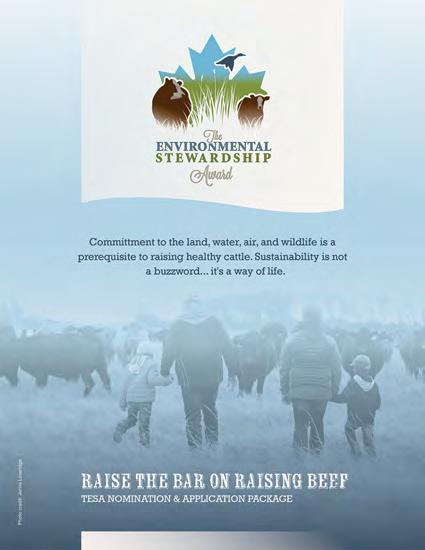
Contact your provincial organization listed on the previous page to determine when your association requires you to submit your application for the provincial award.
A selection of no less than ten high-resolution images suitable for reproduction on social media, print etc.
Video presentation link if available, media stories/ broadcasts showcasing your stewardship efforts.
TESA sponsorship program is available to appropriate organizations that wish to affiliate themselves with the CCA’s TESA program. In addition to showing support for environmental stewardship and Canada’s beef cattle producers, the program also provides the opportunity to join industry leaders, government representatives and nearly 60,000 Canadian beef farms in the national discussion on environmental issues affecting the industry. For more information, visit www.cattle.ca/what-is-tesa


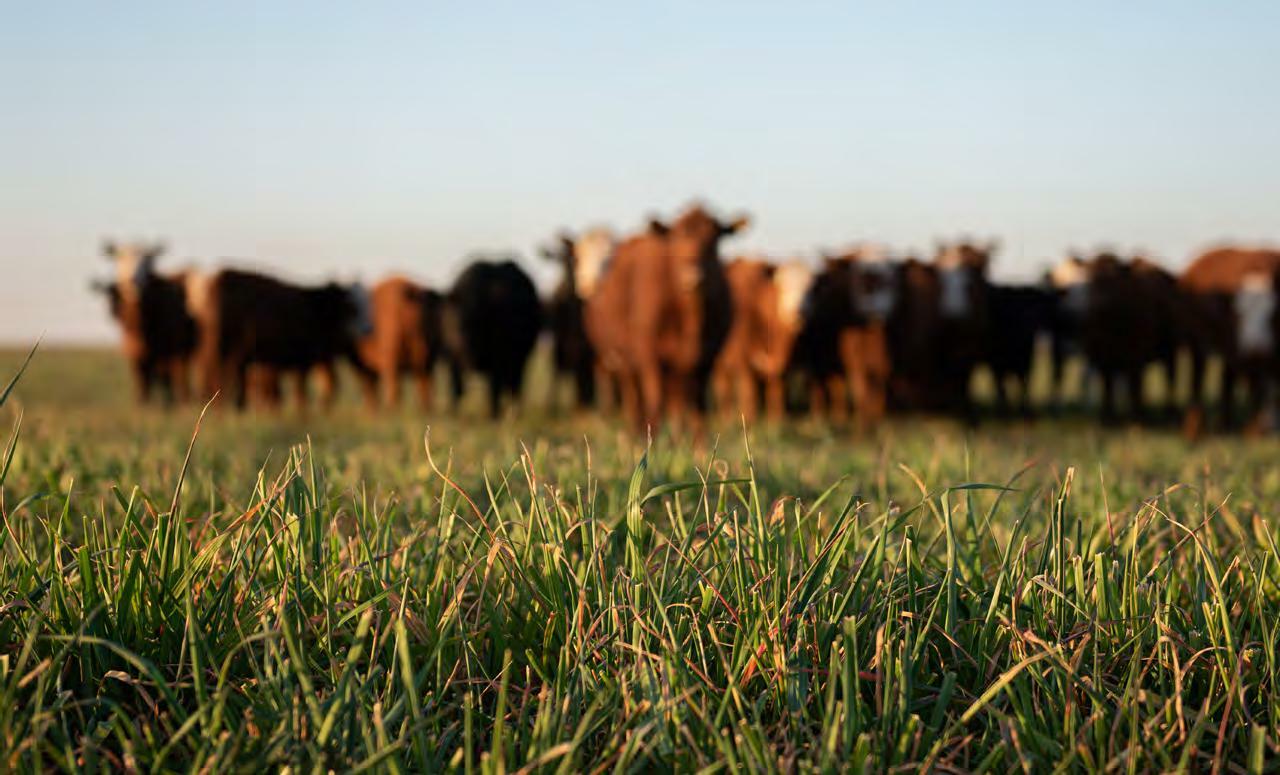
For more than 65 years, MNP has been helping beef producers get the most from their operations. Whether you are looking to pass the farm on to the next generation, improve your profitability, be more competitive or expand MNP’s beef industry specialists will help you get the results you’re looking for. To find out what MNP can do for you, contact Marvin Slingerland, Partner, MNP Lethbridge, at Director of Livestock Services at 1.800.661.8097 or Marvin.Slingerland@mnp.ca

Safely dispose of unwanted or obsolete agricultural pesticides and livestock/equine medications –no charge! Take them to the following locations on the dates noted between 9 a.m. and 4 p.m.
ARNAUD
Thursday, Oct. 27 G J Chemical Co. Ltd. 96 Smith Ave West 204-427-2337
BALDUR Friday, Oct. 28 Baldur Agro 121 2nd St 204-535-2598
BEAUSEJOUR
Wednesday, Oct. 26

Nutrien Ag Solutions 73010 Road 40 off Hwy 44 SE 10-13-7E 204-268-3497
BRANDON Thursday, Oct. 27 Richardson Pioneer 14 km west on Hwy 1, then 1/4 mile south on Pioneer Rd. 204-727-5353
BRUNKILD
Monday, Oct. 24 MK Agro 3062 Road 39 NW 204-736-4769
DAUPHIN Monday, Oct. 24 Dauphin Co-op AGRO 601 Whitmore Ave E 204-622-6080
DELORAINE Monday, Oct. 24
Nutrien Ag Solutions Hwy 3 & Broadway St. S 204-747-2877
GLADSTONE Monday, Oct. 24 Neepawa-Gladstone Coop Road 69, Hwy 16 (4 miles W of Gladstone) 204-385-2906
INGLIS
Wednesday, Oct. 26 Prairie Giants Crop Supply 2 km East of Hwy 83 on PR 366 204-564-2293
MEADOWS
Thursday, Oct. 27 Ag Advantage Ltd 68156 Road 6 W 204-322-5351
MELITA
Tuesday, Oct. 25 Cargill 7 km SW of Melita on Hwy 83 204-522-3221
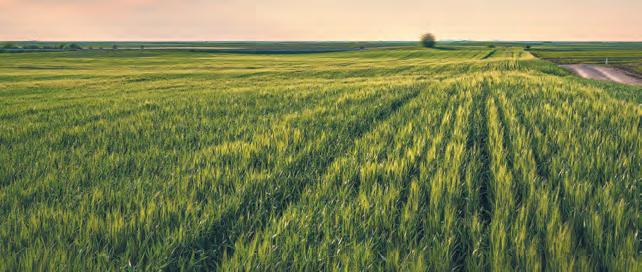
PORTAGE LA PRAIRIE Friday, Oct. 28 Portage Agri-Sales 11 Can-Oat Dr 204-857-7838
RIVERS
Friday, Oct. 28 Redfern Farm Services 102 2nd Ave 204-328-5325
SHOAL LAKE Thursday, Oct. 27 Shur-Gro Farm Services Ltd. 236 Industrial Park Rd. 204-759-4240
ST. LEON Tuesday, Oct. 25 Pembina Coop 49079 Road 25N 204-744-2850
STANLEY Wednesday, Oct. 26 Cargill 12137 Road 25W 204-325-9551
STEINBACH
Friday, Oct. 28 Clearview Coop 33124 Road 39 N (at Hwy 12N, between Steinbach and Blumenort) 204-326-9921
SWAN RIVER Tuesday, Oct. 25 Cargill 2 miles south on Hwy 83 204-734-5747
TEULON
Tuesday, Oct. 25 Willis Agro 11034E Road 95N 204-461-0386
VIRDEN Wednesday, Oct. 26 Core Ag Inputs 320 Chester St. E 431-763-3536
The proper nutrition of beef cattle is a key component of a successful production system. Feed usually accounts for the single largest input cost associated with beef cattle. Find out more about how to feed your animals successfully and at a low cost.
Date: Wednesday, November 2, 2022
Time: 10 a.m. to 3 p.m.
Place: Manitoba Beef and Forage Initiatives Farm

Corner of highway 353 and #10 north of Brandon
Cost is $20 per person. Call Manitoba Agriculture at 204-648-3965 to pre-register
Agenda
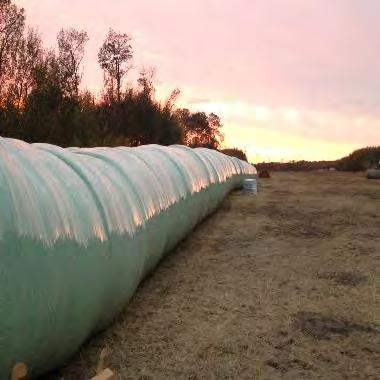
10 a.m. The Silage How-to Guide for Livestock Producers
Dr. John McKinnon, JJM Nutrition, Saskatoon, SK
11 a.m. Getting a Handle on Feed Costs
Ben Hamm Farm Business Management Specialist, Manitoba Agriculture, Steinbach
LUNCH
1 p.m. Beef Cattle Nutrition - Cow and backgrounder rations
Dr. John McKinnon, JJM Nutrition, Saskatoon, SK
2 p.m. Alternative Feeds for Feeding the Cow Herd
Shawn Cabak Livestock and Forage Extension Specialist

Manitoba Agriculture, Portage
2:30 p.m. Cowbytes Nutritional Program for Beef Cattle
Elizabeth Nernberg - Livestock and Forage Extension Specialist
Manitoba Agriculture, Roblin
Producers are reminded that the Manitoba government has announced a consultation related to the Agricultural Crown Lands (ACL) Program and forage leases as part of is continuing review of the program.
As per the province’s September 28 news release, “Manitoba Agriculture is exploring other policy, program, regulation and service improvements to enhance the productivity and sustainability of agricultural Crown forage lands including mechanisms for leaseholders to invest in productivity and adjustments to the terms and conditions of leases.
To participate in the online version of the survey visit http://engagemb.ca/agcl forage leases

If you prefer, a hard copy of the survey is also found in this edition of the MBP e newsletter, along with a backgrounder on the program and changes made to it in recent years. MBP encourages producers to complete the survey online if at all possible so that the information is
available to the provincial government as soon as possible.
Please mail hard copies of the completed survey to:
Manitoba Agriculture
ATTN: Marnie Carey 816 401 York Ave Winnipeg, MB R3C 0P8
As noted, the online survey closes on October 30, 2022, and have your hard copies of it postmarked by October 30 as well.
To read the news release where this consultation was announced (and which also refers to the provincial government implementing a temporary three year rent reduction for forage leases on agricultural Crown lands commencing in 2023) go to: https://news.gov.mb.ca/news/index.html?item =56479&posted=2022 09 28

Manitoba Agriculture has heard from forage lease holders through their letters and through various meetings. Several concerns were raised about rents, lease terms and conditions, land productivity, and programs/services. The following discusses current policies on ACL.
Forage rents are calculated using a market based formula in regulation: 3.5% of the market price of beef x the number of cows that the land can sustain (i.e. “animal unit months”, or AUMs, which is a measure of the productivity of the land). Forage lease rent is A x B x 3.5% (where A = AUM, B = price of cattle).
Previously, rents were frozen at artificially low rates since 2014, at about $2/AUM, and were based on a triennial survey. Lessees are currently paying $7.19/AUM, or about $48 for 5 months of feed per cow calf pair (for reference Saskatchewan 2022 grazing rates are $8.18 per AUM).
Rental rate transition: In 2019, the rental rate remained at $2.13 per AUM. In 2020, the rental rate was the average of the 2019 rate and the amount described in the formula. In 2021 and thereafter, the rent is determined using the formula. In addition, rent is now payable by December 31, rather than at the end of the production year as had been the practice in the past.

Forage lease terms are 15 years. Those who had forage leases prior to 2019 (i.e. “legacy leaseholders”) can transfer their lease to immediate family members only in perpetuity. For partnerships and corporations, leases obtained prior to 2019 can be transferred to an existing ownership interest in the partnership or corporation in perpetuity.
Leaseholders may surrender their lease at any time without penalty. Surrendering only a portion of a lease can be considered on a case by case basis, depending on the land use impacts and other considerations.
Lifetime leases can no longer be transferred to a third party. This is called a unit transfer. Typically, this involves the transfer of a lifetime ACL lease along with the sale of a farmer’s private property to a non family member. However, those with forage leases prior to 2019 may transfer their leases to immediate family members in perpetuity.
AUM ratings are long term production averages. AUMs are not adjusted annually and are generally conservative. Lands are assessed for AUM using scientific methods based on region, soil type, type of vegetation and other conditions. AUM assessments are always conducted prior to Crown land auctions. Forage lessees are expected to manage the land to maintain or increase long term productivity. AUMs are not adjusted downward if leaseholders are not actively maintaining the land, including controlling encroachment. AUMs are a key part of rent calculations: rent is calculated as 3.5% of the market price of cattle per AUM.
When leaseholders make investments to improve ACL productivity, by policy, Manitoba will not increase AUM assessments on those lands for 10 years.
The 2021 ACL Forage Productivity Pilot Program (ACLFPPP) (75% government funded and 25% applicant funded) funded projects related to forage management techniques to improve productivity and sustainability on Crown land. ACL productivity improvements resulting from the ACLFPPP may not be reflected in AUM assessments for 5-10 years, meaning rents would not be increased due to the improvements. In the pilot, any improvements are owned by lessees. Many years ago, Manitoba offered a Crown Land Improvement Program (CLIP) for leaseholders to develop Crown lands for the purposes of cattle production. CLIP acres are a large part of existing ACLP lands. AUMs on CLIP acres are assessed based on their productivity potential; the onus is on the leaseholder to maintain productivity, for example by limiting encroachment. In cases where the land has not been adequately maintained over the years, resulting in the need for significant redevelopment, there can be delays for the permissions required from the Department to complete this type of work, due to the need for consultations and permits.
The value of improvements on forage leases is settled privately between outgoing and incoming leaseholders within 30 days of the auction. If agreement cannot be reached, the matter is referred to formal arbitration under The Arbitration Act. This is a new system that is relatively untested.
In situations where a leaseholder walks away from a lease and improvements, and they revert to the Crown, the value is known prior to the allocation process, and the value is paid to the Crown at the time of allocation.
Auctions are held in November, in the year prior to use, for various locations throughout the province, with advertisements placed in local newspapers and online, at least 30 days prior to the auction date. Payments must be made in full at the auction, including all of the first year’s rent and local taxes, and any other fees that may be known for the parcel of land.
The Department moved to online auctions during the pandemic. Sometimes, releasing the list of land to be auctioned is delayed due to the department’s generous cancellation policy for non payment. Cancelled and surrendered leases are put on the notification list to First Nations for Treaty Land Entitlement selection prior to auction.
Are you an active AGL forage lease holder? (Choose anyone option)
Did you obtain your forage lease prior to 2019? (Choose anyone option)
Have you ever held an AGL lease? (Choose anyone option)
Do you intend to hold an AGL lease at some point in the future? (Choose anyone option) D Yes

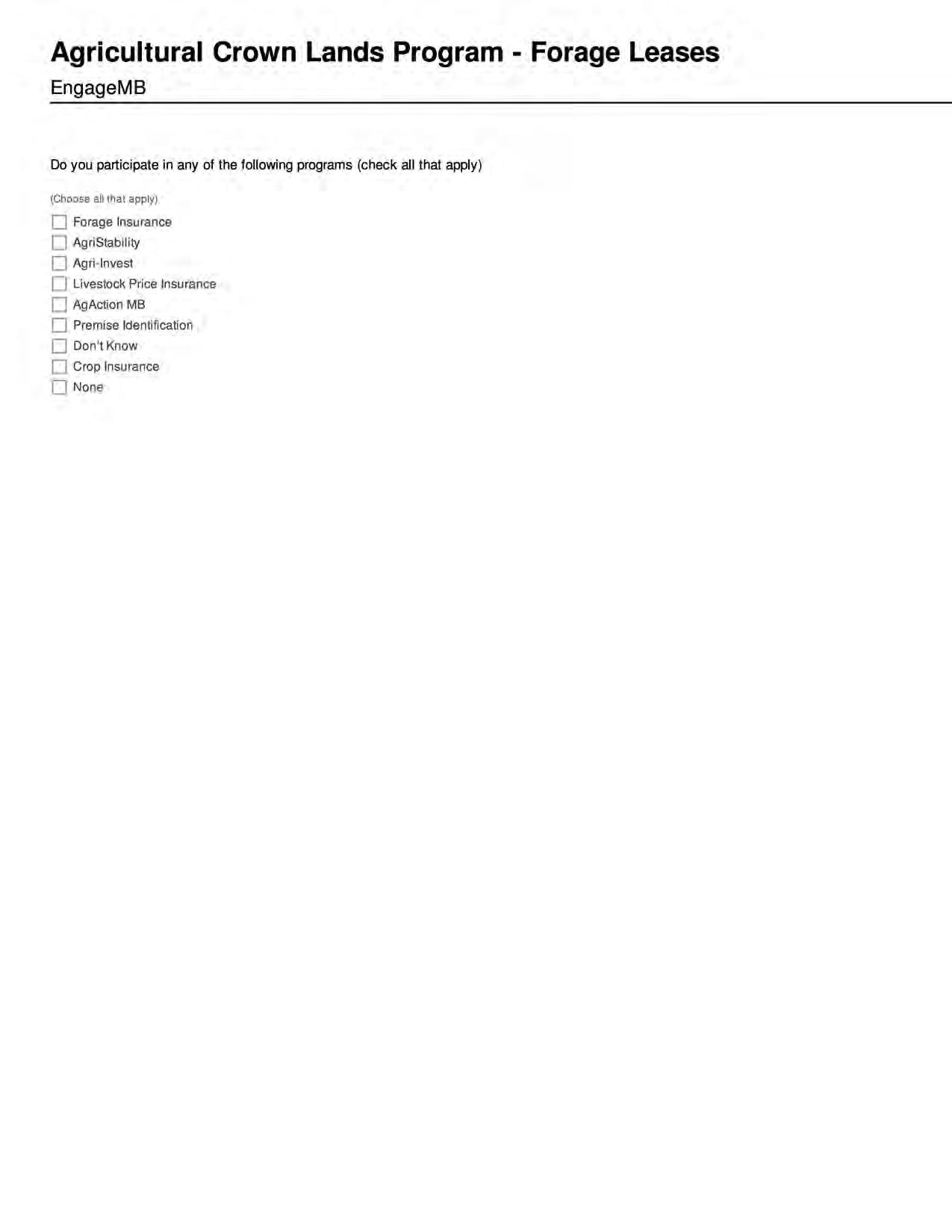
Rent: Forage lease rents are based on a formula that includes the productivity of the land (i.e AUM) and the 3 year average price of beef Specifically , rent is calculated as 3 5% of the 3 year average price of cattle for each cow/calf pair
Lease : Subletting a forage lease (or transferring a lease to someone else) is currently allowed under special circumstances
Which of the following options would you prefer to determine forage lease rents :
(Choose any one option)
D The current formula based on productivity of the land and the 3 year average price of beef. D Rent set by bid at auction (no formula) with an annual inflationary adjustment. D Don'tknow D Other
Answer this question only if you have chosen Other for Which of the following options would you prefer to determine forage lease rents :
Please specify :
Do you support allowing lease holders to sublet (or transfer) a lease to someone else?
(Choose any one option) D Yes 0 No Answer this question only if you have chosen Yes for Do you support allowing lease holders to sublet (or transfer) a lease to someone else?

Should leaseholders be allowed to sublet (or transfer) a lease under any circumstance, or only special circumstances?
(Choose any one option) D Lease holders should be able to sublet (or transfer) a lease at any time for any reason D Lease holders should only be able to sublet (or transfer) a lease under special circumstances D Don 'tknow
Answer this question only if you have chosen Lease holders should only be able to sublet (or transfer) a lease under special circumstances. for Should leaseholders be allowed to sublet (or transfer) a lease under any circumstance, or only special circumstances?
Please specify :
Agricultural Crown lands under a forage lease must be actively managed to maintain productivity (i.e AUM ratings must remain consistent over time), which is a requirement of the lease agreement.
To what degree do you understand how the department determines productivity (or AUM ratings) of the land? Check one : (Choose any one option) D Completely understand how MB AGR determines productivity (or AUM ratings) D Somewhat understand how MB AGR determines productivity (or AUM ratings) D Do not understand how MB AGR determines productivity (or AUM ratings)
Answer this question only if you have not chosen Completely understand how MB AGR determines productivity (or AUM ratings) for To what degree do you understand how the department determines productivity (or AUM ratings) of the land? Check one : What could we do to help you understand the process better? Please check all that apply (Choose all that apply) D Training courses or webinars D Printed materials, like a guide book

Through your commodity association
In person through our AGR representative
How likely would you be to invest in productivity improvements (for example , cross fencing, watering systems, rejuvenating forage stands , managing bush encroachment) if :
Very Somewhat Neitherlikely or Not very Not at all Questions likely likely unlikely likely likely
If your leaseterm could be extended to 20 years (from the current 15 years)
If the province shared in the cost of the improvements
If the province owned the improvements afterward
If there was predictability on the market value at the end of the leaseterm
If the province provided extension servicesto help develop long term management plans
If subletting (ortransferring alease) were madeavailable/easier
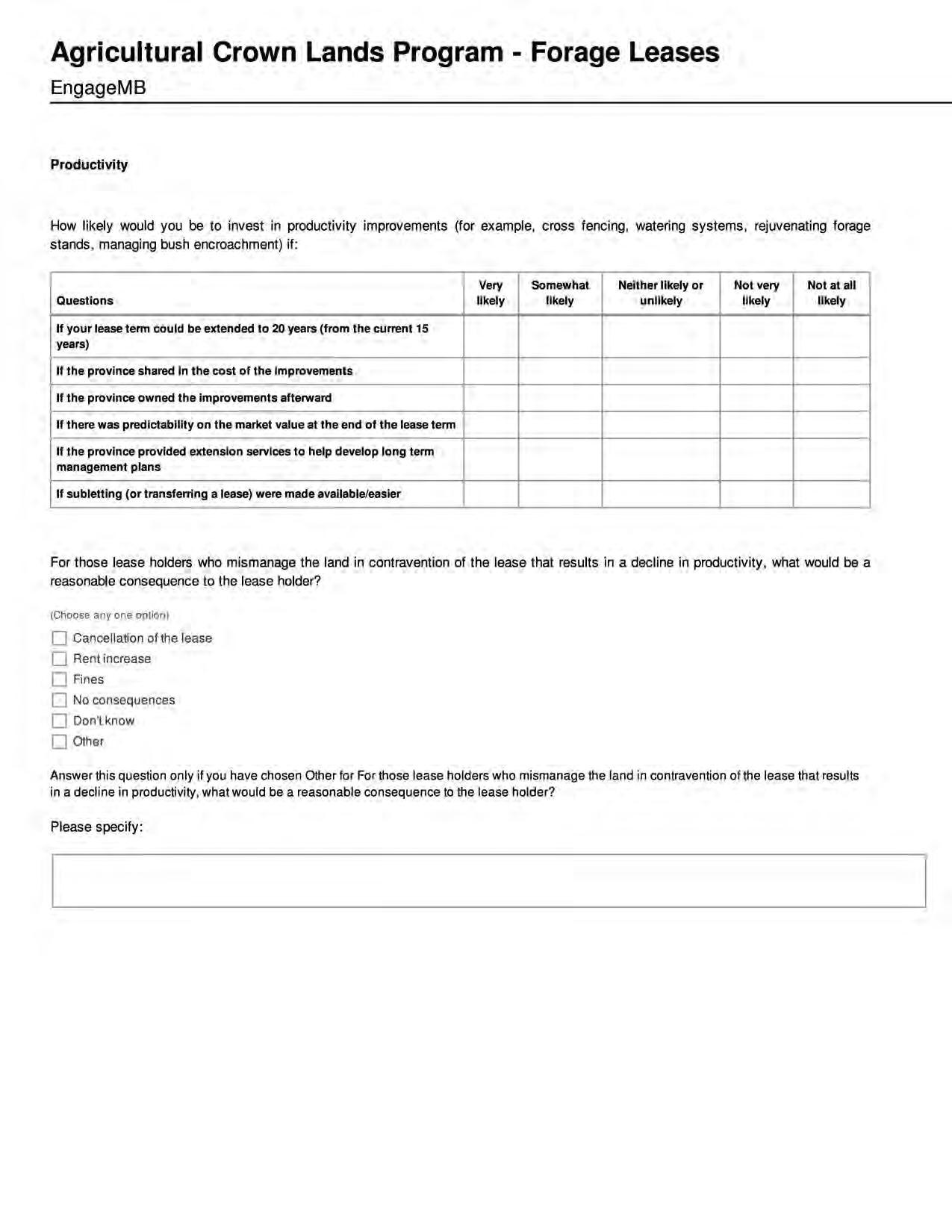
For those lease holders who mismanage the land in contravention of the lease that results in a decline in productivity , what would be a reasonable consequence to the lease holder? (Choose any one option)
Cancellation of the lease
Other Answer this question only if you have chosen Other for For those lease holders who mismanage the land in contravention of the lease that results i n a decline in productivity, what would be a reasonable consequence to the lease holder? Please specify :
After an auction, the current process of transferring the crown land improvements from the outgoing lease holder to the incoming lease holder is a negotiation between the parties If a reasonable price cannot be agreed to by negotiation, the parties may go to formal arbitration via The Arbitration Act.
Have you ever participated in this process of negotiating a price to transfer the improvements?
(Choose any one option) D Yes 0 No
Answer this question only if you have chosen Yes for Have you ever partic ipated in this process of negotiating a price to transfer the improvements?
Were you the incoming or outgoing leaseholder?

(Choose any one option) D Incoming D Outgoing
Answer this question only if you have chosen Yes for Have you ever partic ipated in this process of negotiating a price to transfer the improvements?
How satisfactory was the outcome?
(Choose any one option) D Very satisfactory D Somewhat satisfactory D Somewhat unsatisfactory D Not at all satisfactory D Don'tknow
Answer this question only if you have not chosen Very satisfactory for How satisfactory was the outcome? Why was the outcome not satisfactory?
There are several ways that improvements to crown land could be valued to determine a price between outgoing and incoming lease holders Of the below options, please rank your preference :
{Rank each option)
__ Third party appraisal of the market value before auction
__ Third party appraisal of the market value after auction
__ Standard listing of values which would determine in advance the price to be paid for the improvements.
__ The current process of negotiation
__ The value of the listed improvements should be determined by bid at the auction
Are there additional options that should be considered that are not specified in the question above?

Customer Service
A list of land that will be available for auction are typically released in October. Auctions for AGL are typically held in November. Forage lease rent invoices are sent to lease holders in November with rent due in December. Some farmers have said they would like to see a land listing for auctions sooner to allow time to inspect the land for which they may choose to place a bid. In some cases, land listings are delayed due to the department's generous non-payment policy. In the case of non payment of rent, how much time should lapse before a forage lease is cancelled? (Choose any one option)
1 month
2 months
3 months
4 months
5 months
6 months
More then 6 months How well do you understand your annual rent invoice? (Choose any one option)
Fully understand the invoice
Somewhat understand the invoice.
Don 't understand the invoice Answer this question only if you have chosen Don't understand the invoice . for How well do you understand your annual rent invoice? Why do you not fully understand the invoice Please check all that apply (Choose all that apply)
Terminology is complex
Too much information
Not enough information
You don 't read the invoice
Other Answer this question only if you have chosen Other for Why do you not fully understand the invoice Please check all that apply Please specify How do you want to receive information on programs and services related to the AGL? Please check all that apply (Choose all that apply)
Through your commodity and/or farm association
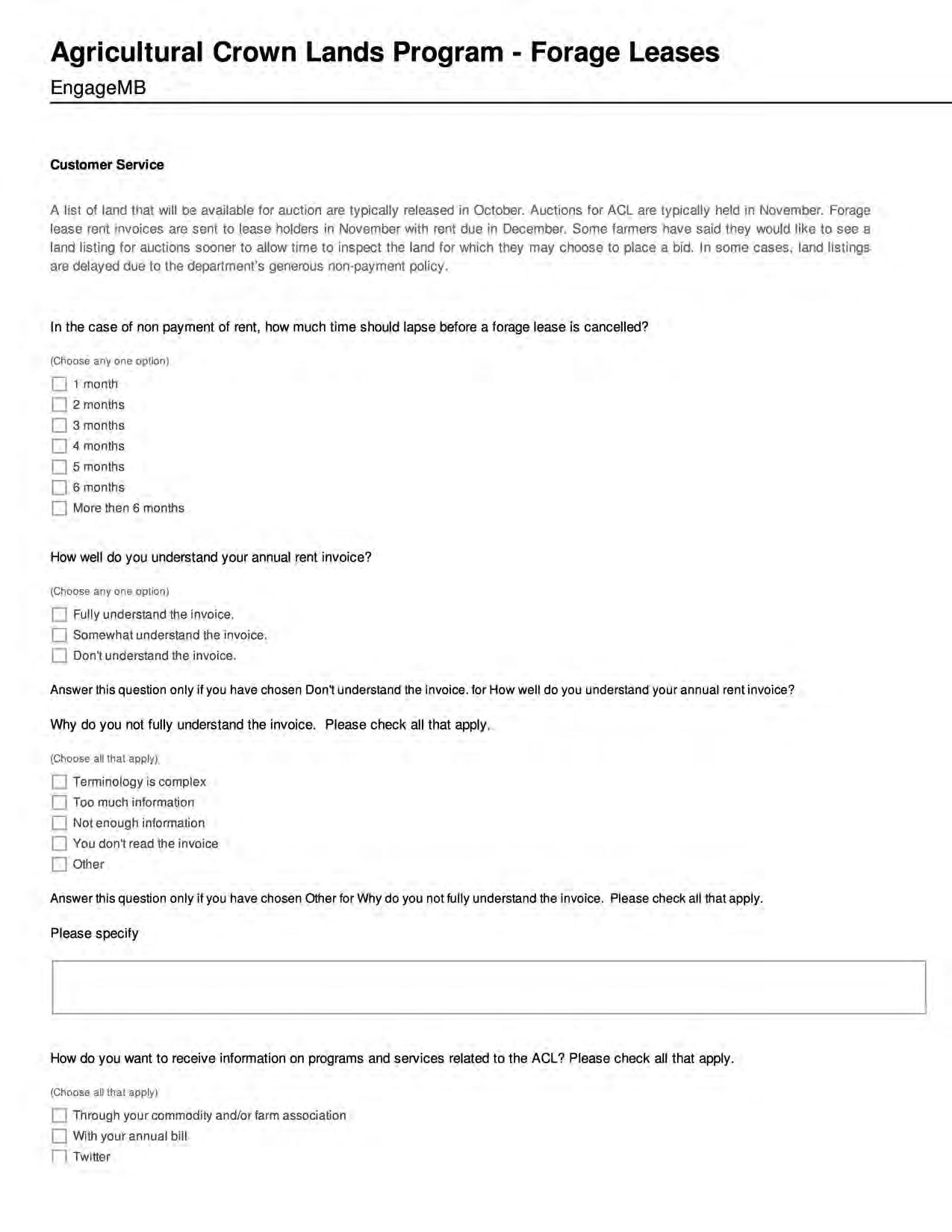
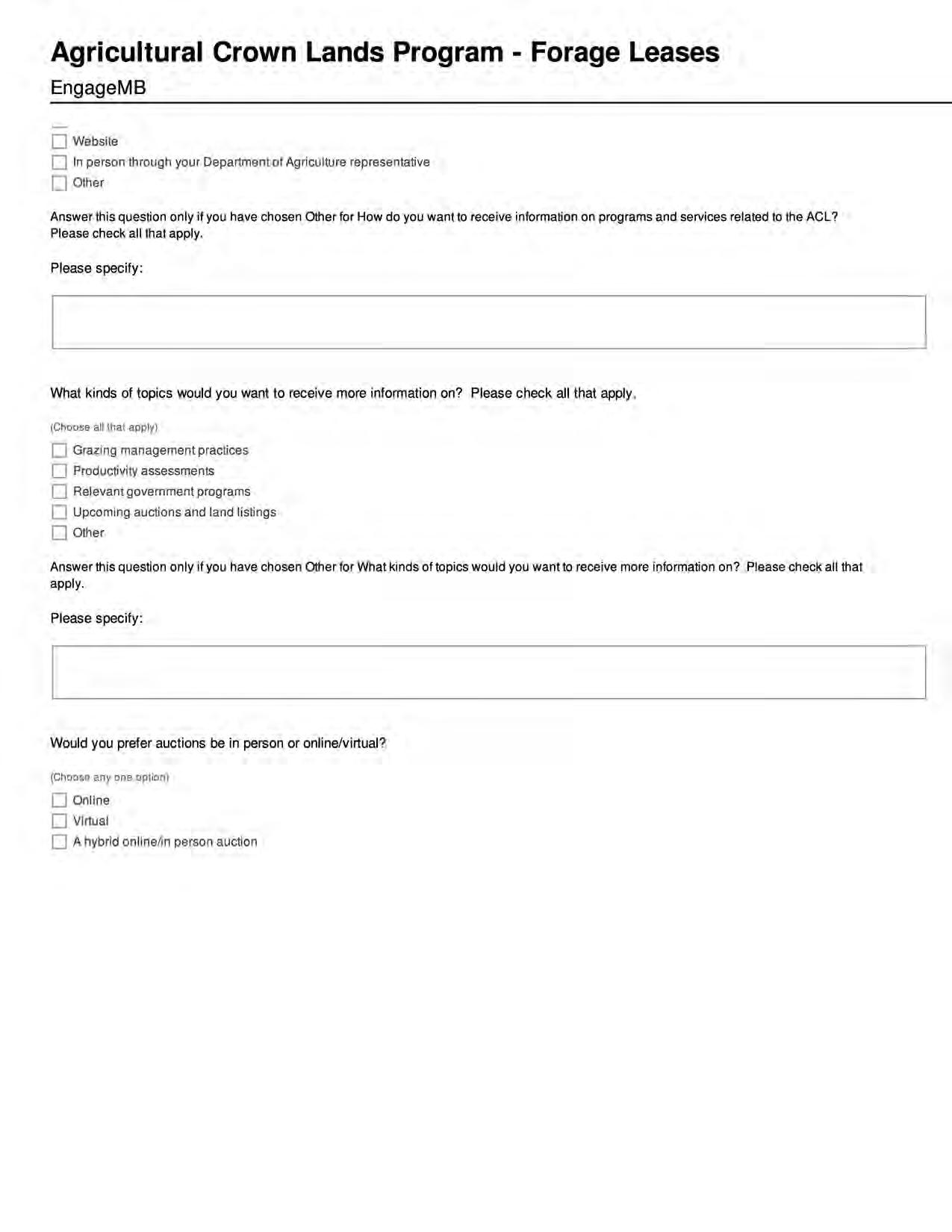

How often do you communicate with your Department of Agriculture representative?
(Choose any one option) 0 Weekly 0 Monthly D 2-3 times per year
Once per year
Less then once per year
How interested would you be in working with a Department of Agriculture representative to develop long-term management plans for your ACL?
(Choose any one option) D Very interested
Somewhat interested
Neutral/don't know
Not very interested D Not at all interested
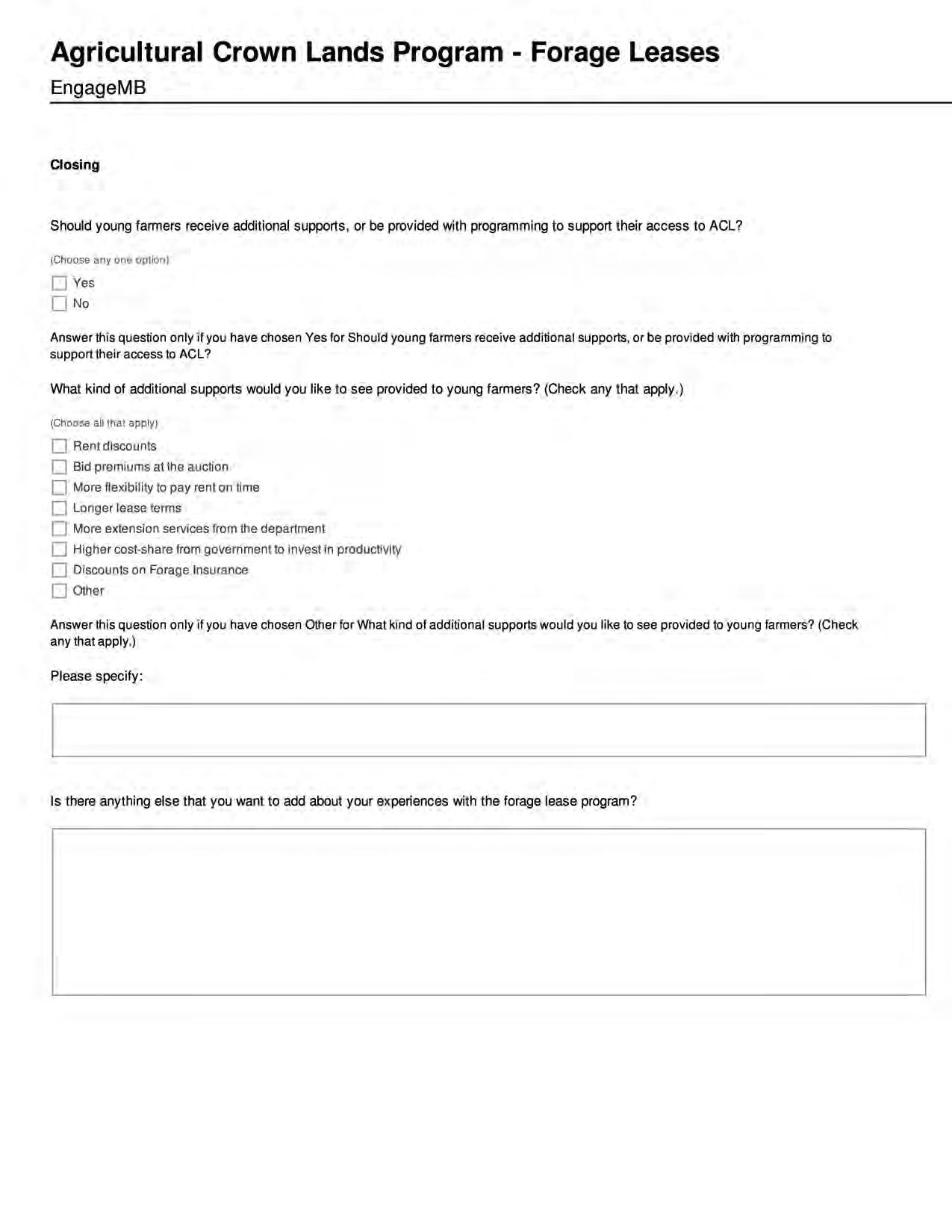
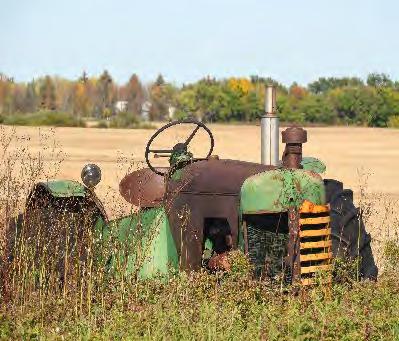
Manitoba Agriculture staff will lead free workshops on how to search and find the information you need on the Manitoba Agriculture website. Learn how to:
• find financial assistance information
• fill out online applications
• save, attach and email online applications
• navigate through the site in general
Evening workshops run from: 5 p.m. to 6:30 p.m. or 7 p.m. to 8:30 p.m.
Tue, Nov 8, 2022 Gimli, MB
East Interlake Watershed District Office, 74 First Ave
Thur, Nov 10, 2022 - Ashern, MB
Fieldstone Ventures Education, 61 Main Street.
Tue, Nov 15, 2022 - Swan River, MB
Swan Lake Watershed District Office, 559 4th Ave N.
Thur, Nov 17, 2022 - Inglis, MB
Assiniboine West Watershed Office, Building 211, P.R.# 366.
Mon, Nov 21, 2022 - Virden, MB
Virden Provincial Building, 247 Wellinton Street W.
Wed, Nov 23, 2022 - Deloraine , MB
Souris River Watershed Distict Office, 102 Broadway St. S.
Fri, Nov 25, 2022 Holland, MB
Redboine Watershed District Office, 109 Broadway Street.
Tue, Nov 29, 2022 Carberry, MB
MB Crop Dive rsification Centre, Jct of Hwys #1 and #5, N on #5.
Thur, Dec 1, 2022 - Vita, MB
RM of Stuartburn Office, 108 Main St.
Wed, Nov 9, 2022 Lundar, MB
West Interlake Watershed District Office, 9 Main Street.
Mon, Nov 14, 2022 - The Pas, MB
The Pas Provincial Building, 3rd St and Ross Ave
Wed, Nov 16, 2022 - Ethelbert, MB
Inter-Mountain Watershed District Office, P.R. # 274.
Fri, Nov 18, 2022 - Minnedosa, MB Minnedosa United Church, 48 Main St. S.
Tue, Nov 22, 2022 - Reston, MB
Souris River Watershed District Office, 4th St & 4th Ave.
Thur, Nov 24, 2022 - Manitou, MB Pembina Valley Watershed District Office, 261 Main Street.
Mon, Nov 28, 2022 - Ochre River, MB Ochre River Community Hall, 401 Mann St

Wed, Nov 30, 2022 - Carman, MB MB Agriculture Carman, 65 3rd Ave NE.
Fri, Dec 2, 2022 - Steinbach, MB Roadhouse 52, 375 N Front Dr unit b
Registration is required as spaces are limited. For more information or to reserve your preferred location and time, call 1-844-769-6224, or email agriculture@gov.mb.ca
An update from MBP October 21, 2022 mbbeef.ca
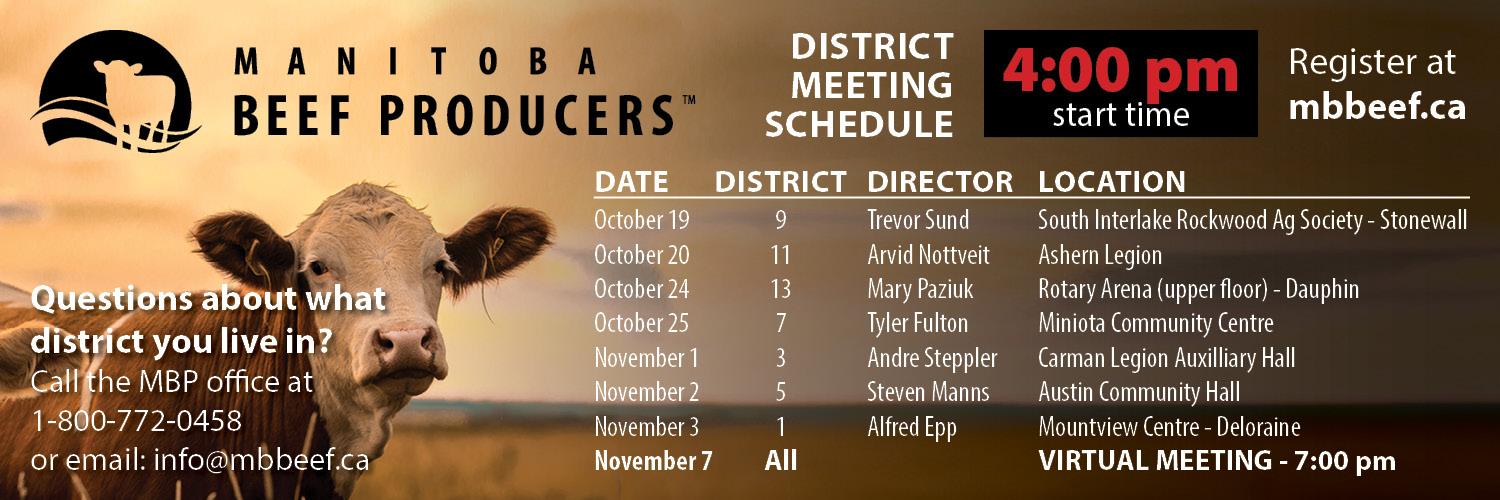

If you prefer, a hard copy of the survey is also found in this edition of the MBP e-newsletter on pages 9-21 along with a backgrounder on the program and changes made to it in recent years. MBP encourages producers to complete the survey online if at all possible so that the information is available to the provincial government as soon as possible.
Please mail hard copies of the completed survey to: Manitoba Agriculture
Producers are reminded that the Manitoba government has announced a consultation related to the Agricultural Crown Lands (ACL) Program and forage leases as part of is continuing review of the program.
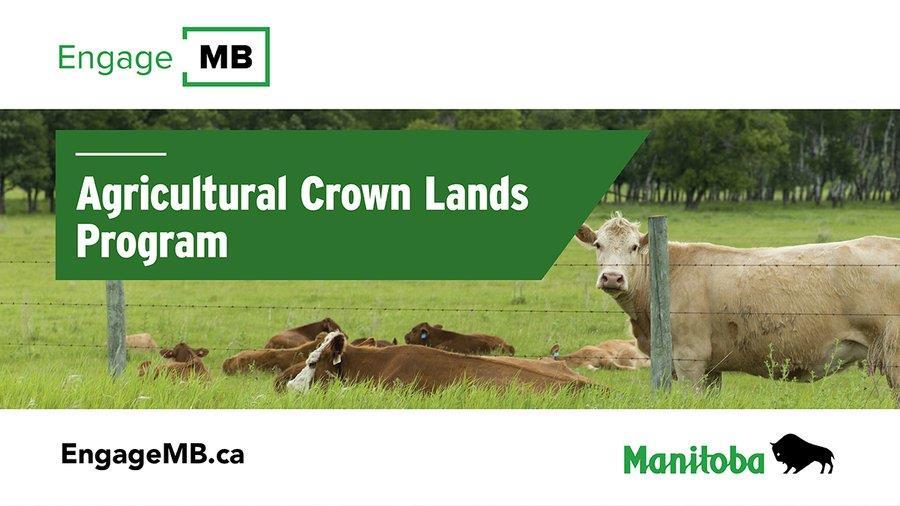
As per the province’s September 28 news release, “Manitoba Agriculture is exploring other policy, program, regulation and service improvements to enhance the productivity and sustainability of agricultural Crown forage lands including mechanisms for leaseholders to invest in productivity and adjustments to the terms and conditions of leases.
To participate in the online version of the survey visit http://engagemb.ca/agcl forage leases
ATTN: Marnie Carey 816 401 York Ave Winnipeg, MB R3C 0P8
As noted, the online survey closes on October 28, 2022, and have your hard copies of it mailed to the department by October 28 as well.
To read the news release where this consultation was announced (and which also refers to the provincial government implementing a temporary three year rent reduction for forage leases on agricultural Crown lands commencing in 2023) go to:
https://news.gov.mb.ca/news/index.html?item=56479&p osted=2022 09 28
Manitoba Beef Producers held in-person sessions in Stonewall and Ashern this week with updates on MBP activities, presentations, director elections as well as the resolutions and action items component of the meeting. For the full schedule of remaining meetings, look for the advertisement on page 1.


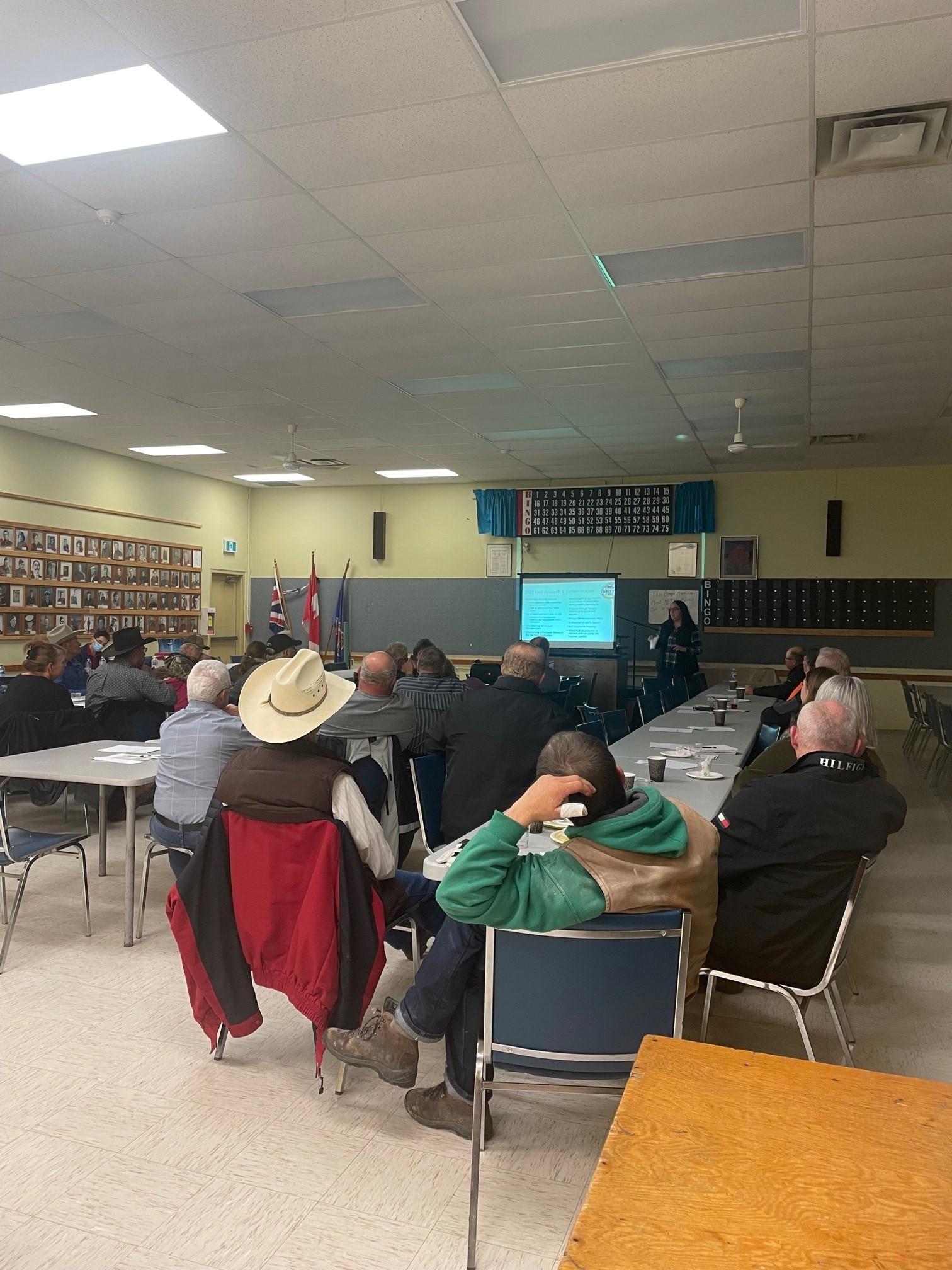
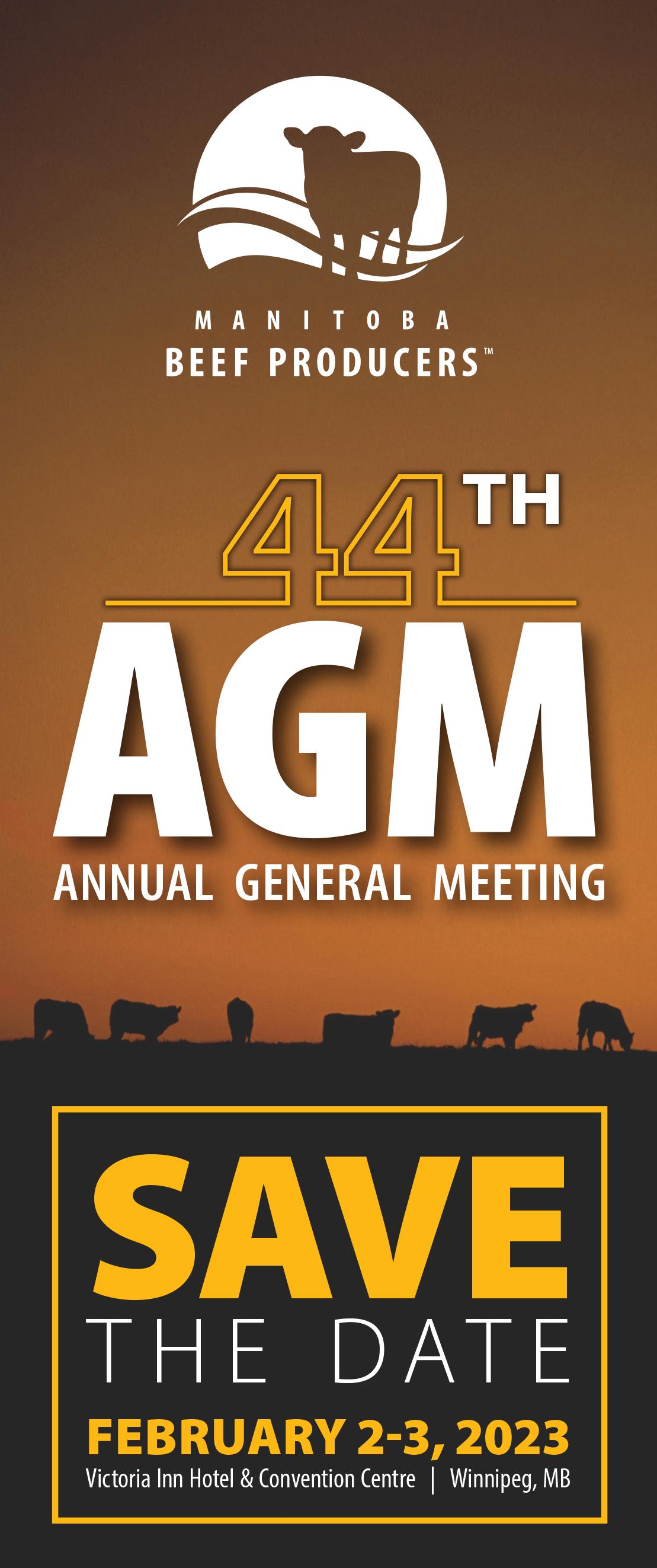
•
• SERVICES: Whetheryouareaspecialtyproducerlookingtoget yourproducttoaspecificmarketordistributor,orifyouareproducing commoditylivestockforsale,wecanpartnerwithyou.Fromour multi-speciescapabilitiestoourabilitytohandlesmallervolumes,we offerexcellentcapabilitiesforproducersintheCanadianPrairiesto maximizetheirprofitability.

• FACILITY: Wehaveastate-of-the-artfacilitytoallowusto reachmarketsacrossCanada,theUSA,andbeyond.Weunderstand producer'sneeds,theircarefortheiranimals,andtheirhonest, straightforwardnature.Callustohearhowwecanworktogethertoget yourproducttomarket.
 GRASSFED: "TrueNorthFoodsispartneredwithA&WCanada tosupplyCanadiangrassfedbeefforA&Wsgrassfedburgerprogram.
GRASSFED: "TrueNorthFoodsispartneredwithA&WCanada tosupplyCanadiangrassfedbeefforA&Wsgrassfedburgerprogram.
(October 18, 2022 Province of Manitoba News Release) The Manitoba government has launched a new Business Pathways website to support food and agri product entrepreneurs, businesses and organizations throughout all stages of the business life cycle, Agriculture Minister Derek Johnson announced during Small Business Week.
“Whether you have a new food product idea, you see an unmet demand for local food, or you want to grow a food business, the Business Pathways website can help you build your future in food,” said Johnson. “This comprehensive resource fosters economic development and provides the business management, product and process development and marketing support that new and existing agri food businesses need to effectively enter and compete in the domestic and global marketplaces.”
The new website incorporates resources, programs and services provided by business service providers and industry partners from the entire ecosystem.
The annual Small Business Week, an initiative of the Business Development Bank of Canada, runs from Oct. 16 to Oct. 22.
“I am especially pleased to announce this new resource during Small Business Week, as we celebrate the dedication and achievements of Manitoba entrepreneurs and small businesses,” said Johnson.
With an abundance of productive farmland, diverse commodities, state of the art research facilities, world class transportation infrastructure and a highly skilled labour force, Manitoba is an ideal place for food and beverage manufacturing, the minister noted. The Business Pathways website complements this business friendly environment by providing agri food businesses with tailored information and resources as they start up, build, grow and transition, Johnson added.
“Agriculture is a major driver of Manitoba’s economy and small businesses create many of our province’s skilled careers,” said Economic Development, Investment and Trade Minister Cliff Cullen. “Entrepreneurialism in the food space is exciting and innovative and offers great potential for growth and expansion. This new website will take out so much of the guesswork involved in launching, marketing and succeeding as a new business.”
For more information, visit www.manitoba.ca/foodbusiness.

ahead,” said Johnston. “This is an important improvement in Manitoba’s seasonal flu campaign. Fall is a great time to commit to wellness and a healthy, virus free winter, so I would encourage all Manitoba seniors to schedule a vaccine appointment as soon as possible.”
(October 17, 2022 Province of Manitoba News Release) The Manitoba government is reminding Manitobans to embrace winter wellness by getting a flu vaccine as soon as possible, Health Minister Audrey Gordon and Seniors and Long Term Care Minister Scott Johnston announced.
“Flu cases tend to peak over the fall and winter months in Manitoba, but there are things that we can all do to protect ourselves,” said Gordon. “Winter wellness means getting your flu vaccine, while also taking time to stay active, eat healthy meals and keep connected with the people you care about. To provide the strongest protection available to protect older Manitobans, this year our government expanded the eligibility of the high dose influenza vaccine to include all people 65 and over.”
Anyone aged six months and older is eligible for the flu vaccine. Beginning this year, the Manitoba government has also expanded eligibility for the high dose influenza vaccine to include all people aged 65 years and older. This type of vaccine offers the strongest protection available against the flu for people who are at greater risk of severe illness, which includes older people. Previously, it was only available to older individuals who lived in remote northern communities, personal care homes or other group facilities.
“Expanding eligibility for the high dose influenza vaccine will help people aged 65 and older in Manitoba stay healthy and active in the months

“Vaccination is one of the best tools we have to help reduce the spread and severity of respiratory viruses, like the flu and COVID 19,” said Dr. Brent Roussin, chief provincial public health officer. “Public health encourages all Manitobans to be up to date on all of the vaccines you’re eligible for. You can layer on even more protection by washing your hands, staying home when you’re sick and covering your cough. These simple steps will help to keep us all healthier and protect our health care system for those who need it most.”
The high dose and regular flu vaccine are available at no cost. Last year, more than 400,000 doses of flu vaccine were given to people in Manitoba, or about 29 per cent of the eligible population. The Pneu P 23 vaccine, which helps protect against pneumococcal disease, is also offered free of charge to people aged 65 and older. It can be administered at the same time as other vaccines and is often available at many of the same locations.
The flu vaccine is now widely available across the province. To find a location with the flu vaccine, use the online vaccine finder at https://protectmb.ca/current immunization sites/ Appointments at regional clinics can be made online or by calling 1 844 626 8222 (1 844 MAN VACC). People can also contact medical clinics and pharmacies directly to schedule vaccinations. Walk ins may also be available at many locations.
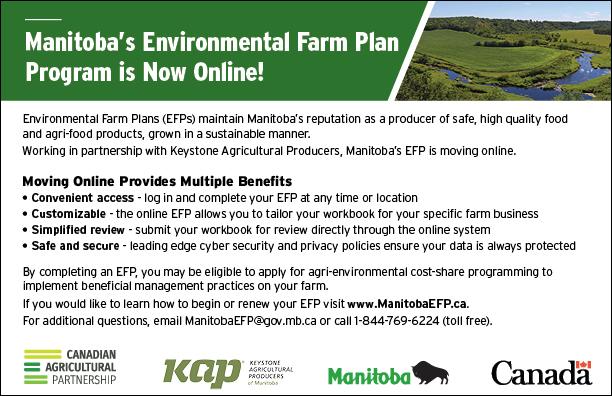
The Manitoba government has updated how vaccination appointments are booked using the online booking tool or the call centre to help make it simpler going into the fall season. Individuals make a generic vaccination appointment, based on their age, and then can receive an approved COVID 19 vaccine, seasonal flu vaccine, or both at the appointment.
It is safe and effective to get a flu or pneumococcal vaccine and a COVID 19 vaccine at the same time. However, the National Advisory Committee on Immunization has a precautionary recommendation for children aged six months to four years to leave a 14 day
interval between the COVID 19 vaccine and other vaccines including the flu vaccine. Parents and guardians of children in this age group should speak with their health care provider if a child is already scheduled or has received a seasonal flu or other childhood immunization before getting a COVID 19 vaccine.
An advertising campaign launches this week to highlight the importance of the seasonal flu vaccine as part of overall winter wellness.
For more information about seasonal flu, visit https://protectmb.ca/seasonal flu/ or https://www.gov.mb.ca/health/flu/
(October 19, 2022 Province of Manitoba News Releases) The Manitoba government is continuing to improve the functionality and reliability of provincial highways, with more than $60 million being invested to upgrade Provincial Road (PR) 201 from PR 200 to PR 302, Manitoba Transportation and Infrastructure Minister Doyle Piwniuk announced here.
“Our government recognizes the efficient transportation of goods is an integral part of Manitoba’s economy and the provincial highway network plays a critical role in enabling market access,” said Piwniuk. “As the only east west provincial route serving the Municipality of Emerson Franklin and the rural municipalities of Stuartburn and Piney, PR 201 is an important highway in the region.”
The highway is currently subject to Level 1 spring road restrictions, which restricts the maximum axle weight for vehicles to 90 per cent of normal loading in order to protect pavement in vulnerable conditions. While spring road restrictions are in effect, heavy vehicles may need to take alternate routes or haul multiple smaller loads.
As part of the government’s Trade and Commerce Grid initiative, the section of the highway from PR 200 to PR 302 will be upgraded to Manitoba’s heaviest regulated loading classification to accommodate heavy
commercial loads year round in order to support improved market access and efficient transportation of goods.
Upgrades on PR 201 from Provincial Trunk Highway (PTH) 59 to PR 302 are expected to start in 2025/26, with a project cost of $27.7 million. Further upgrades on the highway from PR 200 to PTH 59, at the cost of $33.5 million, are expected to start the following year, the minister added.
“This upgrade is a significant and welcomed infrastructure project for our region,” said Monique Chenier, economic development manager for Sunrise Corner, a partnership of the RMs of Piney and Stuartburn. “This investment in rural communities and people will enable our local farmers, retailers and manufacturers to be more competitive and grow their businesses to benefit our region and all of Manitoba.”
The minister noted PTH 59 is currently being upgraded from the U.S. border to PTH 52 to accommodate heavier commercial loads. That project will be completed this fall, weather permitting.
To learn more about Manitoba’s Multi Year Highways Investment Strategy visit: www.gov.mb.ca/mit/myhis/index.html.
(October 18, 2022 Department of Finance Canada News Release) Today, Bill C 30, the Cost of Living Relief Act, No. 1 (Targeted Tax Relief), received Royal Assent, doubling the Goods and Services Tax Credit for six months to help make life more affordable for millions of Canadians.
Eligible Canadians who already receive the GST Credit will automatically receive their payments starting in early November.
This means that Canadians without children will receive up to an extra $234 and couples with two children will receive up to an extra $467 this year. Seniors will receive an extra $225 on average.
Bill C 30 is the first of two pieces of legislation introduced this fall to support Canadians with the rising cost of living without adding fuel to the fire of inflation. Bill C 31, the Cost of Living Relief Act, No. 2 (Targeted Support for Households), which is still before Parliament, would enact two further affordability measures: the Canada Dental Benefit and a one time top up to the Canada Housing Benefit
In addition to Bill C 30 and Bill C 31, the government’s Affordability Plan is already delivering targeted and fiscally responsible financial support to the Canadians who need it most, with particular emphasis on addressing the needs of low income Canadians who are most exposed to inflation.
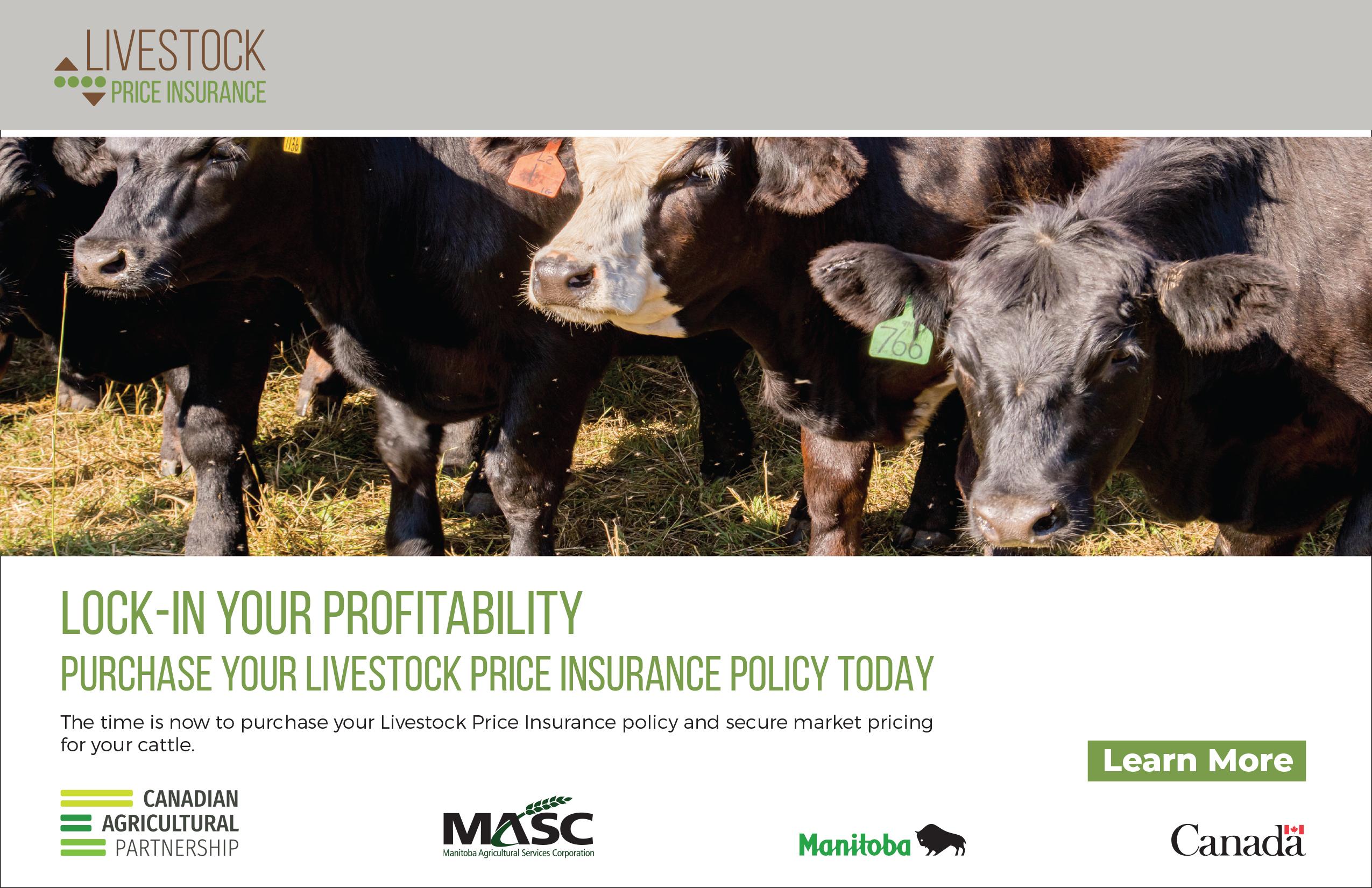

Manitoba Agriculture has heard from forage lease holders through their letters and through various meetings. Several concerns were raised about rents, lease terms and conditions, land productivity, and programs/services. The following discusses current policies on ACL.
Forage rents are calculated using a market based formula in regulation: 3.5% of the market price of beef x the number of cows that the land can sustain (i.e. “animal unit months”, or AUMs, which is a measure of the productivity of the land). Forage lease rent is A x B x 3.5% (where A = AUM, B = price of cattle).
Previously, rents were frozen at artificially low rates since 2014, at about $2/AUM, and were based on a triennial survey. Lessees are currently paying $7.19/AUM, or about $48 for 5 months of feed per cow calf pair (for reference Saskatchewan 2022 grazing rates are $8.18 per AUM).
Rental rate transition: In 2019, the rental rate remained at $2.13 per AUM. In 2020, the rental rate was the average of the 2019 rate and the amount described in the formula. In 2021 and thereafter, the rent is determined using the formula. In addition, rent is now payable by December 31, rather than at the end of the production year as had been the practice in the past.

Forage lease terms are 15 years. Those who had forage leases prior to 2019 (i.e. “legacy leaseholders”) can transfer their lease to immediate family members only in perpetuity. For partnerships and corporations, leases obtained prior to 2019 can be transferred to an existing ownership interest in the partnership or corporation in perpetuity.
Leaseholders may surrender their lease at any time without penalty. Surrendering only a portion of a lease can be considered on a case by case basis, depending on the land use impacts and other considerations.
Lifetime leases can no longer be transferred to a third party. This is called a unit transfer. Typically, this involves the transfer of a lifetime ACL lease along with the sale of a farmer’s private property to a non family member. However, those with forage leases prior to 2019 may transfer their leases to immediate family members in perpetuity.
AUM ratings are long term production averages. AUMs are not adjusted annually and are generally conservative. Lands are assessed for AUM using scientific methods based on region, soil type, type of vegetation and other conditions. AUM assessments are always conducted prior to Crown land auctions. Forage lessees are expected to manage the land to maintain or increase long term productivity. AUMs are not adjusted downward if leaseholders are not actively maintaining the land, including controlling encroachment. AUMs are a key part of rent calculations: rent is calculated as 3.5% of the market price of cattle per AUM.
When leaseholders make investments to improve ACL productivity, by policy, Manitoba will not increase AUM assessments on those lands for 10 years.
The 2021 ACL Forage Productivity Pilot Program (ACLFPPP) (75% government funded and 25% applicant funded) funded projects related to forage management techniques to improve productivity and sustainability on Crown land. ACL productivity improvements resulting from the ACLFPPP may not be reflected in AUM assessments for 5-10 years, meaning rents would not be increased due to the improvements. In the pilot, any improvements are owned by lessees. Many years ago, Manitoba offered a Crown Land Improvement Program (CLIP) for leaseholders to develop Crown lands for the purposes of cattle production. CLIP acres are a large part of existing ACLP lands. AUMs on CLIP acres are assessed based on their productivity potential; the onus is on the leaseholder to maintain productivity, for example by limiting encroachment. In cases where the land has not been adequately maintained over the years, resulting in the need for significant redevelopment, there can be delays for the permissions required from the Department to complete this type of work, due to the need for consultations and permits.
The value of improvements on forage leases is settled privately between outgoing and incoming leaseholders within 30 days of the auction. If agreement cannot be reached, the matter is referred to formal arbitration under The Arbitration Act. This is a new system that is relatively untested.
In situations where a leaseholder walks away from a lease and improvements, and they revert to the Crown, the value is known prior to the allocation process, and the value is paid to the Crown at the time of allocation.
Auctions are held in November, in the year prior to use, for various locations throughout the province, with advertisements placed in local newspapers and online, at least 30 days prior to the auction date. Payments must be made in full at the auction, including all of the first year’s rent and local taxes, and any other fees that may be known for the parcel of land.
The Department moved to online auctions during the pandemic. Sometimes, releasing the list of land to be auctioned is delayed due to the department’s generous cancellation policy for non payment. Cancelled and surrendered leases are put on the notification list to First Nations for Treaty Land Entitlement selection prior to auction.
Are you an active AGL forage lease holder? (Choose anyone option)
Did you obtain your forage lease prior to 2019? (Choose anyone option)
Have you ever held an AGL lease? (Choose anyone option)
Do you intend to hold an AGL lease at some point in the future? (Choose anyone option) D Yes


Rent: Forage lease rents are based on a formula that includes the productivity of the land (i.e AUM) and the 3 year average price of beef Specifically , rent is calculated as 3 5% of the 3 year average price of cattle for each cow/calf pair
Lease : Subletting a forage lease (or transferring a lease to someone else) is currently allowed under special circumstances
Which of the following options would you prefer to determine forage lease rents :
(Choose any one option)
D The current formula based on productivity of the land and the 3 year average price of beef. D Rent set by bid at auction (no formula) with an annual inflationary adjustment. D Don'tknow D Other
Answer this question only if you have chosen Other for Which of the following options would you prefer to determine forage lease rents :
Please specify :
Do you support allowing lease holders to sublet (or transfer) a lease to someone else?
(Choose any one option) D Yes 0 No Answer this question only if you have chosen Yes for Do you support allowing lease holders to sublet (or transfer) a lease to someone else?

Should leaseholders be allowed to sublet (or transfer) a lease under any circumstance, or only special circumstances?
(Choose any one option) D Lease holders should be able to sublet (or transfer) a lease at any time for any reason D Lease holders should only be able to sublet (or transfer) a lease under special circumstances D Don 'tknow
Answer this question only if you have chosen Lease holders should only be able to sublet (or transfer) a lease under special circumstances. for Should leaseholders be allowed to sublet (or transfer) a lease under any circumstance, or only special circumstances?
Please specify :
Agricultural Crown lands under a forage lease must be actively managed to maintain productivity (i.e AUM ratings must remain consistent over time), which is a requirement of the lease agreement.
To what degree do you understand how the department determines productivity (or AUM ratings) of the land? Check one : (Choose any one option) D Completely understand how MB AGR determines productivity (or AUM ratings) D Somewhat understand how MB AGR determines productivity (or AUM ratings) D Do not understand how MB AGR determines productivity (or AUM ratings)
Answer this question only if you have not chosen Completely understand how MB AGR determines productivity (or AUM ratings) for To what degree do you understand how the department determines productivity (or AUM ratings) of the land? Check one : What could we do to help you understand the process better? Please check all that apply (Choose all that apply) D Training courses or webinars D Printed materials, like a guide book

Through your commodity association
In person through our AGR representative
How likely would you be to invest in productivity improvements (for example , cross fencing, watering systems, rejuvenating forage stands , managing bush encroachment) if :
Very Somewhat Neitherlikely or Not very Not at all Questions likely likely unlikely likely likely
If your leaseterm could be extended to 20 years (from the current 15 years)
If the province shared in the cost of the improvements
If the province owned the improvements afterward
If there was predictability on the market value at the end of the leaseterm
If the province provided extension servicesto help develop long term management plans
If subletting (ortransferring alease) were madeavailable/easier

For those lease holders who mismanage the land in contravention of the lease that results in a decline in productivity , what would be a reasonable consequence to the lease holder? (Choose any one option)
Cancellation of the lease
Other Answer this question only if you have chosen Other for For those lease holders who mismanage the land in contravention of the lease that results i n a decline in productivity, what would be a reasonable consequence to the lease holder? Please specify :
After an auction, the current process of transferring the crown land improvements from the outgoing lease holder to the incoming lease holder is a negotiation between the parties If a reasonable price cannot be agreed to by negotiation, the parties may go to formal arbitration via The Arbitration Act.
Have you ever participated in this process of negotiating a price to transfer the improvements?
(Choose any one option) D Yes 0 No
Answer this question only if you have chosen Yes for Have you ever partic ipated in this process of negotiating a price to transfer the improvements?
Were you the incoming or outgoing leaseholder?

(Choose any one option) D Incoming D Outgoing
Answer this question only if you have chosen Yes for Have you ever partic ipated in this process of negotiating a price to transfer the improvements?
How satisfactory was the outcome?
(Choose any one option) D Very satisfactory D Somewhat satisfactory D Somewhat unsatisfactory D Not at all satisfactory D Don'tknow
Answer this question only if you have not chosen Very satisfactory for How satisfactory was the outcome? Why was the outcome not satisfactory?
There are several ways that improvements to crown land could be valued to determine a price between outgoing and incoming lease holders Of the below options, please rank your preference :
{Rank each option)
__ Third party appraisal of the market value before auction
__ Third party appraisal of the market value after auction
__ Standard listing of values which would determine in advance the price to be paid for the improvements.
__ The current process of negotiation
__ The value of the listed improvements should be determined by bid at the auction
Are there additional options that should be considered that are not specified in the question above?

Customer Service
A list of land that will be available for auction are typically released in October. Auctions for AGL are typically held in November. Forage lease rent invoices are sent to lease holders in November with rent due in December. Some farmers have said they would like to see a land listing for auctions sooner to allow time to inspect the land for which they may choose to place a bid. In some cases, land listings are delayed due to the department's generous non-payment policy. In the case of non payment of rent, how much time should lapse before a forage lease is cancelled? (Choose any one option)
1 month
2 months
3 months
4 months
5 months
6 months
More then 6 months How well do you understand your annual rent invoice? (Choose any one option)
Fully understand the invoice
Somewhat understand the invoice.
Don 't understand the invoice Answer this question only if you have chosen Don't understand the invoice . for How well do you understand your annual rent invoice? Why do you not fully understand the invoice Please check all that apply (Choose all that apply)
Terminology is complex
Too much information
Not enough information
You don 't read the invoice
Other Answer this question only if you have chosen Other for Why do you not fully understand the invoice Please check all that apply Please specify How do you want to receive information on programs and services related to the AGL? Please check all that apply (Choose all that apply)
Through your commodity and/or farm association



How often do you communicate with your Department of Agriculture representative?
(Choose any one option) 0 Weekly 0 Monthly D 2-3 times per year
Once per year
Less then once per year
How interested would you be in working with a Department of Agriculture representative to develop long-term management plans for your ACL?
(Choose any one option) D Very interested
Somewhat interested
Neutral/don't know
Not very interested D Not at all interested


Name(s): Farm Name: Address:
Phone: Email: PLEASE ATTACH A WORD DOCUMENT WITH THE FOLLOWING INFORMATION:
1. Provide a description of your farm including the environment it operates in.
2. What have you done/what are you doing to improve environmental management on your farm?
3. What are your challenges and successes? Please include high-resolution images and data which help show measurable results.
4. What factors have enabled you to make management changes? (e.g. Working with conservation organizations, programs such as the Environmental Farm Plan, funding support, education, etc.)
5. What are your environmental goals for the future and how do you plan to carry them out?
6. Include two letters of reference that speak to your leadership in conservation.
Please limit your application to 10 pages (not including letters of reference and photos). Electronic applications are preferred and a single, complete PDF document is requested. A sample application from previous years can be found online at https://www.cattle.ca/sustainability/theenvironmental-stewardship-award/how-to-nominate/

Contact your provincial organization listed on the previous page to determine when your association requires you to submit your application for the provincial award.
A selection of no less than ten high-resolution images suitable for reproduction on social media, print etc.
Video presentation link if available, media stories/ broadcasts showcasing your stewardship efforts.
TESA sponsorship program is available to appropriate organizations that wish to affiliate themselves with the CCA’s TESA program. In addition to showing support for environmental stewardship and Canada’s beef cattle producers, the program also provides the opportunity to join industry leaders, government representatives and nearly 60,000 Canadian beef farms in the national discussion on environmental issues affecting the industry. For more information, visit www.cattle.ca/what-is-tesa



For more than 65 years, MNP has been helping beef producers get the most from their operations. Whether you are looking to pass the farm on to the next generation, improve your profitability, be more competitive or expand MNP’s beef industry specialists will help you get the results you’re looking for. To find out what MNP can do for you, contact Marvin Slingerland, Partner, MNP Lethbridge, at Director of Livestock Services at 1.800.661.8097 or Marvin.Slingerland@mnp.ca

Safely dispose of unwanted or obsolete agricultural pesticides and livestock/equine medications –no charge! Take them to the following locations on the dates noted between 9 a.m. and 4 p.m.
ARNAUD
Thursday, Oct. 27 G J Chemical Co. Ltd. 96 Smith Ave West 204-427-2337
BALDUR Friday, Oct. 28 Baldur Agro 121 2nd St 204-535-2598
BEAUSEJOUR
Wednesday, Oct. 26

Nutrien Ag Solutions 73010 Road 40 off Hwy 44 SE 10-13-7E 204-268-3497
BRANDON Thursday, Oct. 27 Richardson Pioneer 14 km west on Hwy 1, then 1/4 mile south on Pioneer Rd. 204-727-5353
BRUNKILD
Monday, Oct. 24 MK Agro 3062 Road 39 NW 204-736-4769
DAUPHIN Monday, Oct. 24 Dauphin Co-op AGRO 601 Whitmore Ave E 204-622-6080
DELORAINE Monday, Oct. 24
Nutrien Ag Solutions Hwy 3 & Broadway St. S 204-747-2877
GLADSTONE Monday, Oct. 24 Neepawa-Gladstone Coop Road 69, Hwy 16 (4 miles W of Gladstone) 204-385-2906
INGLIS
Wednesday, Oct. 26 Prairie Giants Crop Supply 2 km East of Hwy 83 on PR 366 204-564-2293
MEADOWS
Thursday, Oct. 27 Ag Advantage Ltd 68156 Road 6 W 204-322-5351
MELITA
Tuesday, Oct. 25 Cargill 7 km SW of Melita on Hwy 83 204-522-3221

PORTAGE LA PRAIRIE Friday, Oct. 28 Portage Agri-Sales 11 Can-Oat Dr 204-857-7838
RIVERS
Friday, Oct. 28 Redfern Farm Services 102 2nd Ave 204-328-5325
SHOAL LAKE Thursday, Oct. 27 Shur-Gro Farm Services Ltd. 236 Industrial Park Rd. 204-759-4240
ST. LEON Tuesday, Oct. 25 Pembina Coop 49079 Road 25N 204-744-2850
STANLEY Wednesday, Oct. 26 Cargill 12137 Road 25W 204-325-9551
STEINBACH
Friday, Oct. 28 Clearview Coop 33124 Road 39 N (at Hwy 12N, between Steinbach and Blumenort) 204-326-9921
SWAN RIVER Tuesday, Oct. 25 Cargill 2 miles south on Hwy 83 204-734-5747
TEULON
Tuesday, Oct. 25 Willis Agro 11034E Road 95N 204-461-0386
VIRDEN Wednesday, Oct. 26 Core Ag Inputs 320 Chester St. E 431-763-3536
The proper nutrition of beef cattle is a key component of a successful production system. Feed usually accounts for the single largest input cost associated with beef cattle. Find out more about how to feed your animals successfully and at a low cost.
Date: Wednesday, November 2, 2022
Time: 10 a.m. to 3 p.m.
Place: Manitoba Beef and Forage Initiatives Farm

Corner of highway 353 and #10 north of Brandon
Cost is $20 per person. Call Manitoba Agriculture at 204-648-3965 to pre-register
Agenda

10 a.m. The Silage How-to Guide for Livestock Producers
Dr. John McKinnon, JJM Nutrition, Saskatoon, SK
11 a.m. Getting a Handle on Feed Costs
Ben Hamm Farm Business Management Specialist, Manitoba Agriculture, Steinbach
LUNCH
1 p.m. Beef Cattle Nutrition - Cow and backgrounder rations
Dr. John McKinnon, JJM Nutrition, Saskatoon, SK
2 p.m. Alternative Feeds for Feeding the Cow Herd
Shawn Cabak Livestock and Forage Extension Specialist

Manitoba Agriculture, Portage
2:30 p.m. Cowbytes Nutritional Program for Beef Cattle
Elizabeth Nernberg - Livestock and Forage Extension Specialist
Manitoba Agriculture, Roblin
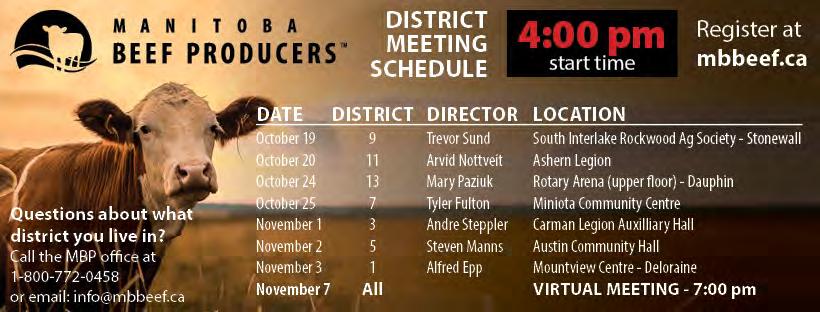
from MBP October 14, 2022 mbbeef.ca
In 2020, the governments of Canada and Manitoba invested $990,000 through the Canadian Agricultural Partnership in a three-year contribution agreement with Keystone Agricultural Producers (KAP) to develop the online EFP platform.
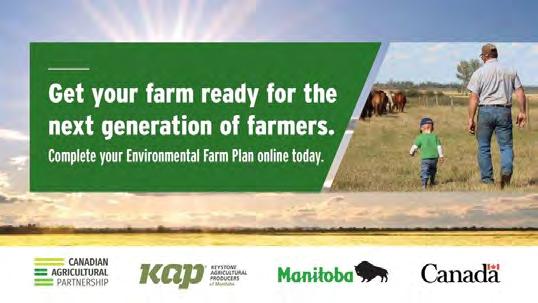
The EFP is a voluntary, confidential self-assessment of a producer’s farm. The purpose of the EFP is to assess the features and management practices of a farm in order to develop an action plan to mitigate identified risks.

(October 11, 2022 Joint Federal/Provincial News Release) The governments of Canada and Manitoba are announcing the launch of Manitoba’s new online Environmental Farm Plan (EFP) platform, federal Agriculture and Agri-Food Minister Marie-Claude Bibeau and Manitoba Agriculture Minister Derek Johnson announced.
“Canadian agriculture’s long-term sustainability depends on its ability to adapt to emerging climate conditions,” said Bibeau. “Manitoba’s new online Environmental Farm Plan allows producers greater access to resources, so they can prioritize best management practices that make the greatest impact on their farm.”
“Our government is committed to supporting sustainable agriculture production practices such as sustainable water strategies and climate change mitigation activities,” said Johnson. “The EFP is a valuable and proactive risk management tool. It includes a strong educational component that will continue to provide positive environmental outcomes while enabling the province to meet its goals for enhancing public trust in the agricultural sector.”
•
• SERVICES: Whetheryouareaspecialtyproducerlookingtoget yourproducttoaspecificmarketordistributor,orifyouareproducing commoditylivestockforsale,wecanpartnerwithyou.Fromour multi-speciescapabilitiestoourabilitytohandlesmallervolumes,we offerexcellentcapabilitiesforproducersintheCanadianPrairiesto maximizetheirprofitability.
• FACILITY: Wehaveastate-of-the-artfacilitytoallowusto reachmarketsacrossCanada,theUSA,andbeyond.Weunderstand producer'sneeds,theircarefortheiranimals,andtheirhonest, straightforwardnature.Callustohearhowwecanworktogethertoget yourproducttomarket.
www.truenorthfoods.ca



The new online version of the EFP is modern, efficient and easy for producers to use and is designed with leading edge cybersecurity and privacy policies to ensure data is always protected. Online tutorials are available to guide producers through the process. The system has updated and streamlined content and several features that allow producers to customize EFP workbooks to specific farm operations. Once a workbook is complete, producers can submit it for third party review by KAP reviewers.
The online platform integrates national and international sustainable sourcing standards that will allow producers to address market requirements for specific commodity groups. This integration adds value to the Manitoba EFP and reduces the burden for producers, noted Johnson.
“KAP is pleased to have worked with both levels of government on delivering a tool that producers can confidently and easily use as they work to more easily employ sustainable farming practices in their operations,” said Bill Campbell, president, Keystone Agricultural Producers. “This new platform will help increase the accessibility of the EFP program for Manitoba producers and sends a strong signal to consumers about the efforts taken to deliver
sustainably grown agricultural products to the marketplace.”
A completed EFP is required for farms participating in most agri environmental cost shared programming, which directly supports initiatives of the Made in Manitoba Climate and Green Plan by enhancing the resilience and sustainability of the agricultural sector.
Johnson noted that by implementing an EFP, producers are able to improve air, water and soil quality, conserve biodiversity on Manitoba farmland, contribute to environmental protection and conservation, and make Manitoba grown commodities more marketable to environmentally conscious consumers.
More information on the EFP and a link to the online EFP portal can be found at www.ManitobaEFP.ca.
The Canadian Agricultural Partnership is a five year, $3 billion commitment by Canada's federal, provincial and territorial governments that supports Canada's agri food and agri products sectors. This includes a $2 billion commitment that is cost shared 60 per cent federally and 40 per cent provincially/territorially for programs that are designed and delivered by provinces and territories.
Manitoba Agriculture staff will lead free workshops on how to search and find the information you need on the Manitoba Agriculture website.

Learn how to:
• find financial assistance information
• fill out online applications

• save, attach and email online applications
• navigate through the site in general
Environmental Farm Plans (EFPs) maintain Manitoba’s reputation as a producer of safe, high quality foods, grown in a sustainable manner.
How it Works
1. Complete your EFP workbook online.
2. Submit your workbook online for a KAP Review.
3. Receive your Statement of Completion.
An EFP will help you:
• make Manitoba-grown commodities more marketable to environmentally-conscious consumers around the world
• meet sustainable sourcing requirements for select commodities
• become eligible to apply for beneficial management practices (BMP) cost share programs
• demonstrate due diligence by identifying environmental assets and risks on your farm and implementing actions to reduce those risks
• improve air, water and soil quality, and conserve biodiversity on Manitoba farmland
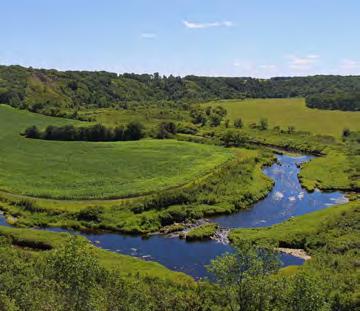

Visit www.ManitobaEFP.ca to complete your EFP today.
For additional questions, email ManitobaEFP@gov.mb.ca or call 1--844-769-6224 (toll free)

• You can access Manitoba’s Online EFP at www.ManitobaEFP.ca.
• If you do not have access to stable Internet or require assistance call 1-844-769-6224 (toll free).
• Create an account by clicking ‘Create Account’.
First Time User
• Verify your email address to complete account creation. Already have an Account
• Continue your work by clicking ‘Sign In’.
• Once you have logged in, click ‘Create an EFP’ and complete the Farm Business Profile This will allow the system to create a customized EFP workbook with chapters relevant to your farm operation.
• A navigation bar will guide you through the required steps to complete the workbook.

Save and ContinueSaveSkip to Next Required StepPrevious
• Your information will be saved as you proceed through the workbook. You can exit the system and return as needed.
• If you require assistance while you are completing your EFP, you can access the FAQ page (https://online.manitobaefp.ca/faq) or email questions to ManitobaEFP@gov.mb.ca.
• Once you have completed all required sections, you can submit your EFP workbook for review directly through the online system.
• A reviewer will contact you if they have specific questions.
• You will receive an email once your EFP workbook has been reviewed and approved.
• A link in the email will return you to the Online EFP where you can download your SOC and your completed EFP workbook. You may return to the Online EFP at any time to download these materials from the Producer Dashboard.
Reviewer: Johnny Reviewer - johnny.reviewer@kap.ca
Date Created: Sep 20, 2022 Statement of Completion Workbook PDF
Date Approved: Sep 20, 2022Expiry Date: Sep 20, 2027 Workbook Version: 4
Scorecard Renew Workbook
• Your SOC is valid for five years. Your information will be saved in the online system so that you can easily renew your EFP workbook, as needed.
The proper nutrition of beef cattle is a key component of a successful production system. Feed usually accounts for the single largest input cost associated with beef cattle. Find out more about how to feed your animals successfully and at a low cost.
Date: Wednesday, November 2, 2022
Time: 10 a.m. to 3 p.m.
Place: Manitoba Beef and Forage Initiatives Farm

Corner of highway 353 and #10 north of Brandon
Cost is $20 per person. Call Manitoba Agriculture at 204-648-3965 to pre-register
Agenda

10 a.m. The Silage How-to Guide for Livestock Producers
Dr. John McKinnon, JJM Nutrition, Saskatoon, SK
11 a.m. Getting a Handle on Feed Costs
Ben Hamm Farm Business Management Specialist, Manitoba Agriculture, Steinbach
LUNCH
1 p.m. Beef Cattle Nutrition - Cow and backgrounder rations
Dr. John McKinnon, JJM Nutrition, Saskatoon, SK
2 p.m. Alternative Feeds for Feeding the Cow Herd
Shawn Cabak Livestock and Forage Extension Specialist

Manitoba Agriculture, Portage
2:30 p.m. Cowbytes Nutritional Program for Beef Cattle
Elizabeth Nernberg - Livestock and Forage Extension Specialist
Manitoba Agriculture, Roblin
Producers are reminded that the Manitoba government has announced a consultation related to the Agricultural Crown Lands (ACL) Program and forage leases as part of is continuing review of the program.
As per the province’s September 28 news release, “Manitoba Agriculture is exploring other policy, program, regulation and service improvements to enhance the productivity and sustainability of agricultural Crown forage lands including mechanisms for leaseholders to invest in productivity and adjustments to the terms and conditions of leases.
To participate in the online version of the survey visit http://engagemb.ca/agcl forage leases
If you prefer, a hard copy of the survey is also found in this edition of the MBP e newsletter, along with a backgrounder on the program and changes made to it in recent years. MBP encourages producers to complete the survey online if at all possible so that the information is
available to the provincial government as soon as possible.
Please mail hard copies of the completed survey to:
Manitoba Agriculture
ATTN: Marnie Carey 816 401 York Ave Winnipeg, MB R3C 0P8
As noted, the online survey closes on October 28, 2022, and have your hard copies of it mailed to the department by October 28 as well.
To read the news release where this consultation was announced (and which also refers to the provincial government implementing a temporary three year rent reduction for forage leases on agricultural Crown lands commencing in 2023) go to: https://news.gov.mb.ca/news/index.html?item =56479&posted=2022 09 28

Manitoba Agriculture has heard from forage lease holders through their letters and through various meetings. Several concerns were raised about rents, lease terms and conditions, land productivity, and programs/services. The following discusses current policies on ACL.
Forage rents are calculated using a market based formula in regulation: 3.5% of the market price of beef x the number of cows that the land can sustain (i.e. “animal unit months”, or AUMs, which is a measure of the productivity of the land). Forage lease rent is A x B x 3.5% (where A = AUM, B = price of cattle).
Previously, rents were frozen at artificially low rates since 2014, at about $2/AUM, and were based on a triennial survey. Lessees are currently paying $7.19/AUM, or about $48 for 5 months of feed per cow calf pair (for reference Saskatchewan 2022 grazing rates are $8.18 per AUM).
Rental rate transition: In 2019, the rental rate remained at $2.13 per AUM. In 2020, the rental rate was the average of the 2019 rate and the amount described in the formula. In 2021 and thereafter, the rent is determined using the formula. In addition, rent is now payable by December 31, rather than at the end of the production year as had been the practice in the past.

Forage lease terms are 15 years. Those who had forage leases prior to 2019 (i.e. “legacy leaseholders”) can transfer their lease to immediate family members only in perpetuity. For partnerships and corporations, leases obtained prior to 2019 can be transferred to an existing ownership interest in the partnership or corporation in perpetuity.
Leaseholders may surrender their lease at any time without penalty. Surrendering only a portion of a lease can be considered on a case by case basis, depending on the land use impacts and other considerations.
Lifetime leases can no longer be transferred to a third party. This is called a unit transfer. Typically, this involves the transfer of a lifetime ACL lease along with the sale of a farmer’s private property to a non family member. However, those with forage leases prior to 2019 may transfer their leases to immediate family members in perpetuity.
AUM ratings are long term production averages. AUMs are not adjusted annually and are generally conservative. Lands are assessed for AUM using scientific methods based on region, soil type, type of vegetation and other conditions. AUM assessments are always conducted prior to Crown land auctions. Forage lessees are expected to manage the land to maintain or increase long term productivity. AUMs are not adjusted downward if leaseholders are not actively maintaining the land, including controlling encroachment. AUMs are a key part of rent calculations: rent is calculated as 3.5% of the market price of cattle per AUM.
When leaseholders make investments to improve ACL productivity, by policy, Manitoba will not increase AUM assessments on those lands for 10 years.
The 2021 ACL Forage Productivity Pilot Program (ACLFPPP) (75% government funded and 25% applicant funded) funded projects related to forage management techniques to improve productivity and sustainability on Crown land. ACL productivity improvements resulting from the ACLFPPP may not be reflected in AUM assessments for 5-10 years, meaning rents would not be increased due to the improvements. In the pilot, any improvements are owned by lessees. Many years ago, Manitoba offered a Crown Land Improvement Program (CLIP) for leaseholders to develop Crown lands for the purposes of cattle production. CLIP acres are a large part of existing ACLP lands. AUMs on CLIP acres are assessed based on their productivity potential; the onus is on the leaseholder to maintain productivity, for example by limiting encroachment. In cases where the land has not been adequately maintained over the years, resulting in the need for significant redevelopment, there can be delays for the permissions required from the Department to complete this type of work, due to the need for consultations and permits.
The value of improvements on forage leases is settled privately between outgoing and incoming leaseholders within 30 days of the auction. If agreement cannot be reached, the matter is referred to formal arbitration under The Arbitration Act. This is a new system that is relatively untested.
In situations where a leaseholder walks away from a lease and improvements, and they revert to the Crown, the value is known prior to the allocation process, and the value is paid to the Crown at the time of allocation.
Auctions are held in November, in the year prior to use, for various locations throughout the province, with advertisements placed in local newspapers and online, at least 30 days prior to the auction date. Payments must be made in full at the auction, including all of the first year’s rent and local taxes, and any other fees that may be known for the parcel of land.
The Department moved to online auctions during the pandemic. Sometimes, releasing the list of land to be auctioned is delayed due to the department’s generous cancellation policy for non payment. Cancelled and surrendered leases are put on the notification list to First Nations for Treaty Land Entitlement selection prior to auction.
Are you an active AGL forage lease holder? (Choose anyone option)
Did you obtain your forage lease prior to 2019? (Choose anyone option)
Have you ever held an AGL lease? (Choose anyone option)
Do you intend to hold an AGL lease at some point in the future? (Choose anyone option) D Yes


Rent: Forage lease rents are based on a formula that includes the productivity of the land (i.e AUM) and the 3 year average price of beef Specifically , rent is calculated as 3 5% of the 3 year average price of cattle for each cow/calf pair
Lease : Subletting a forage lease (or transferring a lease to someone else) is currently allowed under special circumstances
Which of the following options would you prefer to determine forage lease rents :
(Choose any one option)
D The current formula based on productivity of the land and the 3 year average price of beef. D Rent set by bid at auction (no formula) with an annual inflationary adjustment. D Don'tknow D Other
Answer this question only if you have chosen Other for Which of the following options would you prefer to determine forage lease rents :
Please specify :
Do you support allowing lease holders to sublet (or transfer) a lease to someone else?
(Choose any one option) D Yes 0 No Answer this question only if you have chosen Yes for Do you support allowing lease holders to sublet (or transfer) a lease to someone else?

Should leaseholders be allowed to sublet (or transfer) a lease under any circumstance, or only special circumstances?
(Choose any one option) D Lease holders should be able to sublet (or transfer) a lease at any time for any reason D Lease holders should only be able to sublet (or transfer) a lease under special circumstances D Don 'tknow
Answer this question only if you have chosen Lease holders should only be able to sublet (or transfer) a lease under special circumstances. for Should leaseholders be allowed to sublet (or transfer) a lease under any circumstance, or only special circumstances?
Please specify :
Agricultural Crown lands under a forage lease must be actively managed to maintain productivity (i.e AUM ratings must remain consistent over time), which is a requirement of the lease agreement.
To what degree do you understand how the department determines productivity (or AUM ratings) of the land? Check one : (Choose any one option) D Completely understand how MB AGR determines productivity (or AUM ratings) D Somewhat understand how MB AGR determines productivity (or AUM ratings) D Do not understand how MB AGR determines productivity (or AUM ratings)
Answer this question only if you have not chosen Completely understand how MB AGR determines productivity (or AUM ratings) for To what degree do you understand how the department determines productivity (or AUM ratings) of the land? Check one : What could we do to help you understand the process better? Please check all that apply (Choose all that apply) D Training courses or webinars D Printed materials, like a guide book

Through your commodity association
In person through our AGR representative
How likely would you be to invest in productivity improvements (for example , cross fencing, watering systems, rejuvenating forage stands , managing bush encroachment) if :
Very Somewhat Neitherlikely or Not very Not at all Questions likely likely unlikely likely likely
If your leaseterm could be extended to 20 years (from the current 15 years)
If the province shared in the cost of the improvements
If the province owned the improvements afterward
If there was predictability on the market value at the end of the leaseterm
If the province provided extension servicesto help develop long term management plans
If subletting (ortransferring alease) were madeavailable/easier

For those lease holders who mismanage the land in contravention of the lease that results in a decline in productivity , what would be a reasonable consequence to the lease holder? (Choose any one option)
Cancellation of the lease
Other Answer this question only if you have chosen Other for For those lease holders who mismanage the land in contravention of the lease that results i n a decline in productivity, what would be a reasonable consequence to the lease holder? Please specify :
After an auction, the current process of transferring the crown land improvements from the outgoing lease holder to the incoming lease holder is a negotiation between the parties If a reasonable price cannot be agreed to by negotiation, the parties may go to formal arbitration via The Arbitration Act.
Have you ever participated in this process of negotiating a price to transfer the improvements?
(Choose any one option) D Yes 0 No
Answer this question only if you have chosen Yes for Have you ever partic ipated in this process of negotiating a price to transfer the improvements?
Were you the incoming or outgoing leaseholder?

(Choose any one option) D Incoming D Outgoing
Answer this question only if you have chosen Yes for Have you ever partic ipated in this process of negotiating a price to transfer the improvements?
How satisfactory was the outcome?
(Choose any one option) D Very satisfactory D Somewhat satisfactory D Somewhat unsatisfactory D Not at all satisfactory D Don'tknow
Answer this question only if you have not chosen Very satisfactory for How satisfactory was the outcome? Why was the outcome not satisfactory?
There are several ways that improvements to crown land could be valued to determine a price between outgoing and incoming lease holders Of the below options, please rank your preference :
{Rank each option)
__ Third party appraisal of the market value before auction
__ Third party appraisal of the market value after auction
__ Standard listing of values which would determine in advance the price to be paid for the improvements.
__ The current process of negotiation
__ The value of the listed improvements should be determined by bid at the auction
Are there additional options that should be considered that are not specified in the question above?

Customer Service
A list of land that will be available for auction are typically released in October. Auctions for AGL are typically held in November. Forage lease rent invoices are sent to lease holders in November with rent due in December. Some farmers have said they would like to see a land listing for auctions sooner to allow time to inspect the land for which they may choose to place a bid. In some cases, land listings are delayed due to the department's generous non-payment policy. In the case of non payment of rent, how much time should lapse before a forage lease is cancelled? (Choose any one option)
1 month
2 months
3 months
4 months
5 months
6 months
More then 6 months How well do you understand your annual rent invoice? (Choose any one option)
Fully understand the invoice
Somewhat understand the invoice.
Don 't understand the invoice Answer this question only if you have chosen Don't understand the invoice . for How well do you understand your annual rent invoice? Why do you not fully understand the invoice Please check all that apply (Choose all that apply)
Terminology is complex
Too much information
Not enough information
You don 't read the invoice
Other Answer this question only if you have chosen Other for Why do you not fully understand the invoice Please check all that apply Please specify How do you want to receive information on programs and services related to the AGL? Please check all that apply (Choose all that apply)
Through your commodity and/or farm association



How often do you communicate with your Department of Agriculture representative?
(Choose any one option) 0 Weekly 0 Monthly D 2-3 times per year
Once per year
Less then once per year
How interested would you be in working with a Department of Agriculture representative to develop long-term management plans for your ACL?
(Choose any one option) D Very interested
Somewhat interested
Neutral/don't know
Not very interested D Not at all interested


(October 14, 2022 Environment and Climate Change Canada News Release) Pricing pollution is not only one of the best ways to fight climate change, but it is one of the many actions the Government of Canada is taking to provide support to Canadians who are struggling with the rising cost of living.
This October, Canadians living in Ontario, Manitoba, Saskatchewan, and Alberta provinces where the federal carbon pollution pricing system applies will receive the second installment of the quarterly Climate Action Incentive (CAI) payment, implemented in July 2022. The CAI payment program keeps affordability and fairness in mind eight out of ten households get more money back than they pay in, with low- and middleincome households benefitting the most.
On October 14, 2022, an average family of four will receive $208 in Manitoba, a portion of the $832 they can expect to receive in CAI payments for the 2022 2023 fuel charge year. Families in rural and small communities are also eligible to receive an extra 10 percent. Full details on quarterly payment amounts for individuals and families in 2022 2023 are specified on the Climate Action Incentive payment webpage.

Manitobans who are registered for direct deposits from the Canada Revenue Agency will see these payments in their bank accounts as “Climate Action Incentive” (wording may vary based on financial institution). For those not registered for direct deposit, cheques will be mailed and arrive soon.
The quarterly CAI payment comes alongside new proposed affordability measures that would provide much-needed relief to Canadians who are struggling with the rising cost of living.
• Backgrounder: Climate Action Incentive payment amounts for 2022-2023
• Backgrounder: Delivering Climate Action Incentive payments quarterly
• News release: Government announces Climate Action Incentive payments for 2022-2023
(October 13, 2022 Province of Manitoba News Release) On Oct. 7, Health Canada approved the use of a second bivalent vaccine, which can be used for people aged 12 and up. Manitoba Health is now expanding eligibility for the bivalent COVID 19 booster vaccine to include anyone aged 12 or older.
Adults may receive either a Moderna or a Pfizer bivalent booster dose. Children aged 12 to 17 will receive the Pfizer bivalent vaccine because it is the only one approved for that age group.
The province expects to receive the new Pfizer bivalent vaccine by the end of this week. It will then ship it to clinics, pharmacies and vaccine sites across Manitoba. Delivery dates may vary, so while it may be available in vaccine sites earlier, the Pfizer bivalent vaccine is expected to be at most vaccine locations by Oct. 24.
The province is updating how vaccination appointments are booked using the province’s online booking tool or the call centre, to help make it simpler going into the fall season. Individuals will make a generic vaccination appointment, based on their age, and then can receive an approved COVID 19 vaccine, seasonal flu vaccine, or both at the appointment.
Appointments for newly eligible people aged 12 to 17 can be booked starting tomorrow at 9 a.m. using the online booking tool, by contacting the vaccine call centre at (toll free) 1 844 626 8222 (1 844 MAN VACC) or by contacting medical clinics and pharmacies directly. When booking for this age group, make an appointment for the week of Oct. 24 to ensure the appropriate vaccine will be in stock.
Both bivalent vaccines have been developed to provide protection against two strains of COVID 19: the original strain of the virus and the omicron variant (either BA.1 or BA.4/5). Compared to those who were boosted with the original vaccine, people who received an omicron containing bivalent vaccine had a better immune response against omicron. This is why public health recommends people who are due for a booster should get the bivalent vaccine. Boosters are also important because protection against COVID 19, either from previous immunizations or an infection, decreases over time.
As of Oct. 12, 55,109 doses of bivalent vaccine have been administered in Manitoba and entered in the provincial immunization registry.
The monovalent (original) vaccine continues to be available as a fall booster for children aged five to 11 and individuals who do not wish to receive the bivalent vaccine.
• COVID 19 in Manitoba: www.manitoba.ca/COVID19
• Vaccine campaign: https://protectmb.ca/ and www.manitoba.ca/vaccine
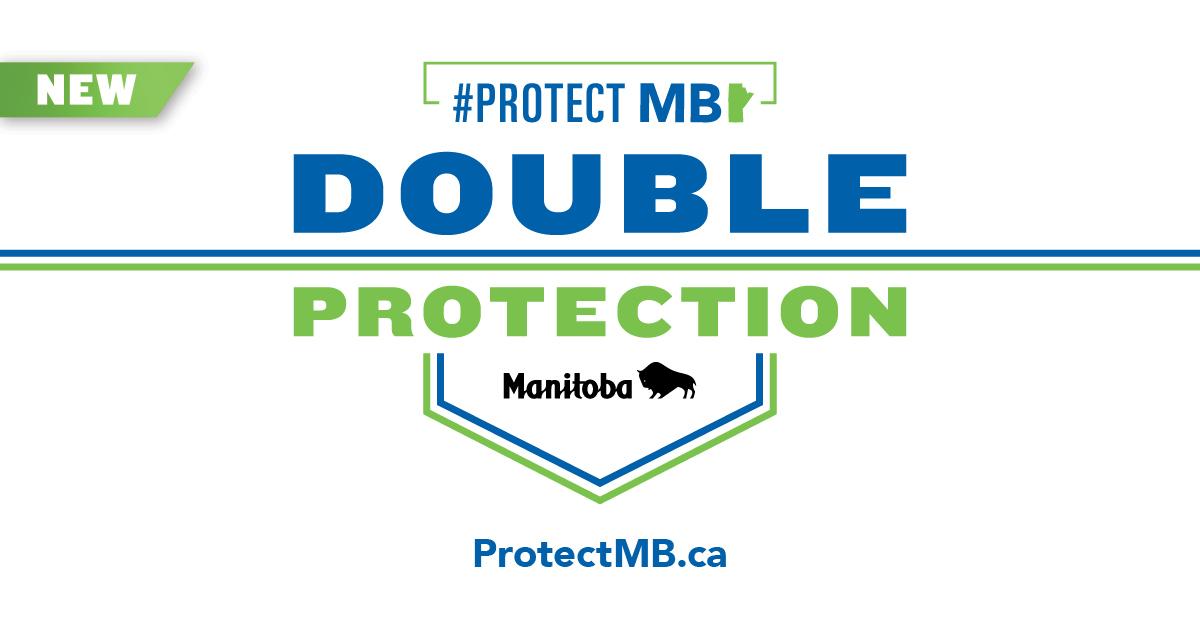
• Vaccination data: www.health infobase.canada.ca/covid 19/vaccination coverage
• Testing information: www.manitoba.ca/covid19/testing/index.ht ml
(October 12, 2022 News Release) Public Services and Procurement Canada (PSPC) wishes to advise motorists to expect delays on the bridge at the St. Andrews Lock and Dam for snow removal during periods of snowfall.
Motorists are presently restricted to a single lane of alternating traffic due to the bridge deck replacement project. In the event of a snowfall, this lane will be closed for periods of up to 30 minutes to allow vehicles and equipment to clear the bridge of snow.
Motorists will be stopped at the traffic control lights at either end of the bridge during snow clearing, and the pattern of alternating traffic will resume once this work has been completed. Motorists should consequently expect delays during and after periods of snowfall.
The bridge will remain open to cyclists and pedestrians during these periods, but they can expect minor delays during snow clearing.
PSPC encourages users to exercise caution when travelling on the bridge and thanks them for their patience.
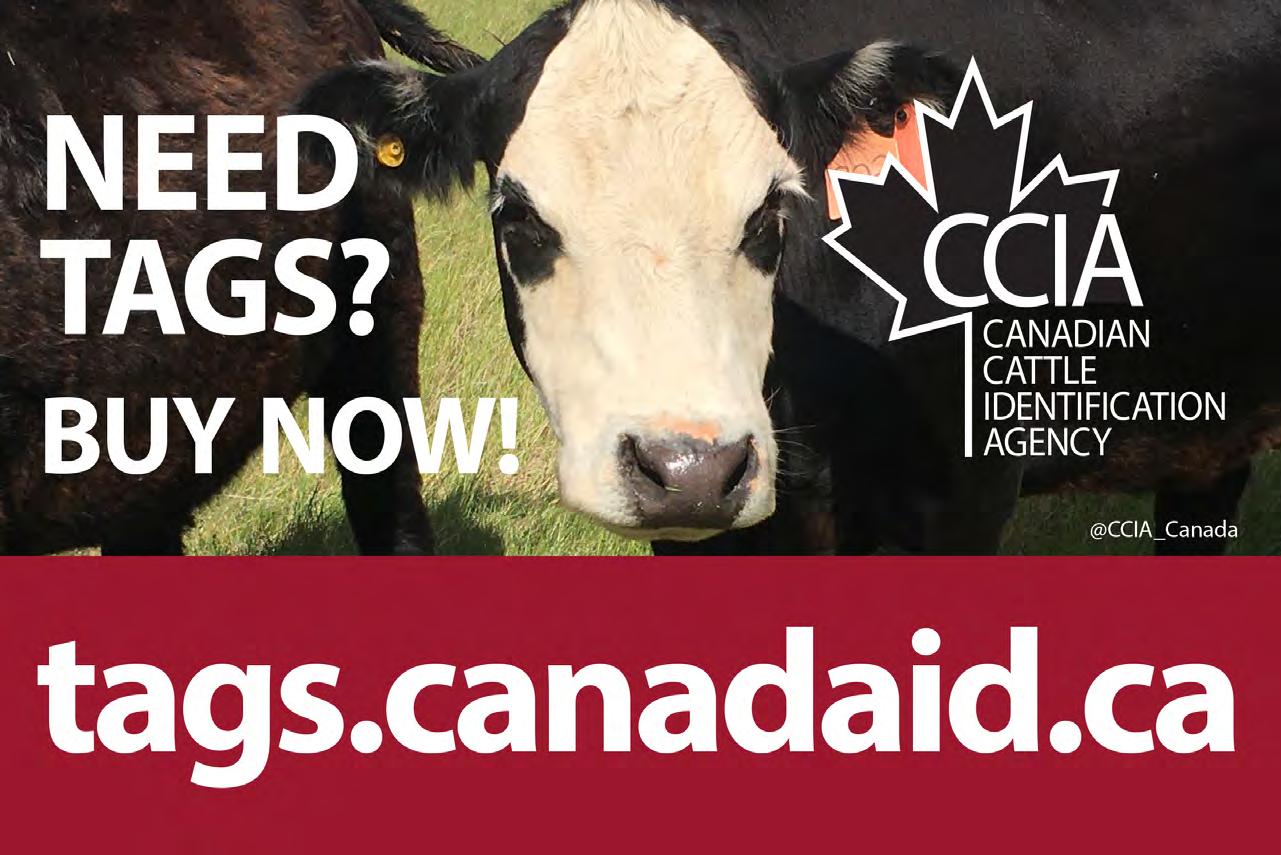

There was a minimal increase in this category of 1% (932 to 937), while Persons reported Missing increased the most, up by 22% (73 to 89), followed by Wellbeing Checks up by 12% (133 to 149). Decreases were noted in Breach of Peace down by 21% (186 to 147) along with Assistance to General Public, down by 6% (185 to 174).
East District: 5% (7,239 to 7,595)
West District: 7% (5,092 to 5,441)
North District: 10% (7,093 to 6,363)
Overall, the districts’ occurrence counts (combined) decreased by less than 1% (from 19,424 to 19,399), with Manitoba North District experiencing the largest decrease of 10% and Manitoba West District having the largest increase of +7%.
All districts reported increases in Crimes against Property. The largest category increase occurred in Drug Enforcement in the West District, while the largest decrease occurred in Common Police Activities in the North District.
For a listing of the communities served by each District, please visit: https://www.rcmp grc.gc.ca/mb/stats/districts eng.htm.
This category had a minimal decrease of 3% (463 to 451), with the largest decrease seen in Sexual Offences, which were down by 55% (58 to 26). The largest increase occurred in the Robbery/ Extortion/ Harassment/ Threats sub category which was up by 36% (118 to 161).
Crimes against Property was up 28% (889 to 1139), with the largest increase occurring in Theft over $5000 up 101% (74 to 149), followed by Arson up 100% (3 to 6) and Break & Enter next, up by 68% (80 to 134).
Drug Enforcement decreased by 41% (54 to 32 occurrences); more specifically, Trafficking was down 45% (from 33 to 18 occurrences) and Possession went down 33% (18 to 12).
During August 2022, Manitoba East District reported an increase in the Crimes against Property category, over the same period in 2021. The following increases and decreases are being highlighted:
During August 2022, Manitoba West District reported increases in three sub categories and no change in the fourth, over the same period in 2021. The following increases and decreases are being highlighted:
(October 7, 2022 RCMP News Release) Calls for Service August 2021 to August 2022:Overall the category increased by 19% (646 to 771) with Breach of Peace reporting the largest increase, up 24% (129 to 160 occurrences) and Wellbeing Checks up by 20% (101 to 121) and Suspicious Person/Vehicle/Property also up 20% (275 to 330).
There was relatively no change overall in Crimes against Person reporting 0% (335 to 336 occurrences).
This category increased overall by 44% (646 to 928); of note, Theft under $5000 was up 81% (141 to 255 occurrences) and Break and Enter increased 64% (78 to 128), as well as Arson, which was also up 64% (11 to 18), with Theft over $5000 next, up by 39% (71 to 99).
Drug Enforcement was up 53% overall this month over the same time last year (30 to46 occurrences), with Trafficking increasing 58% (19 to 30) and Possession increasing 40% (5 to 7).
three other categories. The following increases and decreases are being highlighted:
Common Police Activities decreased by 36% overall (1103 to 704), with Breach of Peace down 50% (549 to 274), and Persons reported Missing down 49% (222 to 114). The largest increase occurred in Suspicions Person/Vehicle/Property up 14% (86 to 98).
There was an overall decrease of 17% (1145 to 946 occurrences), with Forcible Confinement down 46% (13 to 7) and Sexual Offences down 31% (74 to 51).
This category had an overall increase of 15% (1176 to 1354) with the highest sub category increase occurring in Mischief, up 22% (889 to 1086). Possession of Stolen Goods decreased by 38% (13 to 8), and Arson was down 10% (20 to 18 occurrences).
Overall, Drug Enforcement decreased by 30% (47 to 33), with the largest decrease in Possession, down 75% (8 to 2), and then Trafficking, down 32% (34 to 23).
During August 2022, over August 2021, Manitoba North District reported an increase in Crimes against Property but decreases in all
The complete statistics can be found here: https://www.rcmp grc.gc.ca/mb/stats/index eng.htm.
Name(s): Farm Name: Address:
Phone: Email: PLEASE ATTACH A WORD DOCUMENT WITH THE FOLLOWING INFORMATION:
1. Provide a description of your farm including the environment it operates in.
2. What have you done/what are you doing to improve environmental management on your farm?
3. What are your challenges and successes? Please include high-resolution images and data which help show measurable results.
4. What factors have enabled you to make management changes? (e.g. Working with conservation organizations, programs such as the Environmental Farm Plan, funding support, education, etc.)
5. What are your environmental goals for the future and how do you plan to carry them out?
6. Include two letters of reference that speak to your leadership in conservation.
Please limit your application to 10 pages (not including letters of reference and photos). Electronic applications are preferred and a single, complete PDF document is requested. A sample application from previous years can be found online at https://www.cattle.ca/sustainability/theenvironmental-stewardship-award/how-to-nominate/

Contact your provincial organization listed on the previous page to determine when your association requires you to submit your application for the provincial award.
A selection of no less than ten high-resolution images suitable for reproduction on social media, print etc.
Video presentation link if available, media stories/ broadcasts showcasing your stewardship efforts.
TESA sponsorship program is available to appropriate organizations that wish to affiliate themselves with the CCA’s TESA program. In addition to showing support for environmental stewardship and Canada’s beef cattle producers, the program also provides the opportunity to join industry leaders, government representatives and nearly 60,000 Canadian beef farms in the national discussion on environmental issues affecting the industry. For more information, visit www.cattle.ca/what-is-tesa



For more than 65 years, MNP has been helping beef producers get the most from their operations. Whether you are looking to pass the farm on to the next generation, improve your profitability, be more competitive or expand MNP’s beef industry specialists will help you get the results you’re looking for. To find out what MNP can do for you, contact Marvin Slingerland, Partner, MNP Lethbridge, at Director of Livestock Services at 1.800.661.8097 or Marvin.Slingerland@mnp.ca

Safely dispose of unwanted or obsolete agricultural pesticides and livestock/equine medications –no charge! Take them to the following locations on the dates noted between 9 a.m. and 4 p.m.
ARNAUD
Thursday, Oct. 27 G J Chemical Co. Ltd. 96 Smith Ave West 204-427-2337
BALDUR Friday, Oct. 28 Baldur Agro 121 2nd St 204-535-2598
BEAUSEJOUR
Wednesday, Oct. 26

Nutrien Ag Solutions 73010 Road 40 off Hwy 44 SE 10-13-7E 204-268-3497
BRANDON Thursday, Oct. 27 Richardson Pioneer 14 km west on Hwy 1, then 1/4 mile south on Pioneer Rd. 204-727-5353
BRUNKILD
Monday, Oct. 24 MK Agro 3062 Road 39 NW 204-736-4769
DAUPHIN Monday, Oct. 24 Dauphin Co-op AGRO 601 Whitmore Ave E 204-622-6080
DELORAINE Monday, Oct. 24
Nutrien Ag Solutions Hwy 3 & Broadway St. S 204-747-2877
GLADSTONE Monday, Oct. 24 Neepawa-Gladstone Coop Road 69, Hwy 16 (4 miles W of Gladstone) 204-385-2906
INGLIS
Wednesday, Oct. 26 Prairie Giants Crop Supply 2 km East of Hwy 83 on PR 366 204-564-2293
MEADOWS
Thursday, Oct. 27 Ag Advantage Ltd 68156 Road 6 W 204-322-5351
MELITA
Tuesday, Oct. 25 Cargill 7 km SW of Melita on Hwy 83 204-522-3221

PORTAGE LA PRAIRIE Friday, Oct. 28 Portage Agri-Sales 11 Can-Oat Dr 204-857-7838
RIVERS
Friday, Oct. 28 Redfern Farm Services 102 2nd Ave 204-328-5325
SHOAL LAKE Thursday, Oct. 27 Shur-Gro Farm Services Ltd. 236 Industrial Park Rd. 204-759-4240
ST. LEON Tuesday, Oct. 25 Pembina Coop 49079 Road 25N 204-744-2850
STANLEY Wednesday, Oct. 26 Cargill 12137 Road 25W 204-325-9551
STEINBACH
Friday, Oct. 28 Clearview Coop 33124 Road 39 N (at Hwy 12N, between Steinbach and Blumenort) 204-326-9921
SWAN RIVER Tuesday, Oct. 25 Cargill 2 miles south on Hwy 83 204-734-5747
TEULON
Tuesday, Oct. 25 Willis Agro 11034E Road 95N 204-461-0386
VIRDEN Wednesday, Oct. 26 Core Ag Inputs 320 Chester St. E 431-763-3536

Manitoba Agriculture staff will lead free workshops on how to search and find the information you need on the Manitoba Agriculture website. Learn how to:
• find financial assistance information
• fill out online applications
• save, attach and email online applications
• navigate through the site in general
Evening workshops run from: 5 p.m. to 6:30 p.m. or 7 p.m. to 8:30 p.m.
Tue, Nov 8, 2022 Gimli, MB
East Interlake Watershed District Office, 74 First Ave
Thur, Nov 10, 2022 - Ashern, MB
Fieldstone Ventures Education, 61 Main Street.
Tue, Nov 15, 2022 - Swan River, MB
Swan Lake Watershed District Office, 559 4th Ave N.
Thur, Nov 17, 2022 - Inglis, MB
Assiniboine West Watershed Office, Building 211, P.R.# 366.
Mon, Nov 21, 2022 - Virden, MB
Virden Provincial Building, 247 Wellinton Street W.
Wed, Nov 23, 2022 - Deloraine , MB
Souris River Watershed Distict Office, 102 Broadway St. S.
Fri, Nov 25, 2022 Holland, MB
Redboine Watershed District Office, 109 Broadway Street.
Tue, Nov 29, 2022 Carberry, MB
MB Crop Dive rsification Centre, Jct of Hwys #1 and #5, N on #5.
Thur, Dec 1, 2022 - Vita, MB
RM of Stuartburn Office, 108 Main St.
Wed, Nov 9, 2022 Lundar, MB
West Interlake Watershed District Office, 9 Main Street.
Mon, Nov 14, 2022 - The Pas, MB
The Pas Provincial Building, 3rd St and Ross Ave
Wed, Nov 16, 2022 - Ethelbert, MB
Inter-Mountain Watershed District Office, P.R. # 274.
Fri, Nov 18, 2022 - Minnedosa, MB Minnedosa United Church, 48 Main St. S.
Tue, Nov 22, 2022 - Reston, MB
Souris River Watershed District Office, 4th St & 4th Ave.
Thur, Nov 24, 2022 - Manitou, MB Pembina Valley Watershed District Office, 261 Main Street.
Mon, Nov 28, 2022 - Ochre River, MB Ochre River Community Hall, 401 Mann St

Wed, Nov 30, 2022 - Carman, MB MB Agriculture Carman, 65 3rd Ave NE.
Fri, Dec 2, 2022 - Steinbach, MB Roadhouse 52, 375 N Front Dr unit b
Registration is required as spaces are limited. For more information or to reserve your preferred location and time, call 1-844-769-6224, or email agriculture@gov.mb.ca
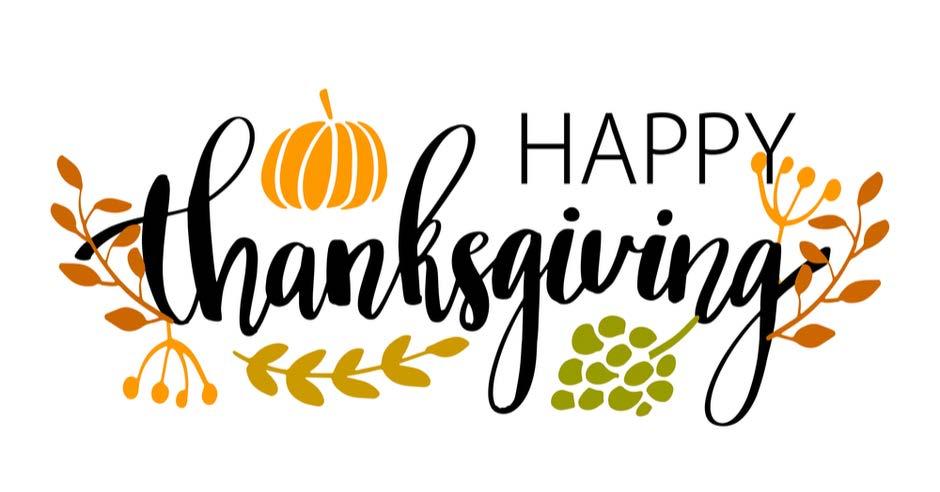
An
from MBP October 7, 2022 mbbeef.ca

The government has expanded its inter-provincial agreement with the Western College of Veterinary Medicine (WCVM) at the University of Saskatchewan to provide increased annual funding for the acceptance of an additional five Manitoba students beginning in 2023-24, as part of its strategy to build the province’s animal health-care capacity.
(October 7, 2022 Province of Manitoba News Release) The Manitoba government has finalized further details of its new plan to attract, train and retain veterinarians to support commercial agriculture in rural areas, Agriculture Minister Derek Johnson announced today.

“Our government has invested in this new strategy to address the critical shortage of veterinarians providing care for commercial livestock and poultry operations in rural Manitoba,” said Johnson. “The agricultural sector is vital to our provincial economy and we are committed to providing support to address the sector’s needs.”
Manitoba currently receives 15 guaranteed subsidized seats at the Saskatoon-based WCVM for new entrants annually. The province will increase its funding contribution to WCVM by $539,200 for the 2023-24 academic year to a total of $7,009,600, raising the number of Manitoba intake students to 20 from 15 and to a student quota the number in the four years of the program to 65 from 60. The province’s gradually increasing funding commitment will bring its intake to 20 seats from 15 seats every year until it supports 80 Manitoba students annually through the four-year program.
Given the particular need for veterinarians to support commercial livestock and poultry operations in rural Manitoba and for improved biosecurity, the five new intake seats will be targeted for an expansion of veterinary care for the agricultural sector.
Manitoba Agriculture will work closely with WCVM to attract and select students with the rural background, knowledge and passion to become successful as veterinarians who will return to rural Manitoba to support the livestock and poultry industries.
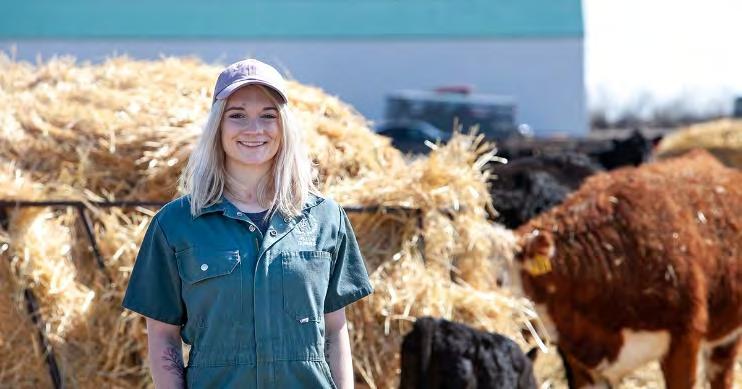 Photo credit: https://www.facebook.com/WCVMToday
Photo credit: https://www.facebook.com/WCVMToday
•
• SERVICES: Whetheryouareaspecialtyproducerlookingtoget yourproducttoaspecificmarketordistributor,orifyouareproducing commoditylivestockforsale,wecanpartnerwithyou.Fromour multi-speciescapabilitiestoourabilitytohandlesmallervolumes,we offerexcellentcapabilitiesforproducersintheCanadianPrairiesto maximizetheirprofitability.

• FACILITY: Wehaveastate-of-the-artfacilitytoallowusto reachmarketsacrossCanada,theUSA,andbeyond.Weunderstand producer'sneeds,theircarefortheiranimals,andtheirhonest, straightforwardnature.Callustohearhowwecanworktogethertoget yourproducttomarket.

www.truenorthfoods.ca
 GRASSFED: "TrueNorthFoodsispartneredwithA&WCanada tosupplyCanadiangrassfedbeefforA&Wsgrassfedburgerprogram.
GRASSFED: "TrueNorthFoodsispartneredwithA&WCanada tosupplyCanadiangrassfedbeefforA&Wsgrassfedburgerprogram.
Along with these attributes, students who are selected will be expected to have:
• an expressed desire to pursue veterinary practices in commercial agriculture in rural Manitoba;
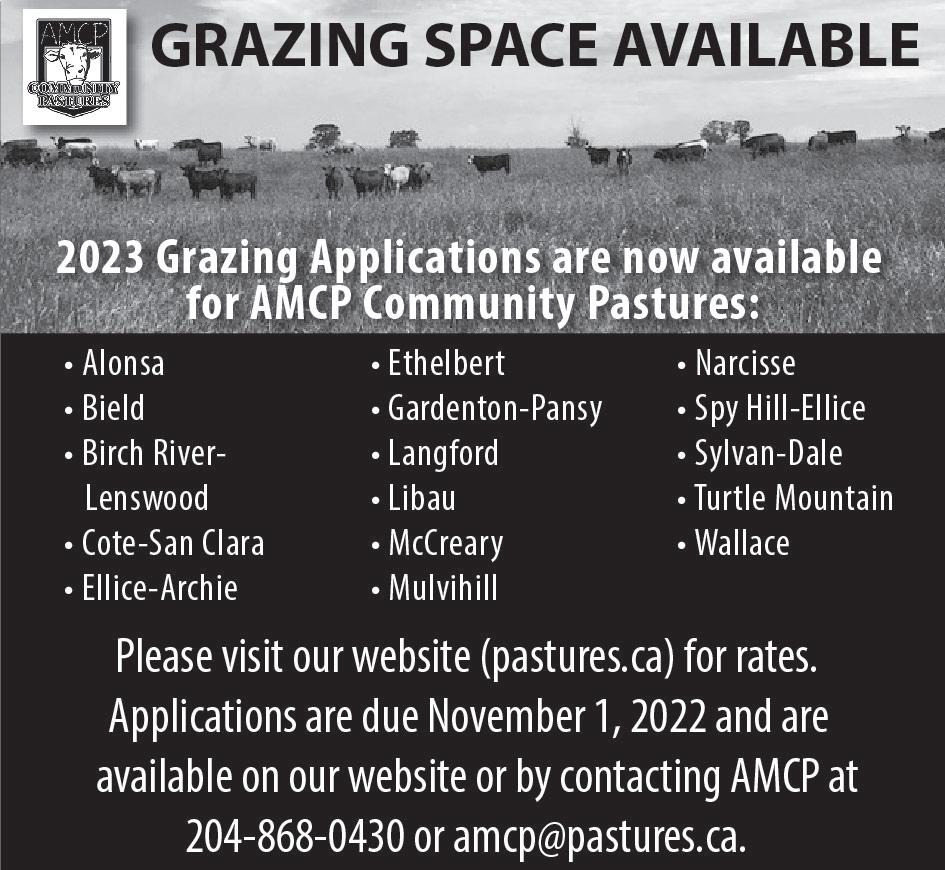
• a solid academic foundation through achievement in a university level animal science program; and
• practical knowledge and experience in the livestock or poultry industries, gained through significant experience prior to enrolment.
“Our government will collaborate with stakeholders and WCVM in upcoming years to ensure the objectives of this targeted approach are met,” said Johnson. “Manitoba Agriculture will also work with educational institutions, agricultural organizations and other
stakeholders to ensure information on the new strategy is shared widely.”
More technical criteria for the new intake seats will be developed for 2024 25 and beyond, Johnson added.
“This is an important step toward addressing the shortage of veterinarians in rural Manitoba,” said Tyler Fulton, president, Manitoba Beef Producers. “We appreciate the focus on recruiting students who have a direct interest and first hand experience in working with animals, and who have been raised in a rural environment. We thank the provincial government for its investment in training more vets.”
In addition, Manitoba Agriculture is exploring options to work collaboratively with the industry to further support these efforts to address its labour market needs, Johnson said.
The success of the Canadian beef industry lies in the strength of its next generation. Today's young leaders are actively contributing to the climate change solution, building a legacy for future successors, and continuously looking for ways to enhance resiliency and drive growth in Canada'sbeefcattlesector.
We are pleased to share that beginning October 3, 2022, the Canadian Cattle Association's (CCA) two industry-leading youth development programs will be known by new names. These names will further align the programs with CCA, where the addition of "Canadian" strengthens ournationalidentifywhentheseyoungleadersrepresentourindustryontheworldstage.

Canadian Cattle Young Leaders (CYL) welcomes young people ages 18-35 across Canada, involved in various aspects of the beef supply chain, to be paired with an industry leader in their specific area of interest for a nine-month mentorship. The program also offers unique domestic and international beef industry learning and travel opportunities. Through mentorship, networking and travel, the Canadian CYL Program acts as an industry succession planning tool to equip the next generation of leaders with the skills and tools they need to continue to drive the growth and profitability of the Canadian beef industry. Since established by the Canadian Cattle Association in 2010, the program has seen over 160 CYL graduates.
Applications are open annually for ages 18-35 on our website from January - March.
www.canadiancattleyoungleaders.ca
Follow us on social media at @CdnCYL
The Canadian Cattle Youth Council represents the next generation of beef farmers and ranchers across Canada as a subsidiary of the Canadian Cattle Association and welcomes young beef enthusiasts between the ages of 18-40. The vision of the council is to cultivate youthful leadership by exposing young delegates on the council board to industry policy development, while creating opportunities to gain experience and bring fresh ideas to the Canadian Cattle Association and Canadian beef cattle industry. The council also strives to be a conduit of information between industry organizations and the youth of the beef industry.
Ages 18-40 can sign up for FREE as a member of the Canadian Cattle Youth Council on our website.

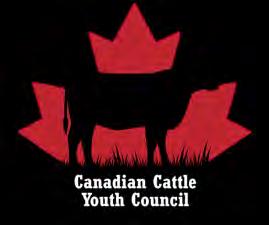
www.canadiancattleyouthcouncil.ca
Follow us on social media at @CanCattleYouth

If you prefer, a hard copy of the survey is also found in this edition of the MBP e newsletter, along with a backgrounder on the program and changes made to it in recent years
Please mail hard copies of the completed survey to: Manitoba Agriculture
ATTN: Marnie Carey
Producers are reminded that the Manitoba government has announced a consultation related to the Agricultural Crown Lands (ACL) Program and forage leases as part of is continuing review of the program.
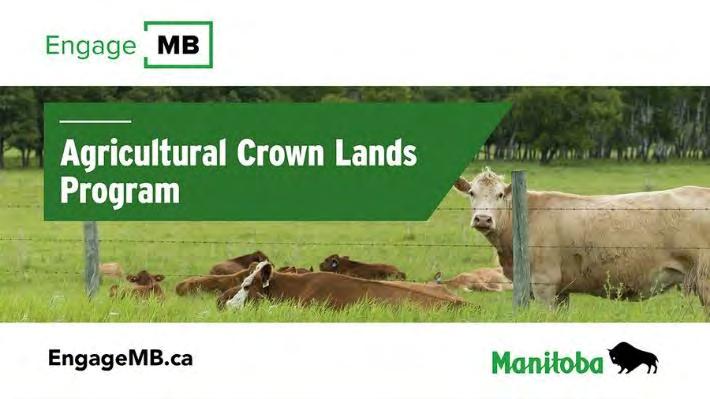
As per the province’s September 28 news release, “Manitoba Agriculture is exploring other policy, program, regulation and service improvements to enhance the productivity and sustainability of agricultural Crown forage lands including mechanisms for leaseholders to invest in productivity and adjustments to the terms and conditions of leases.
To participate in the online version of the survey visit http://engagemb.ca/agcl forage leases.
816 401 York Ave Winnipeg, MB R3C 0P8
As noted, the online survey closes on October 28, 2022, and have your hard copies of it mailed to the department by October 28 as well
To read the news release where this consultation was announced (and which also refers to the provincial government implementing a temporary three year rent reduction for forage leases on agricultural Crown lands commencing in 2023) go to: https://news.gov.mb.ca/news/index.html?item =56479&posted=2022 09 28

Manitoba Agriculture has heard from forage lease holders through their letters and through various meetings. Several concerns were raised about rents, lease terms and conditions, land productivity, and programs/services. The following discusses current policies on ACL.
Forage rents are calculated using a market based formula in regulation: 3.5% of the market price of beef x the number of cows that the land can sustain (i.e. “animal unit months”, or AUMs, which is a measure of the productivity of the land). Forage lease rent is A x B x 3.5% (where A = AUM, B = price of cattle).
Previously, rents were frozen at artificially low rates since 2014, at about $2/AUM, and were based on a triennial survey. Lessees are currently paying $7.19/AUM, or about $48 for 5 months of feed per cow calf pair (for reference Saskatchewan 2022 grazing rates are $8.18 per AUM).
Rental rate transition: In 2019, the rental rate remained at $2.13 per AUM. In 2020, the rental rate was the average of the 2019 rate and the amount described in the formula. In 2021 and thereafter, the rent is determined using the formula. In addition, rent is now payable by December 31, rather than at the end of the production year as had been the practice in the past.

Forage lease terms are 15 years. Those who had forage leases prior to 2019 (i.e. “legacy leaseholders”) can transfer their lease to immediate family members only in perpetuity. For partnerships and corporations, leases obtained prior to 2019 can be transferred to an existing ownership interest in the partnership or corporation in perpetuity.
Leaseholders may surrender their lease at any time without penalty. Surrendering only a portion of a lease can be considered on a case by case basis, depending on the land use impacts and other considerations.
Lifetime leases can no longer be transferred to a third party. This is called a unit transfer. Typically, this involves the transfer of a lifetime ACL lease along with the sale of a farmer’s private property to a non family member. However, those with forage leases prior to 2019 may transfer their leases to immediate family members in perpetuity.
AUM ratings are long term production averages. AUMs are not adjusted annually and are generally conservative. Lands are assessed for AUM using scientific methods based on region, soil type, type of vegetation and other conditions. AUM assessments are always conducted prior to Crown land auctions. Forage lessees are expected to manage the land to maintain or increase long term productivity. AUMs are not adjusted downward if leaseholders are not actively maintaining the land, including controlling encroachment. AUMs are a key part of rent calculations: rent is calculated as 3.5% of the market price of cattle per AUM.
When leaseholders make investments to improve ACL productivity, by policy, Manitoba will not increase AUM assessments on those lands for 10 years.
The 2021 ACL Forage Productivity Pilot Program (ACLFPPP) (75% government funded and 25% applicant funded) funded projects related to forage management techniques to improve productivity and sustainability on Crown land. ACL productivity improvements resulting from the ACLFPPP may not be reflected in AUM assessments for 5-10 years, meaning rents would not be increased due to the improvements. In the pilot, any improvements are owned by lessees. Many years ago, Manitoba offered a Crown Land Improvement Program (CLIP) for leaseholders to develop Crown lands for the purposes of cattle production. CLIP acres are a large part of existing ACLP lands. AUMs on CLIP acres are assessed based on their productivity potential; the onus is on the leaseholder to maintain productivity, for example by limiting encroachment. In cases where the land has not been adequately maintained over the years, resulting in the need for significant redevelopment, there can be delays for the permissions required from the Department to complete this type of work, due to the need for consultations and permits.
The value of improvements on forage leases is settled privately between outgoing and incoming leaseholders within 30 days of the auction. If agreement cannot be reached, the matter is referred to formal arbitration under The Arbitration Act. This is a new system that is relatively untested.
In situations where a leaseholder walks away from a lease and improvements, and they revert to the Crown, the value is known prior to the allocation process, and the value is paid to the Crown at the time of allocation.
Auctions are held in November, in the year prior to use, for various locations throughout the province, with advertisements placed in local newspapers and online, at least 30 days prior to the auction date. Payments must be made in full at the auction, including all of the first year’s rent and local taxes, and any other fees that may be known for the parcel of land.
The Department moved to online auctions during the pandemic. Sometimes, releasing the list of land to be auctioned is delayed due to the department’s generous cancellation policy for non payment. Cancelled and surrendered leases are put on the notification list to First Nations for Treaty Land Entitlement selection prior to auction.
Are you an active AGL forage lease holder? (Choose anyone option)
Did you obtain your forage lease prior to 2019? (Choose anyone option)
Have you ever held an AGL lease? (Choose anyone option)
Do you intend to hold an AGL lease at some point in the future? (Choose anyone option) D Yes


Rent: Forage lease rents are based on a formula that includes the productivity of the land (i.e AUM) and the 3 year average price of beef Specifically , rent is calculated as 3 5% of the 3 year average price of cattle for each cow/calf pair
Lease : Subletting a forage lease (or transferring a lease to someone else) is currently allowed under special circumstances
Which of the following options would you prefer to determine forage lease rents :
(Choose any one option)
D The current formula based on productivity of the land and the 3 year average price of beef. D Rent set by bid at auction (no formula) with an annual inflationary adjustment. D Don'tknow D Other
Answer this question only if you have chosen Other for Which of the following options would you prefer to determine forage lease rents :
Please specify :
Do you support allowing lease holders to sublet (or transfer) a lease to someone else?
(Choose any one option) D Yes 0 No Answer this question only if you have chosen Yes for Do you support allowing lease holders to sublet (or transfer) a lease to someone else?

Should leaseholders be allowed to sublet (or transfer) a lease under any circumstance, or only special circumstances?
(Choose any one option) D Lease holders should be able to sublet (or transfer) a lease at any time for any reason D Lease holders should only be able to sublet (or transfer) a lease under special circumstances D Don 'tknow
Answer this question only if you have chosen Lease holders should only be able to sublet (or transfer) a lease under special circumstances. for Should leaseholders be allowed to sublet (or transfer) a lease under any circumstance, or only special circumstances?
Please specify :
Agricultural Crown lands under a forage lease must be actively managed to maintain productivity (i.e AUM ratings must remain consistent over time), which is a requirement of the lease agreement.
To what degree do you understand how the department determines productivity (or AUM ratings) of the land? Check one : (Choose any one option) D Completely understand how MB AGR determines productivity (or AUM ratings) D Somewhat understand how MB AGR determines productivity (or AUM ratings) D Do not understand how MB AGR determines productivity (or AUM ratings)
Answer this question only if you have not chosen Completely understand how MB AGR determines productivity (or AUM ratings) for To what degree do you understand how the department determines productivity (or AUM ratings) of the land? Check one : What could we do to help you understand the process better? Please check all that apply (Choose all that apply) D Training courses or webinars D Printed materials, like a guide book

Through your commodity association
In person through our AGR representative
How likely would you be to invest in productivity improvements (for example , cross fencing, watering systems, rejuvenating forage stands , managing bush encroachment) if :
Very Somewhat Neitherlikely or Not very Not at all Questions likely likely unlikely likely likely
If your leaseterm could be extended to 20 years (from the current 15 years)
If the province shared in the cost of the improvements
If the province owned the improvements afterward
If there was predictability on the market value at the end of the leaseterm
If the province provided extension servicesto help develop long term management plans
If subletting (ortransferring alease) were madeavailable/easier

For those lease holders who mismanage the land in contravention of the lease that results in a decline in productivity , what would be a reasonable consequence to the lease holder? (Choose any one option)
Cancellation of the lease
Other Answer this question only if you have chosen Other for For those lease holders who mismanage the land in contravention of the lease that results i n a decline in productivity, what would be a reasonable consequence to the lease holder? Please specify :
After an auction, the current process of transferring the crown land improvements from the outgoing lease holder to the incoming lease holder is a negotiation between the parties If a reasonable price cannot be agreed to by negotiation, the parties may go to formal arbitration via The Arbitration Act.
Have you ever participated in this process of negotiating a price to transfer the improvements?
(Choose any one option) D Yes 0 No
Answer this question only if you have chosen Yes for Have you ever partic ipated in this process of negotiating a price to transfer the improvements?
Were you the incoming or outgoing leaseholder?

(Choose any one option) D Incoming D Outgoing
Answer this question only if you have chosen Yes for Have you ever partic ipated in this process of negotiating a price to transfer the improvements?
How satisfactory was the outcome?
(Choose any one option) D Very satisfactory D Somewhat satisfactory D Somewhat unsatisfactory D Not at all satisfactory D Don'tknow
Answer this question only if you have not chosen Very satisfactory for How satisfactory was the outcome? Why was the outcome not satisfactory?
There are several ways that improvements to crown land could be valued to determine a price between outgoing and incoming lease holders Of the below options, please rank your preference :
{Rank each option)
__ Third party appraisal of the market value before auction
__ Third party appraisal of the market value after auction
__ Standard listing of values which would determine in advance the price to be paid for the improvements.
__ The current process of negotiation
__ The value of the listed improvements should be determined by bid at the auction
Are there additional options that should be considered that are not specified in the question above?

Customer Service
A list of land that will be available for auction are typically released in October. Auctions for AGL are typically held in November. Forage lease rent invoices are sent to lease holders in November with rent due in December. Some farmers have said they would like to see a land listing for auctions sooner to allow time to inspect the land for which they may choose to place a bid. In some cases, land listings are delayed due to the department's generous non-payment policy. In the case of non payment of rent, how much time should lapse before a forage lease is cancelled? (Choose any one option)
1 month
2 months
3 months
4 months
5 months
6 months
More then 6 months How well do you understand your annual rent invoice? (Choose any one option)
Fully understand the invoice
Somewhat understand the invoice.
Don 't understand the invoice Answer this question only if you have chosen Don't understand the invoice . for How well do you understand your annual rent invoice? Why do you not fully understand the invoice Please check all that apply (Choose all that apply)
Terminology is complex
Too much information
Not enough information
You don 't read the invoice
Other Answer this question only if you have chosen Other for Why do you not fully understand the invoice Please check all that apply Please specify How do you want to receive information on programs and services related to the AGL? Please check all that apply (Choose all that apply)
Through your commodity and/or farm association



How often do you communicate with your Department of Agriculture representative?
(Choose any one option) 0 Weekly 0 Monthly D 2-3 times per year
Once per year
Less then once per year
How interested would you be in working with a Department of Agriculture representative to develop long-term management plans for your ACL?
(Choose any one option) D Very interested
Somewhat interested
Neutral/don't know
Not very interested D Not at all interested


(October 6, 2022 Joint Federal/Provincial News Release) Manitoba producers will receive higher Excess Moisture Insurance (EMI) coverage levels as part of the AgriInsurance program for the 2023 crop year, federal Agriculture and Agri Food Minister Marie Claude Bibeau and Manitoba Agriculture Minister Derek Johnson announced.
“Extreme weather conditions continue to challenge and threaten the viability of many producers,” said Bibeau. “With the increasing cost of inputs, these enhancements to the AgriInsurance program’s Excess Moisture Insurance will allow for greater coverage in the event of financial losses.”
Basic EMI coverage is a standard feature of the AgriInsurance program that provides protection against the inability to seed due to wet conditions. Producers can choose increased coverage options at higher premiums. Since 2000, basic EMI coverage has been $50 per acre, while higher coverage options increased in 2014 to $75 and $100 per acre. For 2023, basic coverage will increase to $75 with higher coverage options increasing to $100 and $125.
These changes were made in consultation with producer groups that have expressed interest in higher coverage levels due to rising farming costs. The province’s share of premiums for the 2023 EMI program is estimated to be $8.6 million.
Manitoba Agricultural Services Corp. (MASC) reports there were 866,000 unseeded acres in Manitoba this year (approximately eight per cent of the total acres), resulting in estimated EMI indemnities of $53.5 million.
“The excessive moisture during the growing season this year brought extremely challenging conditions for producers across our province,” said Johnson. “The AgriInsurance program exists for them in these kinds of situations. The newly increased coverage provided through Manitoba Agricultural Services Corporation will bring further assistance and relief to those who need it most.”
MASC will send EMI confirmation letters to all existing AgriInsurance clients later this month to reflect the new coverage levels and premiums. Producers have until Nov. 30 to make changes to their EMI coverage for 2023 by contacting a MASC Service Centre.
Under the Canadian Agricultural Partnership, AgriInsurance premiums for most programs are shared 40 per cent by participating producers, 36 per cent by the Government of Canada and 24 per cent by the Manitoba government. Administrative expenses are paid 60 per cent by Canada and 40 per cent by the Manitoba government.
Manitoba Agricultural Services Corporation (MASC) has recently announced that Manitoba producers will receive higher Excess Moisture Insurance (EMI) coverage levels as part of the AgriInsurance program for the 2023 crop year. For 2023, basic coverage will increase to $75 with higher coverage options increasing to $100 and $125. These changes were made in consultation with producer groups who have expressed interest in higher coverage levels due to rising costs of farming. Producers have until November 30 to make changes to their EMI coverage for 2023 by contacting their MASC Service Centre. For more information on Excess Moisture Insurance, please visit masc.mb.ca.

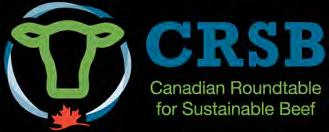
October 4, 2022, Calgary, AB. – The Canadian Roundtable for Sustainable Beef (CRSB) is seeking public input to proposed changes to the standards for sustainable beef production and processing that form the foundation of the Certified Sustainable Beef Framework (the Framework). An online 60 day comment period on the draft updated Standards opens today and runs until December 2, 2022 We encourage all interested parties to provide feedback
The Framework was launched in 2017 to recognize sustainable practices in Canadian beef production and processing, to support sustainable sourcing commitments for the retail and foodservice sector, and to provide credible, science based assurances for Canadian consumers. As part of a scheduled five year program review, and following extensive stakeholder consultation, the CRSB’s Framework Committee conducted an in depth review of each indicator in both standards (beef production and processing), explored areas for improvement, and identified gaps
Proposed changes to the Standards focus on strengthening indicators through monitoring and demonstrating progress, and indicators that align with the 2030 Canadian Beef Goals.
“The engagement of our members and stakeholders during this review demonstrates the commitment across the Canadian beef value chain to continually advance beef sustainability practices, while also aligning with public interest in sustainability”, says Kristine Tapley, Chair of the CRSB Framework Committee. Tapley is the National Sustainability Lead for Ducks Unlimited Canada and a beef producer from Langruth, Manitoba.
“These proposed changes all aim to advance our journey of continuous improvement that is at the heart of the definition of sustainability”, adds Tim Hardman of Fulton Market Group and CRSB Framework Committee Vice Chair. “We look forward to receiving constructive comments on the changes to the Standards, so that we can continually make improvements to our certification framework”.
Consultation documents, including a summary of proposed changes and full proposed updated standards, along with instructions for comments and suggested recommendations can be found on the NSF Online Consultation Workspace. Visit our Public Consultation webpage for further details. 30
The Canadian Roundtable for Sustainable Beef (CRSB) advances, measures and communicates sustainability in the Canadian beef value chain in collaboration with its multi stakeholder membership. It drives continuous improvement through sustainability performance measurement and goals, a voluntary 3rd party sustainability certification program, and projects and initiatives aligned with strategic goals. Learn more at crsb.ca
The Certified Sustainable Beef Framework, known as CRSB Certified, recognizes sustainable practices in beef production and processing, enables sustainable sourcing, and delivers 3rd party certified science based assurances about sustainable beef production in Canada. Learn more at crsbcertified.ca
NEWS RELEASE: CRSB public consultation on updates to Certified Sustainable Beef Framework(October 3, 2022 Canadian Grain Commission News Release) Grain producers will now have more time to ask for a Final Quality Determination from the Canadian Grain Commission in the event of a grain grading dispute on their deliveries into Canadian Grain Commission licensed primary elevators.
Formerly known as “Subject to Inspector’s Grade and Dockage”, producers can now ask that a sample of their grain delivery be sent to the Canadian Grain Commission for a Final Quality Determination for up to seven calendar days after the date of their grain delivery. This right is available for grain producers who deliver a regulated grain into a Canadian Grain Commission licensed primary elevator.
The Canadian Grain Commission has implemented these changes to the Canada Grain Regulations to support fair transactions in the Canadian grain sector. These regulatory updates have been made to reflect and keep pace with the current operational realities of grain handling and delivery in Canada.
The amendments clarify how long samples must be stored and allow more flexibility for producers and elevator operators to decide who will store delivery samples and where. In addition, grain producers will not need to be present at the time of delivery to request a Final Quality Determination.
“We are very pleased to implement these enhancements to Final Quality Determination for grain producers. This important producer right now reflects the realities of today’s grain sector and responds to feedback received during the Canada Grain Act review.”
Doug Chorney, Chief Commissioner Canadian Grain Commission• The Canadian Grain Commission’s consultation on updating grain grading dispute resolution received a total of 13 submissions.
• Grain farmers are now able to request a Final Quality Determination even if they are not present at the time of delivery and for up to seven calendar days after the delivery.
• The regulatory updates allow producers and primary elevator operators more flexibility to agree on who will hold the sample and where.
• The amendments remove the obligation for a sample to be taken in the presence of the person delivering the grain, unless the producer asks to be present.
(Province of Manitoba News Release) The Manitoba government is inviting the public to provide feedback on functional design options for proposed upgrades along Provincial Trunk Highway (PTH) 8, from Provincial Road (PR) 220 to PR 230, Transportation and Infrastructure Minister Doyle Piwniuk announced.
“Upgrades along PTH 8 will improve road safety and better manage traffic volumes,” said Piwniuk. “The feedback we receive through this first round of public engagement will be incorporated into project plans to help ensure the current and future needs of Manitobans.”
The survey is seeking feedback on the following intersections:
• PTH 8 and PR 220 (Grassmere Road) including the east and west service
roads and the future connection of Holmes Road;
• PTH 8 and Northumberland Road;
• PTH 8 and PR 321 (Miller Road);
• PTH 8 and PTH 27 (Parkdale Road); and
• PTH 8 and PR 230 (McPhillips Road).
The survey, which is available until Oct. 20, is also seeking feedback on access management, road alignment and drainage upgrades.
The minister noted the upgrades along PTH 8 are part of the government’s ongoing commitment to building and maintaining a robust grid of reliable highways that support the safe, efficient flow of people and goods.
To complete the survey, visit https://engagemb.ca/login
(October 3, 2022 Government of Canada News Release) Public Services and Procurement Canada (PSPC) wishes to advise motorists that the bridge at the St. Andrews Lock and Dam will be closed to vehicular traffic for deck replacement work during the following period:
• Thursday, October 13, at 7 pm, to Friday, October 14, at 6 am During this period, all lanes will be closed to vehicular traffic in both directions. Motorists are encouraged to consult local electronic signs for the most up to date information.
Travellers are reminded that the bridge will remain open to pedestrians and cyclists. As of October 15, pedestrians and cyclists will be able to cross the bridge using the newly constructed pathway on the north side of the bridge. Cyclists are asked to dismount their bikes when using the walkway.
PSPC encourages users to exercise caution when travelling on the bridge and thanks them for their patience.
(October 5, 2022 Province of Manitoba News Release) The Manitoba government is developing a new $15 million fund to support Indigenous economic development opportunities related to the Lake Manitoba and Lake St. Martin Outlet Channels Project, Transportation and Infrastructure Minister Doyle Piwniuk announced.
The new fund will be administered as a proposal based funding program, open to 39 Indigenous groups (First Nations, Métis and Northern Affairs communities, and Indigenous organizations) involved in the outlet channels project. The fund will be used to support economic development opportunities related to the outlet channels, and reconciliation in alignment with the principles outlined in the Path to Reconciliation Act.
“Our government understands that concrete and constructive actions are needed to advance reconciliation and ensure Indigenous people have a meaningful voice in any decisions that may impact their traditional lands, rights or interests,” said Piwniuk. “This new fund will support the development of Indigenous led economic opportunities and long term economic development in the communities most impacted by the Lake Manitoba and Lake St. Martin Outlet Channels Project.”
The Lake Manitoba and Lake St. Martin Outlet Channels Project involves building two outlet channels, each approximately 23 kilometres long, three bridges and two water control structures, a 24 kilovolt distribution line and adjusting the surrounding highway infrastructure. The outlet channels will improve
water regulation of Lake Manitoba and Lake St. Martin, reduce the likelihood of flooding on both lakes and lower the risk of flood related damages, and disruption to communities in the area.
“We know we must collaborate with Indigenous communities involved in the project in the true spirit of reconciliation to ensure the success of this historic endeavour,” said Indigenous Reconciliation and Northern Relations Minister Alan Lagimodiere. “We look forward to ongoing collaboration to ensure the project aligns with the traditional knowledge and Indigenous understanding of the area to improve flood protection, and increase resilience against climate change for all Manitobans.”
Prior to officially launching the fund, the province will collaborate with Indigenous communities to develop a framework for fund. This framework will be developed in collaboration with Indigenous communities involved in the project. Once the fund is officially launched, an evaluation committee made up of representatives from several government departments will review proposals with the potential to partner with other organizations to provide input to the proposal, identify additional funding sources, and support proposal development and training.
The province expects to share more details about program eligibility, the intake process, and funding agreement requirements in the coming months.
For more about the Lake Manitoba and Lake St. Martin Outlet Channels Project, visit www.manitoba.ca/mit/wms/lmblsmoutlets.
LAKE ST. MARTIN COMMUNITIES: 1. Dauphin River First Nation 2. Lake St. Martin First Nation 3. Little Saskatchewan First Nation 4. Pinaymootang First Nation 5. Dauphin River NAC

LAKE MANITOBA COMMUNITIES: 6. O-Chi-Chak-Ko-Sipi First Nation
Ebb and Flow First Nation 8. Lake Manitoba First Nation 9. Kinonjeoshtegon First Nation 10. Misipawistic Cree Nation
Sandy Bay First Nation 12. Skownan First Nation 13. Keeseekoowenin Ojibway First Nation
LAKE WINNIPEG COMMUNITIES: 14. Fisher River Cree Nation
Peguis First Nation 16. Bloodvein First Nation
7. Norway House Cree Nation
Berens River First Nation
Hollow Water First Nation
Brokenhead Ojibway Nation
Sagkeeng First Nation
Black River First Nation
Poplar River First Nation
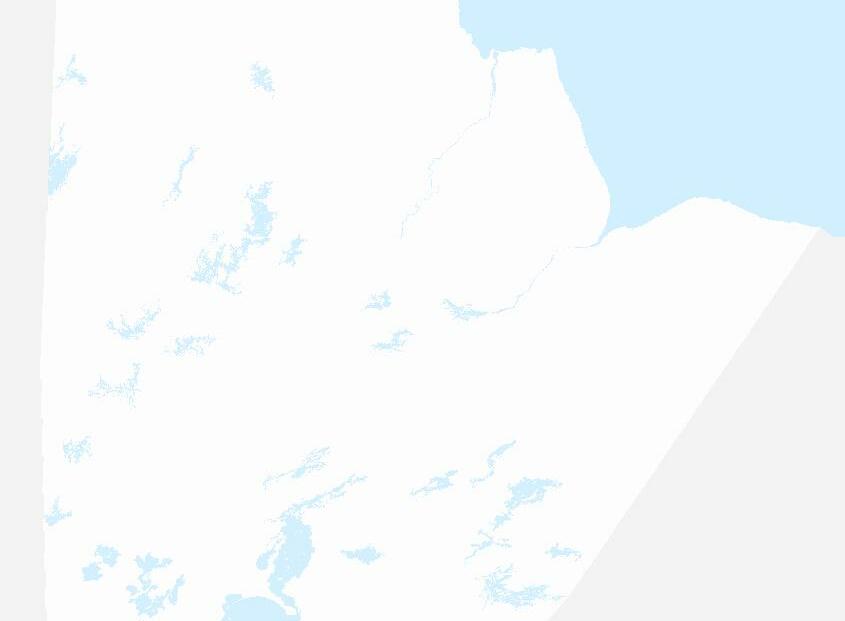
NORTHERN AFFAIRS COMMUNITIES
Aghaming NAC
Berens River NAC
Fisher Bay NAC
Loon Straits NAC
Manigotagan NAC
Matheson Island NAC
Pine Dock NAC
Princess Harbour NAC
Seymourville NAC
Norway House NAC
NELSON RIVER COMMUNITIES:
Fox Lake Cree Nation
Pimicikamak Okimawin (Cross Lake Band of Indians)
York Factory Cree Nation
Tataskweyak Cree Nation
OTHER ORGANIZATIONS:
Manitoba Metis Federation
Council of Chiefs of Anishinaabe Agowidiiwinan (First Nations in Treaty 2 Territory)
and fertilizers to producers. In 2021, farmers returned more than three quarters of the containers sold into the marketplace…more than 2.25 million kilograms, edging up the three year rolling average recovery rate to 77%.
The recycling recovery rate has soared since 2011 when it was 69%. In 2019, it was 71% and in 2020, it was 76%, indicating that producers continue to look for ways they can manage on farm waste materials in an environmentally appropriate manner.

Cleanfarms’ flagship packaging stewardship program that collects empty plastic pesticide and fertilizer containers for recycling continues to gain ground. Cleanfarms released recovery rates for 2021 showing that Canadian farmers returned 77% of the empty 23L and smaller jugs in 2021, edging up from 71% in 2019. Cleanfarms makes large plastic collection bags, shown here, available at ag retailers to make it easier for farmers to safely manage and return empty containers. Cleanfarms photo
ETOBICOKE, ON (October 5, 2022) Canadian farmers/producers continue to demonstrate their commitment to ensuring empty ag product containers used for pesticides and fertilizers are returned for recycling.
Cleanfarms, the national stewardship organization that develops and operates programs to help producers manage on farm agricultural waste materials just released the recovery rates for 2021 for ag packaging of various types that is collected for recycling or safe disposal.
The flagship program recovers empty plastic jugs 23L and smaller that deliver ag pesticides
The recovery rate measures the percentage of containers collected for recycling compared to the number of containers sold into the market in that year. The three year rolling average recovery rate evens out the rate over three years taking into consideration factors that could cause variations such as differing needs due to weather.
“Empty plastic jugs aren’t the only ag containers producers are recycling,” said Cleanfarms Executive Director Barry Friesen. “They are bringing back several essential items used on farms for recycling like empty non deposit bulk drums and totes, too. This recycling program for bulk containers is newer, only a few years old. By returning them for recycling, farmers are ensuring the plastic in both smaller and larger containers is used to make new products in a circular economy. We are grateful that producers are responding to the programs in such a positive way.”
In 2021, farmers returned 54% of the bulk containers sold in the marketplace, or more than 71,000 drums and totes. That’s an increase from 50% in 2019 and 52% in 2020.
Cleanfarms also operates a grain bag recycling program in Saskatchewan established under the province’s The Agricultural Packaging Product
Waste Stewardship Regulations (2016). When it got underway in 2018, it was the only government regulated extended producer responsibility program of its kind in Canada. Since then, Manitoba has established industry responsibility (called extended producer responsibility) on grain bags and twine and PEI has done so on a variety of ag plastics. In June 2022, the Québec government published a new regulation which targets all agricultural plastics. Cleanfarms is operating pilots in Alberta to collect information on grain bag recycling recovery patterns.

Collecting used grain bags in Saskatchewan is growing year over year. In 2018, Cleanfarms recovered 1,257 tonnes of grain bag plastic. In 2021, the rolling three year average recycling recovery rate was 64%, representing more than 2,100 tonnes of used plastic grain bags.
In eastern Canada, farmers also return seed and pesticide bags for safe disposal, as recycling markets are not available yet. Producers in Quebec also return fertilizer bags. In 2017, when the recovery program got underway in earnest, the three year recovery rate was 22%.
“Cleanfarms’ recycling programs are like the ‘blue box’ or ‘blue bag’ for growers. We are working every day to find better ways to deliver these programs conveniently and efficiently to producers so that more of these materials can be returned to be repurposed in the circular economy,” Friesen said.
Materials recovered through Cleanfarms’ programs are processed by small and large companies within North America to form recycled plastic pellets and flake that are recycled into new products such as farm drainage tile, dimensional lumber, lawn edging and agricultural film plastics.
Cleanfarms is a national agricultural industry stewardship organization that contributes to a healthier environment and a sustainable future by recovering and recycling agricultural and related industry plastics, packaging and products. It collects materials for recycling and safe disposal through a network of some 1,500 ag retail and municipal partners. It is funded by its members in the crop protection, fertilizer, seed, animal health medication, and ag plastics industries. It has staff located in Lethbridge, Alberta; Moose Jaw, Saskatchewan; Winnipeg, Manitoba; Etobicoke, Ontario; and St
Phone: Email: PLEASE ATTACH A WORD DOCUMENT WITH THE FOLLOWING INFORMATION:
Name(s): Farm Name: Address:
A selection of no less than ten high-resolution images suitable for reproduction on social media, print etc.
1. Provide a description of your farm including the environment it operates in.
2. What have you done/what are you doing to improve environmental management on your farm?
3. What are your challenges and successes? Please include high-resolution images and data which help show measurable results.
4. What factors have enabled you to make management changes? (e.g. Working with conservation organizations, programs such as the Environmental Farm Plan, funding support, education, etc.)
5. What are your environmental goals for the future and how do you plan to carry them out?
6. Include two letters of reference that speak to your leadership in conservation.
Please limit your application to 10 pages (not including letters of reference and photos). Electronic applications are preferred and a single, complete PDF document is requested. A sample application from previous years can be found online at https://www.cattle.ca/sustainability/theenvironmental-stewardship-award/how-to-nominate/

Contact your provincial organization listed on the previous page to determine when your association requires you to submit your application for the provincial award.
Video presentation link if available, media stories/ broadcasts showcasing your stewardship efforts.
TESA sponsorship program is available to appropriate organizations that wish to affiliate themselves with the CCA’s TESA program. In addition to showing support for environmental stewardship and Canada’s beef cattle producers, the program also provides the opportunity to join industry leaders, government representatives and nearly 60,000 Canadian beef farms in the national discussion on environmental issues affecting the industry. For more information, visit www.cattle.ca/what-is-tesa



For more than 65 years, MNP has been helping beef producers get the most from their operations. Whether you are looking to pass the farm on to the next generation, improve your profitability, be more competitive or expand MNP’s beef industry specialists will help you get the results you’re looking for. To find out what MNP can do for you, contact Marvin Slingerland, Partner, MNP Lethbridge, at Director of Livestock Services at 1.800.661.8097 or Marvin.Slingerland@mnp.ca